Text
Iraq
Fear is described as a distressing emotion aroused by impending danger, evil or pain. Whether the threat is real or imagined, it is the condition of being afraid. I know we all have come to moment in our lives where we feel a wave of anxiety, panic and dread. Often, it strikes like a bullet to the chest or a ten-ton brick to the head. The only true remedy is yourself.
I guess you could say I’ve always been the “black sheep” of the family. One to lean towards risk and adventure over security and comfort. I’ve always been fascinated by stories; non-fiction stories of mountains, heroes and war. Stories that are unbelievable, yet completely true. Stories that inspire and stories that impact. I once read into Operation Neptune Spear, the operation that raided the compound of Osama Bin Laden in Abbottabad, Pakistan. Also, Operation Red Wings which recounted the heroic battle of four Navy Seals in the Kunar Province of Afghanistan against an anti-coalition militia led by Ahmad Shah, an Islamic fundamentalist. But, despite the stories, I had little understanding of the Middle East; a tunnel vision shrouded with war, terrorism and a culture I did not understand. Despite the stories, the adventure had always called to see the center of conflict.
Throughout my entire life the Middle East had been a focus of war. I grew up watching Operation Desert Storm and Operation Iraqi Freedom, where the United States forces conquered Iraq Socialist, Saddam Hussein. Then on September 11, 2001, a series of four coordinated attacks killed 2,996 people and injured over 6,000 Americans. The Islamic terrorist group al-Qaeda conceded to the horrific attack, which kickstarted the “War On Terror” in Afghanistan, turning the Middle East into a region of blur. Obscured by dozens of terrorist organizations, multiple misunderstood religions, a baseless government and civil war.
In 2014, when the “Islamic State Of Iraq and Syria” otherwise known as ISIS, birthed from al-Qaeda, started making headlines, I was overwhelmed and numb to the war. I chose mostly to ignore the headlines and ignore the propaganda. But, in just two years the terrorist organization carried out multiple attacks on the United States, which included the widely publicized beheading of US journalists James Foley and Steven Sotloff. These attacks impossible to ignore and left many people in fear. The United States responded with multiple air strikes and planted their feet firmly in Iraq and Syria against the Islamic State terrorist organization.
When I first learned about the project in Iraq, I felt confused. My initial reaction was clear and defined without knowing a single detail, but I had dozens of questions. Normally, upon learning about an international assignment with Nadus Films, I’m hit with tsunami of excitement, but this was different… I was scared.
Every meeting, phone conversation, text and email was held with the utmost discretion, we couldn’t tell our friends or families without severe delicacy. Over the course of one week, I learned about the project in detail and the people behind it.
*Due to the sensitivity of this project some names, dates and locations have been changed in order to protect the lives of those involved.
Unseen is a non-profit 501(c)3 which provides support for non-governmental organizations (NGOs) to grow. They offer marketing and fundraising to expand the NGO donor base. Nadus Films is a non-profit 501(c)3 which offers storytelling through film and photography. In partnership Unseen and Nadus Films, our job was to support Shai Fund, an NGO led by Charmaine Hedding who provides humanitarian assistance in disaster relief and development situations such as Iraq, Syria, Egypt and Jordan. She has been called the modern day Indiana Jones and Mother Theresa.
In August of 2014, ISIS militants swept through small cities near Mosul, Iraq forcing thousands of innocent people to flee overnight. Among those cities was Qaraqosh, Iraq’s largest Christian city with over 70,000 people. Over the course of two years, ISIS burned churches, destroyed icons and attempted to erase Christianity from Qaraqosh. Young women were put into sex slavery and young men were forced to carry suicide bombs. If they fought, they were tortured and killed.
In October of 2016, the Iraq Army, Peshmerga and the Nineveh Plains Forces pushed ISIS out of Qaraqosh, but all that remained was ruins; a city of ghosts. The homes were pillaged and burned and the people that were forced to flee overnight had been left with nothing. Today, Shai Fund is gifting these persecuted people and providing them a chance to repair after ISIS. Our focus was to shed light on one of the thousands of families, who were finally returning to their war-torn home in Qaraqosh.
With the overview of the project in hand, logistics and security were our largest concern. After our own extensive research, there were so many questions, so many burdens, so many worries.
What is the true situation in Mosul?
Who would provide security on the ground?
Who are our sources on the ground?
What does our travel in Iraq look like?
Where are we staying and for how long?
Where are we most vulnerable in our travels?
Are there IED’s present?
What does our relationship look like with foreign military support while there?
What would an evacuation plan look like?
As American “press” in the Middle East, we have a giant target attached to our back. But, as the answers flooding in, some of our concerns were eased while more concerns were raised. Naturally, the US Department of State stated extreme caution and advised that no American risk travel into Iraq. Kidnapping, sleeper cell suicide bombing and IED’s were all real threats. ISIS had been pushed back to the Syrian border in West Mosul and we would be working some 15 kilometers outside of East Mosul, but it felt to close for comfort.
We would fly from the United States into Erbil, Iraq situated an hour from Mosul and embed ourselves in Ankawa, the Christian community which sat just short drive from the US Controlled airport in Erbil. Unfortunately, the more security we had, the more suspicion would be raised and the more likely we would be considered a target. We had to fly under the radar and blend in. Which was a hard pill to swallow.
We would have a total of three days on the ground, two of which would be spent in Qaraqosh. In order for the mission to be a success, it had to be very short and very hard, with long hours— a timeline Nadus Films and I were very familiar with. We wanted to get in and get the hell out.
While the project was a go, I was personally on the fence and only had three days to make a decision before the flight was booked. During the course of those 72 hours, I tossed and turned at night, had vivid nightmares and battled an inner struggle of unease. I had a lot of emotional support from my close friends, but that didn’t calm my mind from moving a thousand miles per hour and dozens of random thoughts crossing my vision per second. One moment, I would convince myself that I couldn’t risk it. Then, I would sway to other side by persuading myself it would be a decision I would regret. Back and forth, back and forth.
One side was led by fear and the other side was led by determination. Questions were answered, but that didn’t stop my mind from wandering.
Would this open new doors I don’t want?
How will people react?
How will I tell my family?
Am I willing to risk my life for photography?
Coury Deeb, founder and director of Nadus Films, is one of the strongest men I know. Coury has led our team through the swamps and up mountains in dozens of war-torn, poverty-stricken countries all over the world. He has changed the world and he has certainly changed my world.
According to the Foreign & Commonwealth Office, Iraq is one of the most dangerous countries in the world. Therefore, this project was the mecca, an opportunity for Nadus Films to reach an entirely new level of donor base and that is something I couldn’t ignore. Coury’s confidence and calm demeanor throughout the pre-production is what kept me grounded and eventually helped me come to a decision.
Leading up to our decision deadline we had a series of meetings and conference calls. I was taking calls on other productions and on the road. It was discrete chaos, but needed. Our meetings included Nadus Films, Shai Fund, Unseen and two military security advisors; Troy Wilson and Adam Brown. After every call, I either felt calm or anxiety. We walked through all of our questions, including what to wear, how to act, what to expect and where we would be.
At the end of the day, the biggest risk would not be kidnapping, snipers or terrorist action, it would be ourselves. It was important to stay calm in a hectic situation that was completely normal for the Iraqi people. I was confident we had traveled to enough third world countries to respect the process and remain calm in a tensioned zone. With every trip into Qaraqosh, we would face several Peshmerga checkpoints and being American, we would always have eyes on us.
All of our questions were heard and answered, we were going to Iraq.
With the guidance of Troy Wilson, our military security advisor, we were instructed to start growing out our facial hair and start seeking clothing that would blend in. We couldn’t have anything the remotely looked “military” or “special forces” on our person. That included hiking boots, cargo pants, Oakley sunglasses or camouflage wardrobe. We were instructed to wear a tough tennis shoe, button up long-sleeved shirt, cheap sunglasses, blue jeans, with all bold colors and nothing flashy or tight-fitting. No white, no black and definitely no camouflage. We would be recognized as a group of white Americans, but at least we wouldn’t be recognized as a threat.
The next objective was equipment. Due to the nature of airport security and checkpoint security we had to remain completely low-profile. No grip, no tripods, no stabilization, no battery packs and no cases. This meant shedding as much weight as possible and taking only the essentials, the bare bones, the smallest, most efficient camera system possible for both film and photography. We needed a workhorse that would have an extensive battery-life, the ability to withstand extreme weather and most importantly look “less-than-professional.”
After a series of meetings with Nadus Films, our Director of Photography, Drew Layman, decided it be best to use the most reliable camera we know, the Canon 5D Mark IV. But, with video we needed something to stabilize the body and add additional points of contact. Drew suggested the Zacuto Enforcer, a highly portable shoulder mount with a foldable design that makes it ideal for our run-and-gun documentary style. Also, knowing we’d be out in the broad desert daylight we would need the Zacuto Z-Finder Pro Optical Viewfinder. Then, finally we would use the Rode VideoMic Pro to record any sound beyond our wireless lavalier microphone systems.
As far as lenses, we wanted just about every focal length possible. I would solely use the Canon EF ‑ 24mm‑70mm ‑ F/2.8L, while the motion side would rely on the Canon EF ‑ 24mm‑105mm ‑ F/4L, the Canon EF ‑ 16-35mm ‑ F/2.8L and the Canon EF ‑ 70mm‑200mm ‑ F/2.8L. We would also carry a Singh-Ray Variable Neutral Density Filter and Hoya Polarization Filter for each lens.
Once our equipment list was in place, I called upon my friends at Canon and BorrowLenses, who were gracious enough to support the project and provide all the tools we needed.
The largest hurdle for Nadus Films was the drone, we needed arial footage, but Iraq is a no-fly zone. ISIS and other militia use drones to scout and create strategies. DJI claims its impossible to fly, but we researched otherwise. We had to be extremely careful. So, we purchased the new DJI Mavic Pro; a light-weight, pocket-sized drone with a Gimbal-Stabilized 12MP/4K Camera. It was small, powerful and ideal for quick aerial photography. It would be a giant risk, one we were willing to take. Drones being extremely sensitive in the Middle East, there was a specific strategy on the ground, which due to safety I cannot reveal.
The largest hurdle for still photography was lighting. Despite it's small footprint in the photo world, the Profoto B2 system was out. The battery pack and head just attract too much attention, instead I opted for a simple Canon 600EX II-RT speedlight.I needed a very small, soft modifier and a very small monopod. My friends at MeFoto had just introduced the “Walkabout Air” 6-section monopod, which measures only 13 inches when closed; exactly the portability I needed. With only two days before our flight, I still needed a modifier that was small enough to fit in a backpack. So, I called upon Profoto for the smallest umbrella they create; the 33” Shallow White Umbrella with diffusion. Once it arrived, I sawed off the center shaft, gaffed the umbrella tips and clipped the diffusion to the umbrella. It was perfect.
Despite the equipment locked in, we still had to figure our the best method to pack it all, in several low-profile backpacks that we could carry-on through the airport and on the plane. I normally will pack everything into a Think Tank Photo Airport Security V2, but now I had to fit everything into a logo-less Swiss Army backpack. I lined the backpack with velcro and placed inserts to guarantee all the camera equipment would remain secure. Then, filled the other pockets with a laptop, accessories, clothes, toiletries, supplements and green tea. Once it was packed, I could barley fit a quarter.
Our last conference call was stressful. We went over travel details, timelines, security issues and updated ISIS press. Nerves were at an all time high, but I had to trust the team and trust the process. We had to file documents with the US Department Of State, complete medical evacuation insurance documents and provide emergency details, including blood type. I printed and laminated copies of my Passport and placed them in several locations, including the bottom of my right shoe. No detail was overlooked, we had to be prepared for action.
The night before the flight was surprisingly calm. I did sleep, but it was restless. Luckily, I have a wonderful partner who remained strong herself, kept me cool and reminded me to breathe. Emotions were high, but I felt as prepared and ready as I could ever be. At 10:00 a.m. the next morning, I arrived at the Nadus Films office to go over any last minute strategies and equipment. All of our spirits were high and we were prepared for the long trip into the Middle East. We said an intense prayer and headed to the airport. There was no turning back.
We met our personal security advisor, Troy Wilson and Unseen producer, Melanie Iverson in Chicago before we jumped on a plane into Vienna. Although, I felt safe with an additional set of eyes on our back, the anticipation of the unknown was what terrified me the most.
The flight into Vienna was long, but standard. Fortunately, I had downloaded the entire Netflix series “Narcos” and binged watched the first season, which made the flight a breeze. Upon landing in Vienna, we were met by Shai Fund founder, Charmaine Hedding. A blonde, middle-aged woman born in South Africa, currently residing in Germany. Charmaine was strong, determined and had all the attributes of a natural born leader. She spoke in a serene South African accent, which could calm the nerves of anyone in conversation. She was our guiding light and had all the resources we needed on the ground for a successful project.
Although, this was in our package of initial questions, I didn’t know what to expect on the flight from Vienna to Erbil, Iraq. But, come to find out, it was perfectly normal. Mostly empty, the flight consisted of a few Iraqi and a few brave travelers doing business or humanitarian aid. I also noticed a one additional American on the flight; likely military. The camouflage backpack with a “Make Mosul Great Again” patch, gave it away.
I had prepared myself mentally for this trip for over three weeks and had run every scenario through my head upon landing in Iraq. What to say, how to act and how to handle customs. We stepped out of the plane into the dry-hot air and walked into the airport to customs. At first glance, the airport was nice, but relatively empty. There wasn’t many people who traveled in and out of Iraq, obviously. We passed through customs without a single question and picked up our baggage. We then passed through a security checkpoint with prevail. Everything made it through, including the drone.
Once through the airport we were met by two Iraqi men, Rauf and Jamir. Jamir had military fatigues and was apart of the Nineveh Plains Forces, who would act as our eyes on the ground. While Rauf wore plain clothes and represented the local television station, Suroyo TV. Rauf would also be our ears on the ground and our Arabic translator. He spoke good English and we immediately knew he was the man. Rauf had insane combat experience, blended with an incredibly kind soul who cared about his people. We jumped into two trucks and headed to our home base in Ankawa, the Christian quarter of Erbil, Iraq
I felt safe and I felt guarded. Our team on the ground was heavily connected and knew how important this project was to the Christian people of Iraq. Within minutes of arrival, we settled into our dorm-like rooms and began to break out equipment and prepare for the first evening of production. The people in our residence were extremely kind and prepared our first meal in the Middle East. It was incredible; lamb and chicken kabobs with fresh pickled vegetables and hummus.
Our mission of the evening would be to capture the people forced into IDP Camps. Camps that were setup by Unicef, World Health Organization or NGOs to provide shelter for those families displaced by ISIS takeover or military action. As of 2017, over three million Iraqi people have been displaced, a vast majority living in temporary camps. Due to ISIS liberation, they are slowly returning home.
I didn’t know what to expect, but upon arrival we were greeted with open arms and welcomed into the community. Children were everywhere, small stores were established and it seemed like people were thriving despite the horrific situation. I went into work-mode and began firing on all cylinders. I wanted to be as candid as possible, so I set the Canon 5D Mark IV to Silent Mode and hugged the walls to stay out of sight, while the film crew carried out their shots. The children were enthralled with the camera lens, but they actually knew what it was compared to other third world countries we’ve visited. They smiled, laughed and played while we documented. Smartphone selfies seemed to be a popular thing, especially among the teenagers. So, we just went with it.
We followed the lead of Rauf, while Troy and Jamir were at our sides watching the environment for the smallest disturbance. Within two hours we had captured a worship service, the people and plenty of the camp to go along with it. It felt warm and content, despite the dark overtone of it all. We returned to our home base thrilled with the photography of the first day, but on edge for the day to come. We ended the day meeting the family who was to be our focus for the documentary. We walked into a triple story apartment, in which three families were currently living after being pushed out of Qaraqosh. They were all related. The family consisted of several brothers who owned and operated a mechanic shop in Qaraqosh, they would be a vital element to the story. Shai Fund had gifted them a grant to rebuild their business, with new equipment and tools. We would get started early and document their return to Qaraqosh.
I was exhausted. I had barley slept in over 24 hours and I did my best to stay alert for the de-briefing and dinner, but was ready to get rest.
I awoke early to a chilled air-conditioned room, the bright sun peaking through the transparent shades, fully-rested and ready to take on the day. Nerves were high, as our first day into Qaraqosh happened to be on the Islam holiday Ramadan, a day which Islamic terrorist attacks are called to action. But, we all swallowed the tension and prepared for trek through Kurdistan. Our day started at a mechanic equipment retailer outside of Erbil, where the brothers had to pick up their brand new tools to transport into Qaraqosh. In any country where English isn’t the native language it’s tough to know what is really going on. You have to read body language. But in Iraq, loud confusion seemed to be the normal.
Once the brothers had double checked their order and loaded the truck, we were on our way to Qaraqosh. Within a few minutes, we were met by Jamir and a truckload of Nineveh Plains Forces. Most of the soldiers appeared to be young, perhaps warriors-in-training, who were just along for the ride. I’m sure security for an American film crew isn’t on the Nineveh Plains Forces priority list. Moreover, I’m sure they thought it was all overkill, but better to be safe than sorry. We pulled into our first checkpoint and passed through without a single issue. Due to Ramadan, there weren’t many people on the roads. As we inched closer and closer to Mosul, the dismal brown landscape became more and more war-torn. Shattered structures, black grass, covered fox holes and old concrete barriers. You could feel it in the air, something horrid had taken place. We passed through two more checkpoints without an issue. Apparently, Rauf and Jamir has alerted the Peshmerga that we would be traveling through. I often would hear “Amrikiyyan” and “Trump” from Rauf’s mouth, which would usually allow us a pass. Apparently, for decades the United States has supported Peshmerga with training, artillery and weaponry. Therefore they are friendly to American people traveling in Iraq. As a matter of fact, we’d occasionally see a Peshmerga soldier in United States military uniform.
Our second to last checkpoint was the most difficult. We were asked to get out of the vehicle and show our passports. Although, completely routine, it was nerve-racking to not know what was going on or what the soldiers were discussing behind the vehicle, but we trusted Rauf and Jamir. Nevertheless, after a quick passport check, we were on our way. I silently took a deep breath.
We arrived into Qaraqosh after about an hour and half. As we entered, we hit a roundabout where a giant cross had been planted and never uprooted. I expected a small desert town and what I saw was semi-large city, completely void of life. It looked abandoned, but forcefully destroyed. The ground was crusted with ash and overgrown from weeds. The homes were tarnished in black from fire and ransacked of all valuable belongings. Businesses were laced with artillery and painted with ISIS propaganda. Churches were even worse. On occasion we would see a person sweeping up their sidewalk or a car circling the block but, it was a ghost city. We arrived to our destination on the outskirts of the city, where the brothers operated their business.
During our initial security briefing we were told to not venture into random spaces, open fields or touch anything out of place due to landmines and traps. My plan was to stick close to everyone and do my best to get what I needed, but I wasn’t used to this process. Normally, I take the liberty to explore the location and find the composition I need. Once we had our feet on the ground, I felt confident to walk around carefully away from the crew, but within an ear shot.
While the brothers began to setup their shop and unpackaged all their new equipment, we got to work. While most of the shots were organic documentation, others had to be planned and setup for success. It was all moving slow, but details were important.
While the team worked, I made sure to capture a few photographs of the Nineveh Plains Forces soldiers that were our acting security. In full battle uniform and hands-on their AK-47 semi-automatic machine guns, they just loved the camera. They had no problem posing for the perfect shot, which also included a few selfies. Unfortunately, I didn’t have time to bring in the artificial lighting, but suspected they would be back again the following day.
Once we felt confident in the content we were capturing, Coury decided to take the drone on a quick test run and without a hitch the drone lifted off with full GPS control, a giant relief. While Coury piloted the drone over the city, I began to setup for the portrait session of the brothers.
My setup consisted of a MeFoto Walkabout Air Monopod which attached to a Tether Tools RapidMount Cold Shoe Elbow Mount which supported a Canon 600EX II-RT speedlight modified by a 33” Shallow White Umbrella with an outer diffusion baffle. After some confusion with one of the brothers, we jumped right into it. Portrait after portrait I was nailing dramatic and engaging portraits that told a story. I didn’t need to talk, I just let each of the men consume the moment and be photographed, with the occasional slight direction. But, like many of our other projects, I didn’t have much time. After 20 minutes, which seemed like 2 minutes, the brothers were done a ready to head home.
Many Iraqi people have suffered tremendous trauma and suffer from PTSD. This was a sensitive topic, so we had to tread lightly and not push the emotion. We packed up before sunset and headed back towards the center of the city. We stopped off at a church that had been completely destroyed. Statues of Jesus Christ had all been beheaded and paintings had been shred of the faces. It was a somber and compelling moment that left us all speechless. After the church tour, we jumped into the van and headed back into Erbil through the numerous checkpoints without an issue.
That evening was interesting. While I won’t go into detail, I will say that we had an interview with a high-profile general and a high-profile politician, which ended on a sour note. Everything was off; the lighting, the composition, the sound and the content. After the interview, we headed to dinner at a fairly lavish establishment. As I predicted, the food was incredible, but the conversation was stale, we were all toast from the long day in the Iraqi badland. I was happy to get back into Ankawa and away from the awkward cultural differences of the party.
But, if there was one take away from that evening, it was where I started to see all the real complexities of the Middle East.
It's not black and white, which is what the people of the United States are spoon-fed everyday. Iraq, otherwise known as the "Axis Of Evil," consists of over 35 million everyday, warm people which are usually left in the cold in the eyes of the western world. I had no idea how many religious communities, organizations, militias and regions there are. It’s an anti-melting pot of confusion, that only few people can truly understand.
There are four main religious communities; Shia Islam, Sunni Islam, Yazdanism and Christianity.
There are two main ethnic groups; Kurdish and Arabic.
There is Jihadism. Jihadists are often Sunni extremists perceived as a military movement, such as al-Qaeda and Islamic State(ISIS). They see the violent struggle as necessary to eradicate all other religion and defend the Muslim community.
There are Kurdish Shia and there are Arab Shia. They don’t like each other. There are Kurdish Sunni and there are Kurdish Yazidi. They don’t like each other. There are Arab Yazidi and there are Arab Christian. They are the minority.
Among each of these ethnic groups and religious communities are dozens of paramilitaries and militias fighting against Jihadism for peace, land and power. While most of these communities strive for peace, some cannot accept a person of different religion or ethnicity, which often will result in violence.
So, just imagine your neighbor disliking you for only your religion, while you share the same ethnicity. On the flip-side, perhaps they dislike you for just your ethnicity, yet you share the same religion. But, your neighbor's son, dislikes both your religion and your ethnicity, so much so, he would be willing to hurt you if you don’t convert to his religion. Then, your neighbor’s cousin down the street likes your neighbor’s son, but dislikes his father for the way he prays. You and the son are just collateral damage.
It all sounds like the Wild Wild West, right? Well, It's complicated.
I woke up the next day with a headache. I felt tired and beaten down. I haven’t shaved in over a month and I haven’t showered since leaving Louisville. The United States Military uses a term for pressing through hardship, which I stand by on every tough project on foreign ground; “Embrace The Suck.” I had to constantly pinch and remind myself that we were in Iraq, the most dangerous country in the world. The gesture brought my head to level ground and forced me to tie my shoes tighter than normal. We all had to put aside normal comforts for safety and time.
Our second day in Qaraqosh began early. The air was thick with emotion that weighed heavy on our hearts. It was a day that we truly had to be candid and treat the situation with the utmost respect. The family of women and children had not seen their home since that frightful night where they all evacuated their homes in the middle of the night to evade ISIS. We expected the home to be ravaged and destroyed, so it all had to be captured in sensitivity. We were used to warmth and sympathy in foreign countries, but never to this level of intensity.
The family traveled through all the checkpoints in one large van, while we followed in a SUV not far behind. Occasionally, we would pass the van to capture the children peering through the windows or the women silently praying. Fortunately, Rauf and Jamir talked their way through all the Kurdish checkpoints and we finally made it into Qaraqosh.
As the family entered their home for the first time, we all began to feel the emotional burden. The only thing that could be heard was the children quietly playing throughout the house. The house had been trashed and only a few family remnants remained. All their pictures had been destroyed and all of their Christian relics had been beheaded or torn. The men didn’t hesitate to start the clean-up, while the women slowly paced around each room gathering tarnished heirlooms and dusting off the ash.
It was a moment that will always remain with me and close to my heart. The pain was silent but could be felt in the room. When the women paused, I paused and respected their silence by refraining from the shutter. Even with a silent shutter, the sound of my camera felt like a gun shot that reverberated throughout the room. So, I creeped around corners, remained low to the ground and hugged the cracked walls to do my best to remain out of sight and out of mind.
After a short time, I headed back out of the house with our private security Troy and scouted the exterior of the house as well as the entire block. The house next door had been completely demolished with a missile air strike and the business next door to that had been destroyed by a suicide bomber, who had used an armored truck as the delivery device. Adjacent to that business was a ground level operation ISIS had created to manufacturer improvised explosive devices otherwise known as IEDs. It was an aftermath of war and this family was situated directly in the middle of it all. Fortunately, there was no sign of life, anywhere.
It truly felt like a city of ghosts. Troy and I wandered back around the home to find a church courtyard connected to the back gate. The exterior had been charred black with fire and it smelled of death. A dried dog carcass sat parallel to a fire pit surrounded by artillery shells and trash from what looked like a sobering celebration. As we entered the church, we were hit with a distinct air that felt thick of charcoal and synthetics. ISIS had attempted to destroy the entire sanctuary with C-4 and burn the rest. We had to tread lightly, but I knew this would be an incredible location for a series of portraits. I loved the juxtaposition of this incredibly strong family, placed in a torn environment on the very day of their return to the city. The message symbolized a reckoning and a stand. It was powerful.
After an amazing lunch prepared by the family, we headed to the roof of the church where the brothers would repair and re-construct the cross that had fallen on the dome of the church while the rest of the family watched from the roof of their home. We would circle the dome with the DJI Mavic Pro Drone back and forth, until we secured a beautiuful shot. Within moments, the brothers had lifted and re-positioned the steel-beam cross upright and anchored the base with large cinder blocks. The family chanted and prayed while I frantically sprayed the shutter in every direction for the best shot.
I took a deep breath and prepared the for final stage of portraits. I was given a bright sun and had to do my best without any diffusion whatsoever. We couldn’t shoot inside the church, because the family didn’t want the children to be anywhere near the airborne C-4 by-product. So, I instinctively headed for the open shade at the front of the church where there was plenty of burnt chairs, tables and props to be used as foundational elements for staging and posing.
The families all gathered for a quick group portrait. I knew that they had lost everything, including all of their family pictures, so it was important for me to capture these images in a light-tone, simple, natural light and nothing too dramatic. Although, there was a dark undertone, due to the blackened church background, the mood was happy. They were finally making the first step to rebuild. Once the family portraits were complete, we knocked out a few individuals including the mother, Jamir and of course a group portrait of the documentary crew. It’s always a relief to finish the most difficult part of my job, especially under such extreme pressure and circumstances but I’m usually left wanting more or better. I guess you could say I’m my own worst critic.
While the family packed and headed out of Qaraqosh, we opted to stay later for a candid interview with Charmaine, the founder of Shai Fund. I took the time to explore the surrounding area as safely as possible and capture more rooftop imagery. Alone, I remember it being a moment of solace and reflection. Roughly an hour later, we jumped in the van to exit Qaraqosh for the final time. Our last stop was the large community church, where we closed the project with a quick portrait of Charmaine, the last piece of the puzzle.
That evening we headed out for celebratory food and drinks. It wouldn’t be a solid trip if weren’t able to visit some of the local scene. While we remained in Ankawa, the Christian quarter of Erbil, Iraq, we walked into a large courtyard packed with dozens of long plastic patio furniture and a live band. As many people arm themselves in Iraq, all firearms had to be checked at the door. The environment was happy, people were cheering, dancing and laughing. We were in Iraq, but we all felt safe. As tradition in foreign countries, we ordered several hookahs, a lot of random appetizers and a lot of beer. It put a large smile on my face to see these people who are under so must strain just relax and have fun. After dozens of drinks and tons of amazing Middle Eastern food, we left the courtyard at closing time. It was the relief we needed before we wrapped the project.
Sunrise hit hard. We all felt rough as we headed into our last full day in Iraq. Our last day focused on the Dominican Sisters and their impact on Iraqi people that have been displaced from the military movement of ISIS. With the help of Shai Fund, the Dominican Sisters have rebuilt schools, businesses and churches. They are slowly making progress in Erbil and surrounding Christian cities. They are also providing on the ground support to IDP camps around Mosul where Unicef and World Health Organizations has failed.
After we documented the Dominican Sisters and the their effort to help innocent families with Shai Fund, we opted to head out to the Dayro d-Mor Mattaia monastery, which dates back to roughly 363 A.D. The historic monastery is located atop Mount Alfaf in northern Iraq and is less than 12 miles from Mosul. It is recognized as one of the oldest Christian monasteries in existence. Shadows from the sun created beautiful parallel lines and strong contrast which only added to the overwhelming power of the warm stone facade. We explored every corner and opened every unlocked door, but after an hour we had to get moving and beat the sunset back to Erbil.
The day ended with an incredible dinner at the home of our focus family. As we wrapped our meal in prayer and goodbyes, I handed them prints of the family portraits I snapped the previous day in Qaraqosh. It was a beautiful moment that I owe to Charmaine who devised the gift from the start and worked to have the prints made locally. Although the evening was bittersweet, we were all ready to leave Iraq and get to United States sovereign ground. We spent several hours making sure our backpacks were underweight and the footage was backed up and stored with several different people.
Our exit from Erbil, Iraq to Frankfurt, Germany was interesting. The six security checkpoints, including customs was nerve-wracking. Unfortunately, much of our “souvenirs” didn’t make it through security and the “broken” drone created a small headache. But, despite the odds we made it through the tight security and on the plane with all of our equipment and hard drives. As the wheels lifting off the ground, I took a deep breath and a wave of anxiety lifted from my shoulders, we did it. I nearly kissed the ground as we walked down the tarmac in Frankfurt. The weather was hot and slightly humid, but that didn’t stop us from immediately heading to the nearest beer hall to celebrate the successful trip into one of the most dangerous places on earth.
Similar to most of our international projects, there was an intense adjustment period of settling back into the comfort of my home. The shower and fresh shave pushed the process, but the sheer exhaustion caught up with my body and I came down with an stomach sickness, which required two weeks to recover.
The complexities of Iraq was eye-opening, like a dark red curtain pulled-back. I can only hope our project makes an impact and pierces through the black cloud of faulty perception we may have of these 35 million innocent people, who are struggling to restore their lives after so much war and terror.
Fear has a direct control over many aspects of our every day life and I’ve always preached the larger the risk the larger the reward. I believe that conquering fear only makes us stronger. In the end, the only regret will be the risk you didn't take.
2 notes
·
View notes
Text
WINGS OF KILIMANJARO
I have feared this memoir for quite sometime. I have feared the pressure of recounting the most intense, yet rewarding trek of my entire lifetime. The tale isn’t one that can be told in just a few words, it’s a tale of blood, sweat and tears and a tale that traversed thousands of miles with thousands of emotions.
vimeo
On September 28, 2016 at 6:55am, I set foot on the summit of the highest free standing mountain in the world; Mount Kilimanjaro. Then, along with an expedition of 16 professional pilots, attempted to paraglide off the summit, all in the name of clean water and education for the people of Tanzania, Africa.
It all started with a warm beer. In the summer of 2015, in partnership with Nadus Films, NFL Network and Worldserve International, we were contracted to produce a short promotional documentary and photography for Waterboys, a non-profit foundation lead by Chris Long of the New England Patriots. It was the first time I had traveled outside of the United States. I was completely out of my comfort zone, but completely elated to be apart of such an incredible philanthropic effort.
While stationed in Tanzania for Waterboys, the crew and myself met a man named Adrian McCrae who had been casually enjoying a Kilimanjaro Beer at the Mount Meru Hotel bar. Adrian owned a mining company in northern Australia and did a lot of humanitarian work throughout Tanzania, but his passion was paragliding. We soon came to discover, Adrian led an expedition entitled Wings Of Kilimanjaro, in which a group of brave paragliding pilots trek up Mount Kilimanjaro and sail off the top. He and his expedition are the only group allowed by Tanzanian law to make the jump, as they are one of the leading charitable organizations in Tanzania. Top paragliding pilots from all over the world raise thousands to have this adventure of a lifetime.
Adrian didn’t necessarily lack the content to promote the foundation Wings Of Kilimanjaro. Over the years, he had gained worldwide attention, including a special edition of 60 Minutes and numerous day-time shows, all covering the project. What Adrian did lack was an extensive documentary that covered the expedition from start to finish. That is where myself and Nadus Films saw an opportunity for our “Give A Story” project, in which we provide a grant to a international foundation such as “WOK” making waves in the industry.
One beer led to several more and Adrian offered to fly our crew up and around the summit of Kilimanjaro for a glimpse into the mighty landscape from the air. Only hours before our flight was scheduled to head back overseas we jumped into a 4-seat Cessna plane that was smaller than my compact car. We opened the windows for a clear picture and took off the runway. Immediately, it was freezing. The temperature had dropped some 40° from sea level and wind chill made it all worse. Despite the cold, I was able to maneuver a few shots of the summit through the large open window. The plane stalled as we peaked through the clouds, only to rapidly dive a hundred feet, where the thick air caught the wings. Needless to say, I was relieved upon touchdown.
I had always dreamed of big adventures and climbing the world’s highest peaks. At a young age, I became obsessed with stories of survival, such as Jon Krakauer’s “Into Thin Air” or Joe Simpson’s “Touching The Void.” There always was a calling, something that told me I could do it and would do it. I’m not sure if I loved the sense of danger or just the fact that a mountain was there to be conquered. The thought of Mount Kilimanjaro was overpowering, I had a million thoughts and one question; What if?
With the rapid success of my photography business and a complicated personal life, my health had been on a steady decline. I put everything into work, unfortunately at the cost of my mind and body. Shortly after our project for Chris Long and Waterboys, I began a passionate path of wellness. If, by the slim chance that I do have to climb Kilimanjaro, I would have to be in the best shape of my life, both mentally and physically. I immediately sought the knowledge of my friend Sol Perry, who himself lost 130 pounds, which eventually led him to become the top personal wellness and fitness trainer in Louisville, Kentucky. I remember the day I told Sol about the possible project. His demeanor was serious, but his outlook was positive. We had a lot of work to do.
I had a staggering heart rate of 100 beats per minute, with 50% body fat at 311 pounds. I was up to a 52.5 inch chest and a 48 inch waist with a dangerously high-blood pressure. I could barley do 10 push-ups, couldn’t walk without sucking wind and I could no longer look at myself in the mirror without a punch to my confidence. I remember the day after my first consult, I was consumed with anxiety. I was on the verge of a heart attack and completely ignored the fact. I changed everything.
With a solid blueprint, I dramatically altered my diet and began resistance training nearly every day. I started with a vegan detox program and eventually progressed into a diet appropriately named the “Sol Food Diet” which is a precise version of Paleo. The diet cycles carbohydrates based on energy expenditure, no weighing of foods or counting calories. I stuck with organic meat and a significant amount of vegetables. No fruit, no dairy, all protein. It was not just a diet, it was a lifestyle. Along with my friend Chris Miske, we started a food Instagram feed entitled Primary Plates to keep a pictorial record of every breakfast, lunch and dinner. I also began intermittent 12-24 hour fasting, which supercharged my body and its fat-burning potential. Fasting increased my overall productivity. Another attribute to the blueprint was green detox tea, which became apart of my morning ritual, along with coconut coffee, lemon juice, collagen hydrolysate, ginger root and supplements. From the start, my goal was to never have model abdominal muscles, vascular biceps or perfectly sculpted shoulders, I just wanted to be healthy.
I always considered myself to lean towards “beige” food, mostly carbohydrates. It was tough to give up the bread for broccoli but, I substituted. I found new methods to fulfill my carbohydrate craving with cauliflower or egg. This opened my palate to a entirely new respect for food. Over time, I discovered a love for quality dining with a unique wholesome menu. It was an interesting point in time, not only was I altering my lifestyle, but my career had taken me all over the world. Within the first 6 months of following Sol Perry and his wellness plan, my photography had taken me to Africa, India, Nepal and Cuba. Arguably, it just made the diet easier. While based in these foreign countries, I didn’t have to deal with preservative-packed food or un-whole options. However, making my standard Arbonne protein shake, twice daily, was a incredibly arduous task. My first instinct was to travel with a “Magic Bullet” blender. It was compact, powerful and had the reputation for the trek. I was completely wrong. The first day the blender exploded due to the voltage difference in Africa to the United States. I had learned my lesson, so I brought a heavy duty blender to India, which once again resulted in failure. The outlet cracked and the blender began to seethe smoke, which smelt of burnt rubber. I decided to give up on the international protein shake, but I stuck with the plan. Meat and vegetables, meat and vegetables.
The first month, I lost 34 pounds. The third month, 65 pounds total.
Once the weight began to shed, I was seeing an enormous improvement in my confidence, career and attitude. There was a balance shift. Relationships began to flourish and I noticed an overall change in the efficiency of not only my work ethic, but also my staff. With the introduction to a morning routine and a balanced schedule, I also noticed an improvement in mental health. I was able to handle more stress and calmly take more risk.
Wings Of Kilimanjaro was distant, but still lingered in the cloud. There had been a few possible projects come into light, such as a collaboration with Mountain Madness for a documentary on the legacy of Scott Fisher. A mountaineer who tragically died in a storm over Mount Everest in 1996, which was beautifully described by Jon Krakauer in the book “Into Thin Air.” Despite many conference calls, the project never gained traction beyond the point of conversation. Around the same time, negotiation and logistics started to come to light for WOK. There was buzz of celebrities joining the expedition such as Mike Tyson and Nicolas Cage, but I remained skeptical.
My training had elevated from simple resistance to martial arts and density training utilizing battle ropes, truck tires and sleds. I began to use and build muscle in places I didn’t know I had. In one year, I had lowered my resting heart rate by 40 beats per minute, shed 85 inches of body fat and lost 100 pounds. I had cast out the old me. I felt modern, contemporary and anew.
Then, only three weeks before Wings Of Kilimanjaro was set to sail, we received a green light. It was an emotion I still have trouble to define. I was thrilled, yet uneasy and on edge. I had prepared for 14 months for this opportunity and the project had remained elusive. I constantly battled and subdued any excitement to prepare my mind for the ultimate let down. But, it was all real and WOK was a tangible project, especially when the flood of paperwork started to come through.
I went into overdrive. I kickstarted my high altitude training with hill sprinting and stepping. I doubled down on supplements such as Magnesium, Beta Glucan, Zinc and D3. I began to formulate a strategy with Sol for staying alert in extremely low oxygen and adjusting to a mountain morning ritual of yoga exercises and Myofascial release.
The human brain with little oxygen alters physical and mental health and triggers a state of hypoxia, which without supplemental oxygen can often lead to Acute Mountain Sickness and death. With that said, it’s important acclimate the body to the extreme altitude, and it’s crucial to trek slowly. The most effective plan is to climb to a high camp then descend back down to a lower camp to rest. We call the method: “Climb High, Sleep Low.”
Among the mountains of paperwork, we also had to consult with the expedition doctor, Dr. Rob Forsyth, who would personally make a recommendation for a healthy trek. He suggested I purchase Diamox and Dexamethasone, both a form of steroid to reduce the chance of altitude sickness and can save your life. While I chose to pack the medication, I opted to not take Diamox unless the circumstances called for it. Instead, I would pump my body full of natural supplementation; Quercetin, Ginger, D3, Curcumin, Zinc, Beta Glucan, DIM, Grapeseed, Magnesium and Pancreatin
I had no mountaineering gear, no proper clothing and outdated health records, but I did have knowledge and relationships on my side. I had a million questions to confirm my research, luckily answers started to trickle in. Questions such as schedule, weather expectations, weight restrictions and paragliding standard practice.
I immediately blasted all of my sponsors for help. I cold called companies that I didn’t even have a relationship with, which I prefer not to do. And, to my surprise, every partner was thrilled about the project and wanted to be involved. So, I created an extensive list of equipment needed for the job, equipment that could handle high altitude, extreme temperature and could pack down to a low-footprint, under the 50 pound maximum luggage for international flight.
Mount Kilimanjaro stands at 19,341 feet or 5,895 meters. It is the highest highest peak in Africa. The landscape is outer-worldly and through much of my research found that it was hard to describe without seeing it live and in person. I learned that as you trek to the top you pass through 4 different ecosystems. rainforest, mooreland, alpine desert and arctic. The temperature can rapidly change from a beautiful bright 70° Fahrenheit to a freezing -20° Fahrenheit. In general, in the lower elevations, there is a belt of forests and as you proceed up the mountain, there is less and less vegetation. The summit is similar to what you see on the planet Mars, with an extreme low level of oxygen. Our expedition would take us up the Machame Trail, a total of 192 hours on the mountain, from 5,400 feet to 19,341 feet in just under 8 days.
The expedition would be led by Tusker Trail, a renowned adventure consultant company that leads treks up Mount Everest, Mount Kilimanjaro and through Mongolia, Peru and Iceland. Tusker Trail would organize the mountain guides, porters, safety, cuisine, water and lodging. We had an expedition of 25 people, along with nearly 80 porters, also know as “sherpas” in the mountaineering world, who would haul all of the expedition needs, including our personal gear and equipment. As a documentary crew, we hired an additional 4 porters to maximize the amount of gear we could pack. I was personally assigned 2 porters with a 50 pound equipment pack, a 30 pound personal pack and a 10 pound day pack, which would be on my back.
The first priority was not camera equipment, it was mountaineering equipment. We consulted with our friend Blake Maddux of Elemental Climbing for all the appropriate gear. Blake, being an avid mountain man, was a vital asset to the pre-production. I needed layers of clothing and a significant amount of climbing accessories such as trekking poles and a lightweight day pack. A week into pre-production, my front door step looked like Christmas. The boxes began to arrive and I went through all the equipment step-by-step. I had new boots, hiking shoes, liners, socks, light breathable layers, medium layers, down layers, high gaiters, glove liners, down gloves, tactical sensor gloves, athletic underwear, a wool cap, winter hat, mountaineering sunglasses, insulated CamelBak, wool neck sock and a headlamp. And, that was just what I would wear, fortunately I didn’t have to send a single item back to Outdoor Research or REI.
Although, I had my personal gear tied down, I still had questions regarding camera logistics; how would we charge batteries and accessories at 19,341 feet? It’s a question that lingered for awhile. Our first plan of action was to simply take fully-charged batteries for each day on the mountain. The cold and altitude play a massive role in the depletion of battery life, so we considered the life of a battery to start at 50%. We then went through timing and discovered legitimately how many batteries we would need. It was dozens and seemed laughable, our weight limit would be easily surpassed in just batteries. Our next plan was to research portable solar-powered battery stations from Anker or Goal Zero, which seemed like a plausible idea, but with the weather being unpredictable, we couldn’t expect a hard sun every day. So, we landed on the idea of gas generator that was under 50 pounds, a generator we would buy in Arusha, Tanzania and leave in Arusha. Fortunately, Tusker Trail consulted us through the entire process and agreed it was the only true option for a guaranteed source of power at high altitude.
Through the trial and error of previous adventures, we knew we needed our standard international still camera kit. We kept it simple and cut the fat. Two camera bodies, two lenses, a strobe kit, one modifier, one reflector, one monopod and a boat load of accessories. The video side looked much different. It was a lot, but all the equipment was essential for the production level required. With a crew of 4, we had 10 cases and 4 backpacks, including personal gear. The ThinkTankPhoto Airport Accelerator Backpack, at full capacity, came in at 49.9 pounds. This would be my carry-on.
Amidst the logistical preparation, each member of the crew setup a crowdfunding website to raise money before we attempted to set sail on the summit. I set a goal of raising $2,000 Dollars before we even landed in Africa. Every Dollar passed to WorldServe International and directly into the education of Maasai children and the advancement of clean water in remote villages. Within just a few hours of making the announcement to my community, the donations started to flood through, it was humbling to see the support.
It all came down to the wire. Just 24 hours before our departure, equipment was still arriving at our door step and questions were still being answered. It was controlled chaos but, we had a process, schedule and plan which we strictly adhered to, I felt rested, organized and confident.
On September 16, 2016, our plane took off from Louisville, Kentucky to Newark, New Jersey to Amsterdam, Netherlands to Dar Es Salaam, Tanzania to Arusha, Tanzania, which sat a mild hour from the base of Mount Kilimanjaro. Naturally, some hours later we found ourselves running through the Amsterdam airport to catch our next flight. It’s not easy with a 50 pound backpack crushing your shoulders. Unfortunately, our dash to the gate was too little, too late and we missed our flight from Amsterdam to Arusha. But, we weren’t to upset about a fun 24 hours in Amsterdam. Once we checked into our hotel the airline had setup, we grabbed some breakfast and hit downtown Amsterdam. But, jet lag instantly set in we all crashed in the backseat of the taxi. But, a beer did the trick and we were back in the action. We wandered the streets, explored the “coffee shops” and had a quick patio cocktail overlooking the quint city canals. With the next leg of our flight plan looming over our head, following an awesome Amsterdam dinner, we hit the hotel and caught some rest.
Some 18 hours later, we arrived safely to the Mount Meru Hotel in Arusha, Tanzania, but not without a few speed bumps. We had a extremely close call with security, who almost questioned our DJI Inspire Drone, as it’s illegal on Kilimanjaro, but with some distraction techniques, made it through with all our cases and bags in tow. Just for future reference, always budget for petty cash when traveling to third world countries.
Unfortunately, our layover had altered our schedule and after a night of rest, we ventured into a remote Maasai village, where Wings Of Kilimanjaro had funded the construction of two classrooms, where over 400 Maasai children can be given a solid education in the middle of the bush. It’s hard to describe the cultural impact of something so small to us, yet so much to a community such as this. You are greeted like a celebrity and hundreds of people flock to celebrate. Within moments, we were crowded by a sea of children, dressed in their maroon uniforms and surround by their parents in traditional Maasai garb. In these scenarios, my camera acts like a shield, seeking a moment in time with a rapid pace. Capturing the photograph of children who perhaps have never seen a camera is by far the most rewarding aspect of my job. We stayed for hours, all through a class, ceremony and village dinner. It all ended with each of the crew being wrapped with a Shúkà, which is a sheets traditionally worn wrapped around the body. These are typically checkered red and black, though sometimes orange or blue. It was a beautiful way to share a new experience with our team of 25 and bless the long journey ahead. I would come to know all of these people, very well.
Gabriel Jebb is a legendary paragliding pilot and safety expert. You could find him causally chatting about his hundreds of paragliding tests, where he would voluntarily create an mock-accident in order to pull his reserve parachute, all for experimental safety testing. Gabriel was in charge of safety and arguably had one of the most important jobs in the entire expedition. It was his responsibility to get all paragliding pilots and tandem passengers off Kilimanjaro safe and sound.
I had done a lot of research into Mount Kilimanjaro, I knew the stories of failure, but mostly stories of success. There was no story of paragliding from the summit, Uhuru Peak. I could only lean on Adrian and all the pilots in the expedition. The sheer challenge of it all didn’t truly become real until our meeting a day before we were set to leave Arusha for Machame Gate. Gabriel went through the strategy on sailing off the summit. Step by step and risk after risk, the danger of it all slowly began to sink in and a bath of anxiety washed over my body. I had to quietly take a deep breath and close my eyes to accept the knowledge. Each passenger would be strapped to the front of one pilot, whom Gabriel would choose the rest day before the launch. Of course, people preferred some over others and there was gossip of me strapping to Danielle Cole, a beautiful experienced pilot from Hawaii, all due to our weight differences. But, the gossip also scared me. Could a 5’2” 120 pound woman launch a 6’1” 210 pound man? I had no idea.
The evening before the bus arrival was chaotic and equipment was everywhere. Fortunately, the perfected pack job paid off and the preparation beforehand saved me from significant stress. All of our equipment had to be stored in waterproof yellow totes, which made it easy for the porters to carry up the mountain. Every bag was assigned a number, which would coordinate with your tent at each camp. I was assigned lucky number nine.
The bus to Kilimanjaro was somber and sobering. You could find most of the expedition blankly staring out the window in deep thought, others quietly conversed, but there was an overall sense of calm, a calm before the storm. We had a brief layover in Moshi, where they had plotted for the landing zone post-summit. It was an old University soccer field with rusty goal posts and over grown grass. The large brick University buildings planted a remote section of Moshi were the perfect visual marker for all the pilots on descent.
After a few hours, we finally arrived to the Machame Gate, where I first witnessed the impressive numbers of people it requires for an expedition such as this, Wings Of Kilimanjaro contained nearly 150 strong. Mount Kilimanjaro being a National Park, required all those in the park to check in at each camp. The process of the check in was often long and the information we had to provide was unsubstantial, such as your profession and passport number.
We then proceeded to receive a quick health test, one person at a time. This test was comprised of a few personal yes or no questions and others on a scale of 1-10. They also checked our resting heart rate and oxygen level. This test would be administered twice a day to every member of the expedition. After a dull box lunch, which I opted not to eat, we lunged through the gate with anticipation and set foot onto the Machame Trail on September 21, 2016 at 1:00pm.
DAY ONE - MACHAME GATE TO MACHAME CAMP - 9,400 FEET
Within 5 minutes of setting foot on the trail at the base of Kilimanjaro, the atmosphere and energy was infectious. You couldn’t help but stare at the vast beauty of the rainforest. Long vines, ancient trees and colorful plant life that was split to a small path for those brave enough to traverse. We hit the trail late in the afternoon and wanted to guarantee ample time to setup on our first camp, so we hustled and walked at a fast pace. Although, many of the porters politely requested we slow down in Swahili, we ignored the warnings and blazed the trail, everyone was experiencing an amplified level of adrenaline.
Fully rigged, my Canon 5D Mark III added an additional 9 pounds to my shoulders. Unfortunately, I misjudged the system for holding my camera and used a BlackRapid Backpack strap, which would normally work wonders with a large backpack with an external frame, but not with a small 14 liter pack. With every move the strap dug into my left shoulder which dramatically caused discomfort and pain. It also threw off my balance to the point, in which I had to over compensate with my right leg to lock in a pace. Additionally, I decided to not use my Black Diamond Trekking Poles the first day.
With the ultra fast pace and strap malfunction, I began to seriously sweat. My fleece felt like a wet blanket and a plume of steam could be seeing coming off my body with the clash of cold air. I stripped down to my base layer and latched the wet fleece on my day pack. We continued to navigate the dirt trail through steep slopes, often encountering crude steps in the trail.
The landscape was easy to navigate, but it the trail seemed to never stop. I took a deep a breath of relief upon overhearing a passing porter mention the fact that Machame Camp was close. Just a under an hour later, we stumbled into the first camp, close to sunset. The first day was one of the longest in my opinion, mostly due to the fast pace, wardrobe malfunction and the misjudgment of the proper camera strap. With wet clothing, a banged up shoulder and sore legs, I already felt like crisp toast and it raised a lot of fear.
After a moment to stretch and re-compose, we checked in and found the Tusker Trail camp. Shockingly, many of the porters had already arrived to setup camp. I ventured to tent number 9 and got organized. I placed my wet fleece and wet wool cap on the top of my tent, praying it would dry. I changed from my heavy Solomon Mountain boots to my water-resistant Keen Hiking shoes. It’s truly amazing what a dry clothing can do for your morale.
As the sun set, the cold lurked into the camp and I grabbed my down jacket and dry-cotton beanie. Hot coffee seemed like an attractive idea at the time, so I enjoyed a couple of cups, breaking the rule of caffeine at night. Soon enough, an incredible dinner followed. Tusker Trail wasn’t kidding when they claim they have some of the best cuisine on Kilimanjaro. Our first meal on the mountain was grilled Tilapia, with rice and hot vegetable soup.
Long before the trip, Sol and I decided it would be best to intake as many calories as possible, including a significant amount of carbohydrates. Mount Kilimanjaro isn’t a place to diet. The human body has to work harder in high altitude, so naturally it will burn more calories then at sea-level, so I would not only would be burning calories just by being on the mountain, I would be burning calories by hiking the majority of every day. Good nutrition and extreme water intake was extremely important to success.
The camp consisted of nearly 30 Eureka 4-season K2XT alpine tents, with two massive community dining tents, which looked like a hub NASA would have on the moon. The rest of the camp was built out with porter tents, cooking tents and 4 toilet tents, which resembled a mobile Porter-Potty. While most of the 25 people in our expedition had a tent to themselves, some shared tents. Miraculously, we noticed 4 or more porters shared the same exact tent. When I first witnessed these brave warriors stacked on top of each other, I gained an instant respect and admiration for these men. It was catalyst for a small idea; a portrait series.
Even if food was not on the table, I noticed that most people spent their time in the community tent, sipping on tea or coffee. It was a place of warmth and conversation. A place we could get to know each of our fellow climbers.
After dinner, the camp became very quiet and very dark. I decided to settle into my tent for the first sleep on the Kilimanjaro. I have never cared for sleeping bags, I feel claustrophobic and unable to comfortably stretch out, so I was worried about getting good sleep, but I decided the first night to suck it up and deal with it. I laid awake for the majority of the night, tossing and turning. I asked myself if it was the caffeine or the fact that I just couldn’t find any position remotely comfortable encased in a bag. Perhaps it was the size and softness of my pillow, which was actually my down jacket stuffed into a square 8x8” sleeve. My body was exhausted and my mind was tired, I have never had sleep issues, ever.
I had to urinate, but decided to hold it for as long as possible. Fortunately, I packed a wide mouth, 32oz Nalgene bottle, so I could comfortably take a leak without having to leave the warmth of my tent. The relief of emptying my bladder was enough to settle my mind. I ripped open the zipper on the sleeping bag laid directly onto the cold dirty sleeping pad and used the bag as a cover. I stretched out my legs and fell into a couple of hours of much needed semi-comfortable rest.
DAY TWO - MACHAME CAMP TO SHIRA CAMP - 12,500 FEET
It was a hard sunrise wake up call. But, I was one of the first out of the tent and on my feet. Hot water was brewing and coffee and green tea was all I needed to get my body in motion. We were to start the next hike at 8:00am.
I certainly learned a lesson the first day on Kilimanjaro, especially when I woke up to find my fleece jacket on top of my tent frozen and still wet from the day before. So, I spent the morning re-organizing my day pack, adjusting to the proper base layer and outer layer and transitioned to the BlackRapid Curve Breathe. The sling-style strap features a soft breathable cushion to offset the camera weight, so I didn’t have the backpack strap racking my left shoulder.
After breakfast and our heath test, I snapped a few images of the gorgeous view of the summit. It was hard to believe that we would be on the top of it in just a few days. It seemed so small and so far away as the clouds rolled over the snow capped mountain. It inspired me to take a moment of calm and proceed with my mobility drill to stretch the muscles. I covered myself with Sawyer SPF50 waterproof sunscreen and hit the trail as others lined up. I felt amazing and ready to tackle the next leg. It was important for me to always be ahead of the guide. I wanted every photograph on the trail to have a unique vantage point and visual. Therefore I had to work twice as hard transitioning back and forth from the back of the group all the way to the front of the group, several times throughout each hour. Fortunately, I was never questioned or never stopped. As a member of the “film crew” I had a pass to do whatever I wanted within common sense. I would never question that decision until the last day on the mountain.
The trail from Machame Camp to Shira Camp was extremely elevated and considered one of the hardest, longest days. We had moved from rainforest to mooreland, and the vegetation had evolved from a lush green, dense forest to a gaunt, craggy mountainside. As the landscape opened up, it introduced incredible views of the cloud covered rainforest, I couldn’t help but capture a painterly panorama with every step. On the way up the ascending jagged trail, the clouds hit our bodies like a wet, cold gust of wind. But, the slow moving clouds also provided a sense of tranquility that inspired each step.
Nearly halfway through the trail, we noticed a large rock boulder that jet out from a ridge. It seemed like a popular place to take a breather. We decided it would be the perfect place to give our drone a spin. After setup, which seemed like an eternity, we had to problem solve a few issues, such as magnetic interference and battery levels. So, we moved to alternate location a few feet down the trail and we lifted off. Within moments of the drone being in flight, I noticed massive cloud approaching our landing zone. Coury Deeb, our director and drone pilot, quickly shifted position to the left side of the ridge and after a few quick shots of the trail, brought the drone to its home point. Unfortunately, the trail was to elevated to land the drone, so Reid Olson, our second camera, had to grab the drone from mid-air. Coury slowly lowered the drone, but failed to put the landing gear down, Reid grabbed the cross bars of the drone in turn severing the tips of his thumbs. The blood began to flow and the expedition doctor, Rob, went to work. He wrapped Reid’s thumb with massive field bandages, enough to get Reid through the day, until the next camp. Unfortunately, due to the altitude the wound would not heal until the descent. It was the first emergency on the trek, but it would not be the last.
I settled into a my own pace and took each step one and a time. This is where I learned that I failed to download music, with exception of one album; RY X - Dawn. Nevertheless, the soothing sound of the Australian singer songwriter was exactly the background noise I needed. The album stayed on shuffle, over and over again. I started to listen to the lyrics, and it simply spoke to my struggles. I would occasionally find myself pausing just to consume the surrounding and soaking in the reality of the situation, which timed perfectly to the music in my ears.
I arrived, alone, shortly before sunset into Shira Camp and was immediately taken aback by the view. The perfectly organized camp set right in the middle of a large plateau that overlooked the cloud-covered rainforest and directly behind that beautiful picture is the towering peak of Kilimanjaro which was a inspiring, yet frightening reminder of the days to follow.
We spent the sunset gathering content and mingling with our fellow climbers. I soon came to befriend a pilot out of Santa Barbara, Cormac O’Brien, who just like us, was a walking billboard for all of his sponsorships. Cormac was also a hobbyist photographer who carried a Sony A7RII and had a love for slow-shutter landscapes. Cormac would often brave the frozen temperatures for night photography and I was always impressed. Although a pilot, Cormac became my second eye and a true asset.
I don’t remember dinner that evening, but I remember it being interesting. Most of the expedition consisted of Australian pilots, but also pilots from Canada, United Kingdom, Portugal, Belgium, South Africa, Algeria and Norway. Often the conversation led to the United States and its state of government, especially with Donald Trump as the potential President elect (at the time). I reminded silent until the conversation went another direction.
The wind was very cold that evening. Unlike Cormac, I decided not to brave the cold for a star trail photograph. I hit the tent early and knew exactly what I needed to do to get rest. I threw on one base layer and one thin sock liner and laid directly on the sleeping pad while using the sleeping bag as a open cover. I never slept better.
DAY THREE - SHIRA CAMP TO MOIR HUT CAMP- 13,660 FEET
We all awoke to a beautiful sunrise at Shira Camp. Sadly, a few under a complete haze of altitude sickness. But, for the first time, we felt like a team. We all began to open up and a bond developed on the trail. We all formed a line at the base of the trail and step-by-step slowly followed the Tusker Trail guide in front. This is the point where the altitude really started to set in for everyone and time seemed to blur and many drifted into autopilot.
Our team charged their electronic devices using battery packs powered by a solar panel station. To charge the battery pack they attached the solar panel to the backside of their day pack. The sun was hard and bounced off all the solar panels with a burst of blinding light. The trail took us up steep inclines and barren terrain, but it was an easy and fun day. The short hike to Moir Hut Camp would last no longer then 2-3 hours, so I stuck to close to my friend Cormac. We took it slow and often broke to capture content.
The last hour of the trail descended into a steep valley which resembled a rough desert more than a mountain and on either side of the valley was a steep ridge. I set a impromptu personal challenge to trek off the trail and climb to the top of the ridge for a better panoramic view of the valley. It was a hard solo climb to the top, but once I reach the even ground on top of the ridge, the sight was worth it. I could softly hear our expedition cheer in encouragement, as I could be seen as a small black speck far off in the distance on top of the massive ridge. It was a beautiful moment of success, personally. I was last into the Moir Hut Camp and walked right into a production meeting.
The short trail provided a lot of time, so we spent the majority of the afternoon executing time lapses and drone flights. As sun began to settle, all the porters and guides gathered for a dance and song session. It was an amazing scene to see such a close-knit group of people celebrate as they would in their own culture. I couldn’t help but point and fire my camera in every direction.
Once the sun pushed below the valley, I asked Tusker Trail guide Baraka Ayo to step in as my assistant and hold the strobe. I didn’t have enough time to get my standard monopod-strobe setup together, so I quickly pushed open a 41” Medium Shallow Umbrella with a Medium Diffusion baffle and threaded the shaft through the Profoto B2 head and asked Baraka to hold the modifier by the shaft.
We gathered Adrian and his mother Julie, for a quick portrait session on the cliff side of the camp. But, light dissipated at such an astonishing rate and I had to drag my shutter a third of a stop, every third frame just to bring in any ambiance, in order to balance out the artificial light. Within 10 minutes, we had lost all of our light and flicked on our headlamps to returned to camp for a hot dinner.
After another incredible mountain dining experience sans red wine, we closed the evening with a cold night photography session, capturing slow-shutter star trails and time lapses. We even decided to leave a camera out overnight on the bluff.
DAY FOUR - MOIR HUT CAMP TO BARRANCO CAMP - 12,950 FEET
Moir Hut Camp was stationed somewhat off the beaten path, which laid closer to the Shira route rather then the Machame route. But, with our bodies adjusting to the altitude Tusker Trail decided it would be beneficial to stay one night at a higher altitude and then descend back down to Barranco Valley at a lower altitude before making any big jumps toward the high camp: Kosovo. Luckily, the time lapse lasted through the frozen night only with a layer of frost on the lens, body and Benro Hi-Hat support system. We scored an incredible time lapse, which was completely worth the risk.
Similar to the previous couple of days, I organized first thing, double checked the charge all batteries, double checked the backup, replaced memory cards, brushed teeth, ate a hearty breakfast and filled up my 32oz Nalgene bottle and my 100oz insulated CamelBak with cold water, before heading off to the next trail.
The first leg of the day was by far the hardest of the day, the extremely steep incline was tough on body and required a lot of energy. But I knew I couldn’t stop, I pushed through the pain and worked my way up the elevated rock face. I soon came to rely a lot on my upper body than lower body. The trekking poles not only provided balance but, with every step it was vital to lean into the pole and use my chest and arms to lift the weight off my thighs, knees and feet. Once I found a proper stride, I never altered that dynamic.
The dry rock soon opened up to a desolate alpine desert on our way up to Lava Tower at 15,190 feet. The open brown vistas with the towering blue mountain-scape provided the most beautiful scenery, I have ever seen. Speckled on the trail the distance were dozens of porters with the bright yellow waterproof bags on their head. With every few steps, I grabbed the rubber grip of my camera and fired the shutter. The environment was so vast, I had trouble focusing through the small viewfinder on my camera, I wanted to see it all in the frame. As we hiked along the gradual incline of the lava flows, the bleak landscape seemed to stretch on forever. With each rise we would pass, there would be another on the other side. We continued the pace.
Our arrival to Lava Tower was met with intense wind and cold. I put on nearly every layer in my day pack and switched to my Outdoor Research Frostline Hat, which covered my ears and face with a built in balaclava mask. Much of team started to feel the effects of the altitude, shattered with headaches and nausea. We all shivered at the thought of moving forward, but our nerves calmed when we learned the rest of the day was mostly downhill.
It took sometime for Tusker Trail to setup the dining tent for lunch, so we took the time to capture the beauty of the area as well as some long lens static shots of the expedition. While a small few, decided to ascend to the Arrow Glacier at 17,390 feet for acclimatization, the documentary crew decided to stay and lounge in the community tent. The small group returned after a couple of hours and we packed and prepared for the second leg of the trek, which was all downhill into the Barranco Valley at 12,950 feet. The further we descended the further I felt like I was walking into another planet. The slope in the Barranco Valley was made up of a slippery scree, so my trekking poles were a vital asset to take the stress off my knees. The lower we hiked the more unique vegetation that came into the picture. Massive alpine plants known as the Giant Groundsel lined the trail and varied in size. After a quick drone flight to capture the beauty aerially, I moved forward alone. With RY X chanting to my soul, I passed through a layer of cloud cover that gushed over the camp down in the valley, similar to cold and clear tsunami. The moment was indescribable.
The further I walked into the valley the less vision I had. Deep in the clouds, I could barley see my hands in front of me, but I followed the trail at my feet until I reached the camp at the base of the Barranco Wall. I arrived to much of our team dormant in their tents from exhaustion. I felt relieved, but knew my evening had only begun.
The Barranco Camp was known as one of the most spectacular scenes on the entire Machame Trail. I didn’t know what to expect further, so I took the word of veteran mountaineer Jeffery Brown, a man who had conquered many mountains and attempted Mount Everest as seen in the documentary film “Sherpa.” I had to capture portraits of not only our central characters, but also ourselves. With the Kibo Peak towering in the background and the sun starting to slowly descend I gathered pilot Chris Hunlow from the United States and passenger Alison Armstrong from Australia, who would be our focus in the documentary. The sun created a gorgeous pink highlight on the tip of Kilimanjaro which provided perfect contrast off the each subject. I quickly blasted through a series of poses and quickly moved onto our crew. I asked my friend and guide Baraka to hold the Benro MMA38C Monopod which supported a Profoto B2 head and Profoto umbrella, while I photographed Reid, Coury and Justin. Our session was so brief, I decided to have Baraka jump in to a shot. During the session, I learned that Baraka had summited over 250 times and leads a new expedition every few weeks. As a guide for Tusker Trail, he is able to abundantly support his wife and children who live in Moshi at the base of Kilimanjaro.
Baraka soon turned out to be the first in a list of over 20 porters I photographed while on Mount Kilimanjaro. I gained an instant admiration, when I first saw that small group of porters cramped together in a single person tent at Machame Camp. I felt a special respect and had so much appreciation for their hard work. I photographed a total of six porters at Barranco Camp before we completely lost our ambient sunlight. We admired the night view for a hour after dinner before collapsing in our tent. I would need the rest.
DAY FIVE - BARRANCO CAMP TO KARANGA CAMP - 13,200 FEET
The morning was cold, but the sun began to expose the camp like a warm wash over the intimidating Kibo Peak. My morning ritual was no different then any other day, I simply added an additional layer and doubled checked my pack to make sure I had all the proper equipment for the treacherous climb ahead.
The Barranco Wall is a vertical ascent of nearly 900 feet. While you don’t need any ropes or technical skills to climb the Barranco Wall, you do need all hands and feet on deck. It can be daunting, but with proper health and pace, it is completely achievable to the most inexperienced climber.
As we slowly moved up the wall, we immediately noticed a major issue. There is only one route up the wall and if an inexperienced climber was leading the pack, it put a dramatic hold on the rest of the line up the wall. Unfortunately, this was the case at the bottom of the wall. The queue would move in shifts, we would move for about 2 minutes, then wait for 5 minutes. After the third pause, I decided to make a small shortcut and traverse the more dangerous and technical portion of the wall to get ahead of the pack. Fortunately, doing so placed me beyond the bottleneck, where I was able to freely climb to the top of the wall, where we paused for a quick aerial shot with the drone.
The rest of the day was a blur. I settled into my pace through the alpine desert which seemed to never end. Step after step, I analyzed the scene and waited for a moment to pause and turnaround to photograph the expedition to my back. The moments of pause became few and far between. We traversed hill after hill, until I saw Dolf Derkinderen, a pilot from Beligum, moving down the trail the opposite way, he had already been to Karanga, touched the ground and worked his way back and forth as a personal challenge. In passing Dolf mentioned we were just under a hour from Karanga camp, which gave me the last bit of energy I needed to tackle the last section of trail.
The last hour to Karanga proved to be one of the most difficult for me on the entire ascent to Uhuru Peak. Just before the camp, the landscape dove into a deep valley washed away by themelting glaciers above. It was step trail which was held together by the roots of alpine vegetation and broken scree. Once at the bottom, we rested before making our way all the way back up the valley to Karanga. I gasped for air and prayed after every move. Every step felt like a roaring fire burning my leg muscles and every pebble I encountered felt like a boulder. This was the moment I had to dig deep and let my mind be consumed by RY X. We started to notice climbers of other expeditions failing to reach the plateau of Karanga. Bodies were being hauled on the back of porters, who were frantically attempted to descend to save the life of the person on their back.
I refused to be one of those people. I began to control my breathing, using my diaphragm and focused on each step. Soon enough, I was at the top and felt a bath of alleviation. While others didn’t seem to struggle as much on that valley wall, I believe it was a combination of factors that led to the exhaustion, mostly water depletion.
Karanga Camp sat on a 50 degree slope, which overlooked the mountain-scape covered with pillowcases of clouds and gave us a full view of Mawenzi Peak. The camp appeared weathered and abused, but gave us the needed sanction for the summit bid in two days. Immediately, talk of cell phone signal brushed through the camp and you could see everyone scramble to their phone and gracefully pace around for signal. Before I even threw down my pack, I raced over to a high-ridge on the south end of the camp and the beautiful words “Vodocom 3G” suddenly appeared. It was an extremely erratic signal, but notifications started to pour in after five days in the dark. I had enough signal to send my family and assistant a text. The small connection to home was all I needed to push forward.
The moments before sunset on Karanga was spent photographing another six porters, who loved every moment. It was special to see the smile on their face when I showed them the LCD on the back of my camera. Some laughed and had fun, while others took it very seriously. I didn’t care, I wanted each of their personalities to shine through each photograph.
I didn’t sleep much that night. The incline of Karanga caused some nausea, and the only way to avoid a gradual slide to the bottom of my tent was a smooth boulder conveniently embedded into the ground behind my tent on the downslope. As luck would have it, I was able brace my feet against the boulder for more support which calmed the nausea.
DAY SIX - KARANGA CAMP - KOSOVO CAMP - 15,750 FEET
Sunrise at Karanga was absolutely beautiful. The light burst through cloud cover which caused strong diffused rays that highlighted the frosted rock face above us. Despite the beauty, the altitude started to play a role in the overall health of the camp. I woke out of a cold slumber with a headache and hazed mind. The entire expedition started to move slower and I heard tents unzip much later than normal. Nevertheless, we all knew our role, we had to get up the mountian.
Just like the last week, we rucked up, sucked up and took off towards Kosovo Camp, where we would spend a total of 40 hours to acclimate, double check equipment and prepare for lift off. The trail from Karanga to Kosovo really opened my eyes to the real threat of extreme altitude. We often stopped dead in the trail to witness a fallen climber being rushed down the trail to oxygen. Unfortunately, a few of our team began to struggle significantly, especially Julie McRae, Adrian’s adventurous mother who was attempting to summit at age of 66.
The pace was slow and the Tusker Trail was adamant about keeping a strong queue. For obvious safety purposes, they strictly frowned upon any member of the expedition moving ahead on the trail, except for our documentary crew. Therefore, I worked hard and gained ground with quickness to get the right shot, angle and composition.
The cloud cover became more and more intense and shielded our field of vision, but also brought along a mysterious serenity. I had never felt closer to a higher power, then on that climb to Kosovo.
Eventually, the trail turned to an aggressive uphill battle as we gracefully stumbled into Barafu Camp like zombies. Most every expedition stayed overnight at Barafu before making the summit bid. We opted to stay at the halfway point between Barafu and Uhuru; Kosovo. The camp is unknown and unmarked, but right below the first step towards Uhuru Peak. Fortunately, the trek from Barafu to Kosovo was short, only a hour or so. On the way up, we were met with smooth vertical rock faces, which required either extreme foot balance or all four hands and feet.
We celebrated, as the entire expedition, including Julie, made into the safety of Kosovo Camp. Immediately, I noticed that the summit appeared to be extremely close, but it was just an illusion, as we were another seven hour trek away. Nevertheless, I promptly went to work on not only capturing proper content needed for sponsors but also a self-portrait and the conclusion to my porter portrait series.
At 15,750 feet the view was breathtaking. As the sun began to lower, a purple cast began to feature Mawenzi Peak which jet out of a blanket of white cloud cover, like a sharp knife. I struggled to get every photograph I wanted shot. Soon enough, I found myself pulling the shutter to 1/10 just to expose any ambient light. It was ambitious, but I am no doubt very proud of what I captured in such little time.
With the dark, came dinner and this was the evening Gabriel finally revealed the game plan for the paragliding summit launch; the order of launch and every tandem passenger to pilot. We all anxiously waited. The first to launch would be veteran climber Jefferey Brown. I would be paired with Howie Tarpey, a pilot from the United Kingdom. I took a deep breath and gave a giant hug to Howie, who was no doubt one the kindest, most humble members of the expedition. I was honored to trust my life with Howie. But, Howie had also struggled through the entire climb and was hammered with altitude sickness. It left an uneasy feeling in my stomach, but I had to trust proper safety procedures would be taken. And, Howie was certainly no amateur. This was by far the most prestigious, legendary paragliding group in the world, celebrities in their own industry. I had to trust that.
Adrian, Jeff, Dolf and our Director of Photography, Justin Gustavision, opted to climb to the summit that evening to prepare and rake the launch site, as Justin would not be attempting to paraglide. It was a hard decision to make, but we also needed a member of the crew at the landing zone to capture all the pilots sailing into the University soccer field.
I stayed up later then normal with Coury that evening and admired the stars, while Cormac and Faisal Khan, a pilot from Algeria, braced the cold for night photography. I eventually wandered to my tent to prepare for the cold sleep. Around 1:00 a.m., I heard Adrian, Jeff, Dolf and Justin head off Uhurhu Peak.
DAY SEVEN - REST - KOSOVO CAMP - 15,750 FEET
I don’t remember much from our 10 hour rest day at Kosovo Camp. But, I do remember Adrian, Dolf, Justin and Jeff stumbling down into camp from their summit trek, exhausted and near collapse. Upon arrival Dolf became immediately ill and vomited. His body was trashed from the strain and had touched the limit. All four proceeded to their tents.
We didn’t see Justin and Jeff until later in the afternoon. Adrian and Dolf didn’t show until dinner. We all questioned Jeff and Justin about the trek we were shocked to hear the story of their journey.
“It’s a fucking death march.” Jeff repeatedly claimed.
This was not the experience we wanted to hear, especially from a veteran climber. This type of news was not taken lightly. Suddenly, we had strong odds against our team even making it to the top and I felt afraid. Jeff also stated that it was pure suffering, comparable to Mount Everest and bitterly cold, unlike any previous venture he had had to the top. He provided a few tips on what to wear and how to prepare for the extreme conditions
“Wear every layer you packed!” Jeff tipped.
With a deep breath, we soaked in the story and all the pilots started to double check their glider, harness, reserve chute and equipment. We walked about a hour up the cliffside to a soft launch zone to practice take off and procedure. While most pilots were hesitance to break out their wings on the sharp rock surface, a few braved the risk and launched their glider. It was impressive to see the colorful paper-thin kite expand into the air and only heightened the level of stress for the morning to come.
We learned that in high altitude there are two steps to get off the ground. First, both the pilot and passenger have to sprint as fast as possible down the incline of the launch zone in order to catapult the glider off the ground. Secondly, as luck would have it, a strong wind cycle has to push and lift the glider into the air as the pilot and passenger continue to run. If the wind is not strong enough, the passenger would likely crash face first into the rock. It would be awkward and extremely tough on the body. I was nervous, but held my composure and further shielded that anxiety with my camera.
After the cold hard “death march” that Justin Gustavision had pushed through, he began his long descent back down the mountain to Moshi, where we would film the incoming pilots upon landing.
Our goal was to launch from Stella Point, roughly a hour below the summit. Stella Point was known for its clear zone and strong winds, which is what we needed for lift off. But we had to hit Stella Point at sunrise before any deep cloud cover moved in, therefore we had to leave Kosovo Camp at approximately 11:00 p.m. to provide an ample seven hours of climbing time to hit a 6:00 a.m. summit. Roughly, 8:00 a.m. launch.
Dinner was relatively solemn, as it was our last meal on the mountain and weather was a concern. I crashed into my tent shortly after dinner to get at least a few hours of sleep before what would become the longest day of my life.
DAY EIGHT - KOSOVO CAMP TO UHURU PEAK - 19,341 FEET
The clock moved slowly. I couldn’t sleep, I couldn’t breathe and and my body was wired. The hours seemed to passed like days and minutes felt like hours. Shortly before 8:00 p.m., I went into a short slumber that lasted only what felt like a second. I woke in shock to my phone alarm blaring, but buried underneath my small pillow. As is opened my eyes, I could only see warm air from my lungs fill the tent in a haze. The cold was something I had never felt, even inclosed in my tent. I shivered as I started throwing on every layer I owned, which included one pair of Performance SAXX Underwear, Smartwool Sock Liners, two pairs of Smartwool Heavy Wool Socks, two pairs of SmartWool Midweight Long Underwear Bottoms, two Midweight Long-Sleeve Crew Tops, Outdoor Research Radiant Hybrid Fleece Tights, Radiant Hybrid Fleece Hoodie, Furio Waterproof Pants, Transcendent Down Jacket, Furio Waterproof Alpine Jacket, Catalyzer Liners with Sensor Gloves, Down Riot Gloves, Wool Buff Balaclava, and a Frostline Cap. Then I applied two dozen hand warmers and feet warmers all over my socks, hands and completely around my CamelBak tube and Nalgene Bottle.
I strapped up my Salomon X Ultra Winter CS Waterproof Winter Boots and covered them with a pair of Outdoor Research Rocky Mountain Gaiters. Then packed extra batteries, memory cards, hand warmers and any additional accessory I could conjure in case of emergency. I felt like an overweight version of the “Stay-Puff Marshmallow Man” but felt prepared for the battle of a lifetime.
I was one of the first to appear in the community tent. It was approximately 10:00 p.m. Hot water has just been delivered to the tent, so I poured a cup of coffee and green tea. I sat and waited. Then, I waited longer. Eventually, each climber began to trickle in the door, but it was approaching our scheduled departure time of 11:00 p.m. It seemed like we waited for over a hour further until we all finally made it slowly into the community tent for a quick impromptu breakfast.
With only the cylindrical light from your headlamp, we eyeballed our dirty boots pounding the ground. One by one we hurried to the trail and lined up in a military style formation for the final headcount. We were missing one pilot, Dolf. Gabriel immediately began to shout at the top of his lungs throughout camp to shock or wake Dolf. He continued for several minutes, until Dolf eventually scurried to the lineup near the front. He appeared frazzled and not prepared for another journey to the summit. Elias Massawe of Tusker Trail, was the leader of the expedition and would be the first to set foot on the trail. I quietly plugged in my headphones and went into my own headspace. One step at a time, one breath at a time, we were on our way.
I had to get into a slow solid pace. So, with every breath, I sucked in as much air into my stomach and lungs as possible and exploded air through my mouth like I had practiced so many times before. I placed one foot nearly two inches in front of the other and locked in my knees to catapult my body forward into my upper body, where I depended on my trekking poles to follow through. With every step, I became more locked into the motion and the higher we got, the more I had to focus. Nearly a hour into the climb, my hands became completely numb and the altitude hit me like a fright train.
When oxygen is depleted from your brain, it feels similar to be extremely intoxicated. Your speech begins to slur and your body begins to lose its motor functions, such as walking straight. You aren’t necessarily aware that there is a problem and you feel completely out of mind and body. Halfway, I began to strongly hallucinate and see shadows that weren’t there and traces of colored light the burned into my vision. Occasionally, I would have to pause, tap my head with my pole, just to re-focus and continue on the path. The trail was silent, but the struggle of each individual was deafening. Right behind Elias, followed Julie our oldest and weakest, I was positioned directly behind Julie. Eventually, the altitude strengthened its grip and it had become extremely dangerous for Julie to be on the mountain. She began to sway back and forth like a lose sail in the wind, often I would have to reach for he backpack to save her from falling off the mountain side. The entire team rooted for Julie and pushed her to carry on, but Julie was in serious trouble and needed to descend back down to Moshi, it took nearly 24 hours and four porters to do so.
I often turned to make sure my crew was still on the mountain. All I could see were distant headlights bobbing in the foreground and a painting of stars in the background. As the music continued to play, I took one step after another for what seemed like an eternity. I sharpened sight on my feet, my breath and the hard trail. I didn’t look at my watch or endlessly count in my head, I too fixated on the summit. I had to do it, there was no other choice.
After a brutal six hours, I briefly looked up and the headlights beyond the trail began to disappear over the ridge. We had reached Stella Point. At first, I didn’t know how to react, a dozen emotions punched into my thought process at one instant. But, then Elias signaled that I hike in front of the line for a good viewpoint of the expedition reaching the milestone. My instincts snapped into action and I practically ran the last 40 feet and turned around to capture whatever image I could in the pitch black environment. I cranked my ISO to 4000 and dragged my shutter to 1/20 to pull in any light from the rising sun. I shot frantically at six frames a second, despite not having much feeling in my right hand. I didn’t know where to focus or even how to focus in the dark, I just shot.
We were met with a quiet song from the porters that gave us a bit of hope that the end was near. We were now just a hour away from Uhuru Peak, the summit of Mount Kilimanjaro. Our time at Stella Point was short-lived, as it was approximately -20° Fahrenheit, we had to keep moving. The documentary crew, including myself was allowed to have a head start in order capture the entire team make the summit. We jet off with our own guide and porters to the final point in our journey.
The trek to the summit was hard, but the sun began to rise which made the air dramatically warmer with every minute. Despite the warmth, the air became more thin. In dramatic phases, I found myself struggling to breath, as if I had a plastic bag over my mouth. I would pause, center my range of view and take in as much as possible. I repeated these steps until I felt coherent enough to walk. I was hypoxic and stumbled around the crater with only one mission in mind; to touch the top and fly off this rock.
As we approached the last 100 feet, the emotion rang heavy throughout the entire crew. I began running through my head the content needed and the right process we would need to follow to capture a summit portrait of Adrian. I ran ahead of the crew and turned 180° to capture an incoming shot with the hard sun at their backs, I flipped around and suddenly found myself at the sign. I had made it to Uhuru Peak; the “Roof Of Africa.”
The next hour was one of celebration, but confusion and chaos. After sometime, the remainder of the expedition found themselves at Uhuru Peak, each individually seizing the opportunity to take a picture of themselves on the summit. I took full advantage of the time and setup for a quick portrait session of Adrian. The session lasted under one minute, before I heard a call out for the entire WOK team; a group photograph. We gathered in front of the sign and gave our best winning face.
Within seconds of the shutter snap, a plan was in place for the paragliding launch. Gabriel made an abrupt and pressed decision to launch directly off Uhuru Peak rather then trekking another hour back down to Stella Point. The decision was based on weather, wind and time. Immediately, all pilots raced to the far end of the summit and began unpacking and preparing their wings, while each went through serious health test and inhaled a few minutes of oxygen. If they failed the test, they would not be allowed to fly.
As I placed my legs through the passenger harness, I thought to myself; I could die. This is the moment where the risk became very real. With a simple breath, I shook the nervous and welcomed the anxiety. I concentrated on the task at hand and made sure to capture the right content, prepare every GoPro and secure every piece of equipment.
Contrary to the scheduled order, Chris Hunlow and our director, Coury Deeb were the first to prepare and the first to launch. I could see Chris watch the windsail like a hawk. With the first whisk of air Chris and Coury dug their feet into the scree and sprinted down the face of Uhuru at lighting speed. The aircraft shot into the air and slowly followed Chris and Coury until the sail jerked the pair off the ground which pushed Coury into a horizontal dive across the rock. With the crash, the glider deflated like an exhausted motor.
I knew it wouldn’t be easy. But, it was discouraging to see the first attempt fail, but inspiring for other pilots do make it happen. I believe Jeff was the first solo pilot to launch. Jeff ran for what seemed like a mile, to the point of his glider dipping below the surface of the summit rock. Then suddenly his glider exploded straight up into the air and everyone celebrated the successful launch.
Thereafter, it was a free-for-all, which had our safety expert Gabriel violently pacing and shouting jargon over the radio. I had discussed with Howie beforehand our method for launch and we patiently waited for right time. It was a race to the bottom, tandem pilots were making attempts which mostly failed, while at the same time, some of the solo pilots were making attempts which failed. The wind was mild, which was not what the pilots needed for lift off, so they had to depend on their bodies to get them off the mountain. If they weren’t up to the task of sprinting down the 100 feet track, they would crash and burn. Unfortunately, Dolf was one of those pilots.
With every failure came success and as soon as one pilot would fail, another would fly over and around the glacier which flowed parallel to the summit ridge. I stayed positive as I saw many successful flights. Around that time, Howie stood up and prepared for launch, it was go time. I could feel my heart pounding through my chest. I was terrified, but willing to make a move. As I felt a breeze graze my face, I dug my right foot into the rock scree. Howie tapped me on the shoulder and I bolted forward, keeping my eye on the path in front of me. It felt like I was being pulled backward with extreme force as Howie’s massive glider lifted over our heads. As I sprinted down the face of Uhuru, the glider would lift my feet off the ground, then plant back down in the middle of a stride. Then again and again, until my legs could not synchronize with the speed of the glider and my body heaved horizontally. I instantly pitched my hands forward to soften the landing into the rock. My face went into the rock sediment, split open my down jacket and shredded the top of my right knee. I lifted my gloves out of the scree and the rubber fingertips of my Sensor Gloves had been completely torn open. We both laid in the sun for a moment, sucking in air as much as possible. Our bodies were devastated.
Almost immediately, our team of porters raced down to the bottom of the summit launch to provide supplemental oxygen to both Howie and I, but it didn’t help. I stood up with dignity and began the long walk back up to the top of the zone. This walk was not easy, as the incline was steep and the rock rubble didn’t provide a solid foundation. Nevertheless, once I arrived at the top, I was ready to give it another shot. An ominous cloud had begun to sneak toward our direction, which sent many pilots into overdrive.
My second attempt with Howie was close, we lifted off the ground over and over again, but just didn’t have the wind to get into the air. I thought it was over. I didn’t even want to make another attempt, I couldn’t, my body couldn’t. A ten-ton headache hit me like a brick, as I slowly made it back up to the launch zone, once again.
I was bummed, but it didn’t take away from the fact I had just achieved something great. Like myself, Reid Olson, who had just failed two attempts with pilot Rudi Van Der Walt, decided to descend on foot. I, being the wishful thinker, had to think before making the call. Reid gathered his gear and headed back down to Stella Point. I swallowed all self-pride and began to do the same, that is until I noticed my friend Cormac setup on an alternate zone south of the summit and take off successfully. I was proud of him and his passenger Alison, but I’d be lying if I didn’t say I was completely jealous. I looked to Rudi Van Der Walt, who represented South Africa, and he looked at me. We both knew we had a chance. We shifted over to the southend of Uhuru Peak and setup to launch. The ominous cloud was drifting fast and we didn’t have much time, within 10 minutes, Rudi and I launched. I rushed down Uhuru as fast as possible, but our glider never caught wind. Shortly after, we attempted again and made it halfway down the summit with a small lift, but ended up in the rock rubble, once again. I called it, Gabriel called it. It was over.
Along with Howie and Rudi, I made a total of four solid attempts to paraglide off Mount Kilimanjaro. Some made as much as eight attempts, unsuccessfully. However, 10 of the 16 pilots did make it off, in turn setting several world records for paragliding at high altitude. I was proud of our expedition, others were not.
Once the weather covered the summit in cloud, we began the walk back down to Stella Point, where an executive decision would be made. We had two choices; stay one more night and make another attempt to launch the following morning or descend immediately. If we stayed another night, we would camp in Crater Camp, the coldest, highest camp on Kilimanjaro. It has history of being unpredictable and uninhabitable. If we were to descend it would be a long 10 hour hike to the bottom. It was an easy decision for the pilots who had worked so hard and lived for this dream. Six pilots and two passengers would be staying at Crater Camp overnight to make another attempt at sunrise.
With a crushing headache, I opted to inhale oxygen for a few moments to process my next move. I went back and forth in my mind. I was without the rest of my crew, all alone. I was thrashed with a injured knee and felt sick. But, I could still fly. I sat close to Gabriel for a moment and asked about the incoming weather. I could tell he was crushed, but suggested I descend. In that moment, I made the decision to stay, despite the advice of Gabe. But, remained silent.
Throughout my career I often follow my instinct and make an educated decision based upon fact. I’m not sure what compelled me to change my mind in an instant, but in my hypoxic state, I believe I made an educated call based on fact; I was in agony.
“Elias, I need to descend.”
Elias looked up with a surprised expression, but after a quick up and down, didn’t hesitate to grab his radio and organize the descent. He provided specific instructions on the process of the descent as I prepared my pack for the long journey down the mountain. I shed as much weight as possible and left everything with exception of a base layer of clothing and my camera. I would follow Tusker Trail guide Stanford Maleku down to Barafu Camp to meet Reid, then I would follow Reid and his guide down to Moshi.
Except, I truly didn’t realize I would be up for the hardest day of my entire life.
Reid had a two hour head start, so we had to gain ground as quick as possible so Reid and his guide would not have to wait at Barafu Camp too long. Stanford in a calm demeanor prepared his pack and we were off down the trail. We would trek down back through Kosovo Camp, through Barafu Camp then take a direct porter supply route which was used by climbers only in emergencies, straight into Moshi. The trek usually required a solid 12 hours, but we had to make it back before dark. It was nearly 11:00 a.m.
The first leg of the trail was a slope of soft rock rubble, with the help of our trekking poles we practically lunged down, similar to cross-country skiing. We pitched left then right which created a massive dust storm behind us. Within the hour, I was suffering. Despite wearing high gaiters, rock had collected in the bottom of my boots and Stanford was well in front. I did everything in my power just to keep up with his lighting pace, but my knee was in significant pain and unfortunately, any downhill descent greatly depends on the strength of your knees. I offset the pain by placing most of my weight on my left leg rather then right, but it didn’t ease the discomfort like I had hoped. I swallowed the pain and pushed forward.
We broke for rest briefly at Kosovo Camp and Stanford noticed I was in serious pain. He suggested I shed all of the weight with exception of my clothing. He took my camera and day pack and stuffed it into his pack. He offered me a light snack, which I gladly accepted. I was already extremely grateful to have Stanford at my side. After a few minutes rest, Stanford asked me to go ahead on the trail to Barafu Camp. He would eventually catch up.
I didn’t see Stanford until I sluggishly arrived at Barafu, where he found me practically limping down the trail. I expected to see Reid and his guide patiently waiting, but they were no where in sight. We made it down to the checkpoint, where Stanford filled out some paperwork and questioned the park rangers for a moment. After a short rest, Stanford requested I follow him. In my hypoxic state, I asked Stanford about Reid more than once, and time after time he stated “Your friend will meet you at bottom.” That was that, I was all alone with Stanford for the remainder of the descent.
The second leg of the decline was straight down the porter supply route. To make significant headway, this was the section where we practically ran down a level decline, which was easier on my knee, but harder on my energy. I began to sweat profusely and hallucinate. I felt my mind drift and my body slip into a numb state of locomotion. Standford began to multiply into three as if my eyesight was altered. But with every sharp prick of pain, I was instantly brought back into reality.
We often passed porters racing up and down the trail carrying food and water for other expeditions. I felt selfish for holding up the pace at every bottleneck, but I couldn’t physically push harder. I was at my limit and for the first time in my life I was truly scared of not making it home. I remember planting on a rock for break after break as Stanford eagerly waited for me to gain composure and push forward.
Nearly four hours into the brutal descent I began to see green vegetation for the first time. We had reached the rainforest. It gave me hope, but began a long trail of nothing but natural steps. I asked Stanford a rough estimate of our time, in which he responded “three hours”.
With the timeline, I began to mentally charge myself and incite as much fire as possible. My headache has slowly dissipated with the rise in oxygen, but my energy level began to significantly sink, especially with the never-ending steps that this portion of the trail introduced. With every step, pain shot straight from my knee and sweat pelted the trail like rain. I just kept going.
We trekked through villages and passed dozens of porters going up the supply route. Eventually, it began to downpour. So, we took shelter at a nearby camp to refill our water and reorganize. Everything was soaked with sweat and both feet had begun to blister and ache. I changed into a dry shirt, dry pair of wool socks and packed away my wool hat. I crammed down a granola bar Stanford has provided and threw over my Furio Waterproof Jacket. As we made progress down steep wet trail, the rain began to lighten and the temperature began to rise. We we’re almost there, I could feel it. We occasionally passed a house or gate, which triggered an emotional reaction of excitement only to often be let down. After each rise in hill, I hoped we would see the end at the bottom. The trail never stopped. The steps never stopped.
Stanford was just an animal. He not only physically carried me through a few of the dangerous routes, he inspired me to walk faster, ignore the pain and dig deep. I learned quite a bit about him and his family on the trail and we shared stories of our lifetime. I’ll never forget what he did for me on that descent. I can only hope to have the opportunity to reunite. This is the only photograph of Stanford I have.
When we finally reached the Mweka Gate, I couldn’t believe it was real. I nearly cried, but didn’t have any tears to give. I was mentally on the edge and physically beyond my limit. On the gravel road below, there was an ambulance waiting for my arrival, which Stanford had called in. After a quick Q&A with the medic, we raced down a gravel road to finally reunite with Reid, who had walked the last mile backward to relieve pressure of his battered knees and shattered toenail. With the guidance of Stanford, the descent required us only six and a half hours, compared to the average 12 hour descent and I didn’t take one single photograph. My right knee had been significantly bruised and cut, but nothing severe. I signed out at the checkpoint and we began the long drive back to Mount Meru Hotel.
The arrival at Mount Meru was met with celebration, a pizza and a lot of wine. But I’ll never forget the shower. After eight days in the bush, I was able to wash away the sweat and discomfort, but the emotional power of Mount Kilimanjaro never left. A soft warm bed was just the icing on the cake.
I was allowed to stay at the hotel the next morning while the others anxiously awaited the possible paragliding arrival of the six pilots at the Moshi landing zone. But the news traveled fast, I had chosen wisely. A morning storm hit Crater Camp and left the remaining six pilots with zero chance of a launch, they were to descend on foot.
Despite having a clean head of hair, my body was wrecked. I limped around like an elderly person and could barley sit without the assistance of my upper body. I immediately began to back up files and import all imagery into Capture One. It was then I noticed a problem, none of the summit day images could be found on the card I used. I frantically double checked all my hard drive with zero luck. I began to download every SD recovery software program on the market.
What happened? Was it the altitude? Was it the cold?
After a distraught 18 hours, I had all but given up. I would wait until I returned to the United States to send the card off to a data recovery center. As a last resort, I went back through every single memory card. I stumbled upon all the summit images on the backend of a full memory card. I was shocked. I came to the conclusion that in my hypoxic state, I switched a completely empty memory card with a full memory card and to this day have no recollection of doing so. It scared me to think of the possibilities of human error at high altitude and the risk we took.
Eventually, the remainder of expedition stumbled into the hotel to the entire crew cheering, in attempt to lift the spirits of the pilots that did not launch. All looked haggard, morose and unappeased to see us greet them at the entrance. I knew their pain and chose not to celebrate or photograph the scene as a respect.
Nevertheless, after long shower and a fresh change of clothes, the whole expedition, including Tusker Trail, gathered at the bar for a special night. We celebrated with fine bourbon, beer and 20 pizzas until sunrise. It was the much needed morale boost.
The morning after presented a new challenge, I started to become ill. Our Director of Photography, Justin Gustavision had bailed the night before due to his uneasy stomach and never left the toilet. I was afraid that I had caught the same bug. I doubled up on my immunity supplements and pounded lemon water. I was able to keep everything at bay, enough to travel with the expedition to the final adventure for Wings Of Kilimanjaro.
In two small buses, we traveled nearly three hours outside of Arusha, on unmarked dirt roads and rugged paths to a Maasai village in Longido, Tanzania where WOK had officially funded the completion of running water well. This water well would serve thousands of people and save hundreds of lives. We arrived to a massive celebration. All the Maasai people were fitted in their best garments and jewelry. The Maasai men shouted and jumped like a basketball team warming up. The women collectively chanted that carried through the village. The stomach pains moved in waves, but the camera and environment provided a easy distraction to take my mind away from the sickness.
I frantically shuffled from one position to another to lock in a good composition. Despite, having photographed hundreds of Maasai, every new village demands a new process. The celebration moved fast, but provided a harmonious tempo I could sink into. After an initial introduction to the WOK expedition, we followed the Maasai about a mile across several villages, to the dry water bed, which these people relied on for water. The ground was cracked, like an earthquake has shattered the pond. Water was no where to be found, unless the Maasai dug several feet underneath the bone-dry surface. We all gathered to hear a few short words from Adrian and the Maasai Elder and headed back to the main village to reveal the water well.
As the purple ribbon was cut, dozens of children flooded the water well, reaching for every drop. Some filled massive yellow containers, while others bathed under the cold tap. I’ve been blessed to see a lot of cultural impact in person, but there is nothing in the world that compares to witnessing an event such as this. For many, this was the first time they have ever seen or felt clean running water.
I wildly snapped the shutter and danced around the water well for the best shot. The moment moved with electricity and energy, there wasn’t a single member of our crew without a giant smile on their face. Within minutes, the WOK crew was embraced with a traditional Maasi Shúkà as an honor for our adventure and donation. The beautiful moment was short lived, as Coury, Justin and I had to catch our outgoing flight to the United States in just four hours from this point. We had to say our goodbyes.
The ride back to Mount Meru Hotel was bittersweet. I was thrilled to be returning to the United States, but also pensive; the adventure I had worked so hard for was over. I had spent the last year climbing a mountain of personal growth to climb a physical mountain.
After a brutal 48 hours of travel, I returned back to my comfortable home of Louisville, Kentucky. I still had a stomach sickness, I had lost a total 17 pounds and was mentally in a distant space. It required weeks to transition, heal and measure my thoughts. Although, I loved being with friends after nearly four weeks in Africa, it was difficult to changeover into my normal state of reality after such a dramatic event. Nevertheless, It became second nature to merge my story into a brief report that was easily digestible to my peers who had followed my journey. But it was never the real narrative, which this exposition affirms.
Although Wings of Kilimanjaro pulled off an amazing feat and set a Guinness World Record, I believe our greatest accomplishment was not sailing off a volcano at 19,341 feet. Our triumph was raising nearly a half-million dollars for the progress of education and clean water in Tanzania.
We all strive to be happy, to live out our dreams. But an excuse is the the first step to failure and a method to diminish our fear. Progress is mobilized from change, and change isn’t created from comfortable happiness, it’s shaped from a struggle; a relationship, a photograph or a intimidating mountain. There are a lot of mountains out there, whether it be a physical mountain or a mountain of mental. I have no doubt, I will continue to climb.
Throughout the the year, I found myself at various points of exposure and adversity. I exhausted a lot of money, time and energy towards change. But, Kilimanjaro had set a beacon, sparked a fire and cleared a black cloud. It was a gift, that solidified my wellness journey and provided a new sense of strength. I guess you could say it saved my life.
“The mountains are calling, and I must go.” - John Muir
Thank you to Sol Perry for your accountability and navigation through a sea of misinformation.
Thank you to Nadus Films, my brothers in arms; Coury, Justin and Reid.
Thank you to the WOK team for their patience and trust; Adrian, Cormac, Dolf, Chris, Gabe, Julie, Danielle, Jeff, Faisal, Mark, Alison, Kristy, Naomi, Gavin, Daniel, Damien, Raechel, Matt, Carlos, Justin, Rudi, Howie and Rob.
Thank you to Tusker Trail for their guidance and leadership; Eddie, Julian, Elias, Stanford, Baraka, Frances, Happyfrais and the dozens of incredible porters.
Thank you to our partners for their durable product and support; Red Bull, Elemental Climbing, Rab USA, Outdoor Research, SAXX Underwear, Think Tank Photo, BlackRapid, Profoto, Zacuto, Atomos, Benro and Light & Motion.
#red bull#climbing mount kilimanjaro#masai#sol perry fitness#wings of kilimanjaro#tusker trail#tether tools#sol perry#adrian mccrae#atomos#benro#africa#rei#elemental climbing#uhuru peak#ry x#waterboys#weight loss#nadus films#saxx underwear#profoto#blackrapid#rab#stella pro#kilimanjaro adventure#wok#dji#machame trail#kilimanjaro#think tank photo
2 notes
·
View notes
Text
VIEWSONIC
Quality is something we look for in all aspects of life. Whether albeit people, places or products, I strive to pursue a level of virtue in my line of work. I require a level of durability, character and function to implement any equipment into my workflow. While I’ve aligned with some of the best companies on the planet to produce quality photographs for my clients, many companies have gone above and beyond to manufacture a product worth fighting for. ViewSonic is one of those companies.
As a photographer, light and color is so important. And, it’s important I see light and color to how it’s truly meant to be seen, just as I see it on the back of my camera or on the tether workstation. There is always joy in knowing you’ve nailed the shot and it’s critical I pass that same joy onto my clientele who have invested into that image. ViewSonic and their brand new line of VP monitors have allowed me to see imagery in an entirely new light. With the help of the X-Rite i1 Display Pro, I’m able to preserve color consistency and retain shadow density from capture to print.
The majority of my work will end up in pages of print, whether that be a magazine, newspaper or billboard, it’s imperative that what I see on the monitor is what I’ll see in final print. The ViewSonic VP2771 monitor is a 27” beautiful WQHD workspace with edge to edge ergonomic design that allows me to adjust to work with both horizontal and vertical format photographs. The IPS Technology eliminates any distractions such as glare or inconsistent brightness levels from various vantage points and when it comes to the post-process, I can rely on this quality product to deliver a clear, unfailing render of my photography.
The ViewSonic VP2468 monitor is a 24” high-definition workspace that acts as a vital viewing station for my clientele on location and in the studio. Similar to the VP2771, the edge to edge construction is a clean platform, free of distractions. With the help of my friends at Tether Tools, we have created the ultimate tethering workstation, so that each image I capture is a solid representation of the final product; a stunning way to see the all hard work come to life, live.
Visual impact is everything. I rely on quality tools to deliver impact and ViewSonic has developed a product that I can stand by and depend on through the long days, late nights and quiet mornings. It has provided an additional avenue for success and that is worth its weight in gold.
#viewsonic#Clay Cook#clay cook gear#clay cook tether#clay cook workstation#clay cook workflow#monitors#tether monitor#tether tools#vp2771#vp2468
3 notes
·
View notes
Text
2016 - REVIEW
I often struggle to put my thoughts into words, it never goes as planned and always seems to magically transform into something greater. I tend to open up this style of review with a philosophical statement or a story, similar to a non-fiction novel; an opening presentation that will set the stage for a drawn-out journal of reflection, passion and inspiration. Once the first sentence is down, my mind eases back for a long drive through memories and mental photographs. After time, I eventually translate the incursion of cognitive thought to paper.
I’ve come a long way from the broke, wild, metal-face musician who simply wanted to make a living from creativity. I could have never possibly imagined how drastically a camera could change a life. As I recount the past 12 months, stories play out in my head like an old film that has been rendered thousands of times; battered, burning and brittle. I suppose my life is like a real-life non-fiction novel, with all the rich characteristics; action, adventure, mystery and comedy. And, some romance.
I worked hard in 2016, but explored balance and attempted to bury the inner workaholic. I rested through the weekend, shut down the laptop and even stopped to binge on Netflix. Despite the endeavor, I ended the year working through the weekend, struggling to keep my laptop charged and forgetting my Netflix password. The inner workaholic desires a better self, a better business and a better life for the children that don’t yet exist. Throughout the year, I was met with the hardest hurdles I’ve ever had to face, obstacles which tested my strength, passion and will. There was times when I wanted to give up, throw in the towel and live an easy life. But, as soon as found myself holding the white towel, I focused and pushed through the adversity.
When I review the year and I feel exhausted when I begin to think of every misstep. It was a year of sacrifice, strain and fiscal demur. But, without difficulty, there is no progress and there was a lot of progress. Let’s review…
I leased a studio and moved from a 300 square foot living room to a 2000 square foot commercial studio.
I photographed Triple Crown Winner American Pharoah for Churchill Downs Incorporated.
I photographed Michele Mulligan for "First For Women", a magazine with a circulation of over 1.2 million reaching nearly 4 million consumers.
I traveled to London, England and the gorgeous Camden Park Studios in London, England to host a two-day workshop. My first international workshop.
I photographed the American rock band Artifex Pereo who are soon set to release their second album on Tooth & Nail Records.
I photographed Paul Saunders, the CEO of eLuxurySupply for "Inc. Magazine", which has a world-wide circulation of over 600,000 reaching over 2 million consumers.
I photographed Miss America 2000 Heather French Henry for Churchill Downs Incorporated and TOPS In Louisville.
I re-branded, with a new logo, new portfolio and new marketing campaign.
In partnership with Nadus Films, we successfully wrapped production on a project for DayOne Response in the Sierra Nevada landscape, for their revolutionary water bag system.
In partnership with Nadus Films, we have completed principal production on a documentary project for Wings Of Kilimanjaro. We tell the story of 26 para-gliding pilots who sailed off the summit of Mount Kilimanjaro and raised over $200,000 for clean water and education in Tanzania, Africa.
I successfully wrapped production on an official Fstoppers photography tutorial. We captured over twenty unique lessons on lighting, retouching, marketing and the business of fashion and editorial portrait photography.
I wrapped production on a free series with RGG EDU on the benefits of tethering, which explores my workstation in the studio.
I established an exclusive endorsement with Red Bull, SAXX Underwear, Think Tank Photo, Viewsonic, BlackRapid, Profoto, Atomos, Benro, Light & Motion, SmugMug, Tether Tools, Savage Universal, X-Rite, and Phase One.
I photographed Nate Morris, Founder of Rubicon Global for "Forbes", which has a world-wide circulation of over 2 million, reaching nearly 7 million consumers.
I started drinking coffee.
I lost an additional 50 pounds, for a total of 125 pounds.
Each project was met with perseverance, patience and teamwork. And, none of it would have been possible without the dedication the following people: Hunter Zieske, Gabrielle Colton, Louis Tinsley, Ashley Roberts, Sydney Darwin, Jordan Hartley, Bethany Hood, Anastasia Gerdes, Gunnar Deatherage, Blake McGrew Coury Deeb, Justin Gustavision, Sol Perry and Chris Miske.
This year alone, my staff and I snapped nearly 80,000 photographs, delivering projects from Ethiopia to California to Kentucky for clients such as Toyota, Forbes and Churchill Downs. While every year presents a different challenge with greater pressure, there is no blueprint. The last 52 weeks have proved that I am armed and prepared for an entirely new level of life and career.
#clay cook#year in review#2016#profoto#red bull#saxx underwear#smmugmug#tether tools#think tank photo#viewsonic#blackrapid#atomos#benro#light and motion#savage#x-tire#phase one#kilimanjaro#rgg edu#fstoppers#ethiopia#tanzania#churchill downs#the voice of louisville#fashion editorial#portrait#artifex pereo#american pharoah
0 notes
Text
DAYONE
Brew Coffee. Shower. Brush Teeth. Drink Water.
Those daily rituals are simple, justifiable comforts that many perform every single day. I look forward to those luxuries, but I often forget the source and the work that went into providing those amenities. There are many problems that face our world, but clean water is always at the forefront. My friends in Nadus Films and I have had the fortunate opportunity to travel around the globe locking arms with various foundations who are making serious change, yet do not have the resources to produce quality content that further their initiative.
vimeo
When Coury Deeb approached me about the project for DayOne Response, naturally my first reaction was curiosity. In other words; what country? DayOne Response is a for-profit company that has manufactured a revolutionary container which can transform any contaminated water into clean drinkable water. Just with a few steps and patience, the bag will remarkably turn the black stagnant water, clear. DayOne Response Founder Tricia Compas-Markman recently received the title “Mother of Invention” recognized by President Bill Clinton.
This water bag has saved the lived of thousands in over 22 countries and served as a crucial device in times of disaster, including the earthquakes in Haiti and Nepal. With that knowledge, I had a feeling we would be heading south to Haiti, then there was chatter on Ethiopia, which we had toured in January of 2016 for Youth Impact.
Within the planning period of DayOne Response, we were also consumed with Wings Of Kilimanjaro, which hung a dark cloud over our head. So, suddenly the project took a left turn and it was decided to stay state-side. Instead, we would capture the beauty of America, alongside providing a new breath of content, which would focus on the adventure & domestic benefits of the water bag. Although, I was flattened by the news that we wouldn’t be traveling to a new exotic third world country, I was thrilled when I discovered our destination; Yosemite National Park.
Our project would begin with a flight to San Fransisco. I had been to the city by the bay a few times over the past year, so it was not new territory. But, with Nadus Films, new experiences are always a priority. After touchdown and an atrocious wait for our rental vehicles, we skipped an early lunch and hustled over to Rockaway Beach in Pacifica, California. I’m not a sports fanatic or consider myself an avid adrenaline junkie, but the thought of balancing on a 8 foot board down the bank of breaking ocean water provided some warranted anxiety, but the good kind of anxiety.
Surfing was just a perk. But, it was more then that for me, it was a completely new struggle and pulling the wet suit over my body was the first in a series of struggles. With a quick zip of the backside of the suit, my body felt like it was trapped in a heated plastic wrap. I could barley breathe and felt uncomfortable, but once I jumped in the frigid water of Rockaway Beach, I was very thankful for that skin tight body suit. Miraculously, I felt zero cold and followed the lead of our fearless director Coury Deeb who had some experience in the surf. I floated on the board and observed the experts for a few minutes. It didn’t look hard, but I quickly learned after my first run, it was very hard. Not only is it exhausting, but it also requires a lot of focus. After a series of wipe outs, I was up on the board for a short ride to the shore. Once grounded, I took a deep breath and shook off the cold salt water. I had been hit with a crashing headache and an extreme thirst. I had only been in the water for 20 minutes and it felt like I had swam a marathon. I squatted in the sand to regain my breath and removed the wet suit from my upper body; sweet relief. I decided at that moment, I was not cut out for the surf world! I called it a day and watched the team brave the ocean. Eventually, it exhausted the energy of our entire crew, so we grabbed a cocktail and bite near our hotel and headed in to get some needed rest. The adventure had only begun.
I have traveled through most of America. But, I never had a chance to truly see the country; the food, the culture, the nightlife or even the people. Touring the country with the sole purpose of music leaves much to be desired in the way of culture. It’s a tunnel-vision approach to travel, with single one mission, albeit a fun mission packed with adventure and memories. Nevertheless, I never saw the country how I wanted, nor did I really care at that point in my life. Now, I have a new found respect for beauty, culture and people. I have a deep passion to live every single moment, whether it be a struggle or success.
With camera in hand, a visual catalyst will always kickstart intuition and suddenly I fire the shutter like a wild animal. My eyes become a radar scanning the scene for every single detail that could possibly turn into a tangible photograph. Often, I’ll pinpoint a scene like a laser, and lock in the perfect composition, but I’ll also miss by not being quick enough on the draw, as we barrel down a rough road.
The first visual catalyst was a massive valley, lined by a towering mountain scape, covered in ponderosa pine, which seemed to stretch for as far as they eye could see. The September sun created long shadows on the craggy gray granite to create a dramatic landscape. It was powerful and I could feel the impact of size. I was enamored, so much so, I held down the shutter for a constant two minutes, just to guarantee I had a memory. We stopped for a brief moment to admire the view and capture the scene.
Our on-camera talent consisted of Blake & Jenna Maddux, a husband and wife team, owners of Elemental Climbing. Elemental Climbing offers a mobile climbing wall for events, parties or festivals, and has become wildly popular in the last year. Blake & Jenna would play our main characters for the promotional film and photography. Outside of our normal production crew of Coury Deeb and Justin Gustavision, we were also joined by Anne Deeb and DayOne Response founder and CEO, Tricia Compas-Markman and her husband David Markman.
Our trip to Yosemite National Park began with a cup of mountain coffee from Mountain Sage in Groveland, California. A rural local coffee shop with a line out the door. Local, fair-trade, organic; a perfect morning boost for a long day of production. After entry into the park, we spent the better part of 6 hours trekking to various scenic vistas to capture beauty b-roll and photographs. We jumped from scene to scene with speed. I wasn’t completely aware of the timeline, I just scanned and shot. Eventually, we found ourselves at El Capitain, the legendary formation located on the north side of Yosemite. The rock monolith extends over 3,000 ft which reaches a total altitude of 7,570 feet. We quickly setup for a social media session and then hit the road to our next destination, Mammoth City, California, right in the heart of the Sierra Nevada.
We setup shop near Convict Lake, this would be our home base for the remainder of the production. Two sites, four tents, one campfire and a whole lot of equipment. Our focus for the production was not only water, but also friendship, adventure and beauty. We had everything we needed in a small radius. We started every morning early, with an incredible cast iron breakfast sandwich and french-press coffee. The weather was cold and wet, but settled out to be completely mild. Everyday we had a semi-clear objective on what to film and where to film, but we kept it vague to open for impromptu.
With only three days set for the Sierra Nevada, we first began on the base of Red Mountain near the Rock Creek Campground, we filmed Blake & Jenna bouldering, free climbing and hiking. We also had to capture footage of the water bag in use and in every application. Once we captured the necessary content, we moved across Rock Creek, which wasn’t an easy passage. Although, it was just a creek, it was wide and didn’t provide many options to cross. While the others found a dead log or and rock bridge to traverse, I simply dove into the cold water knee-high water. Some would say it was a stupid mistake, but I had to get ahead of the crew to get a solid shot, I try to never play in the safe zone. After a mile or so of further trekking, we found a rock to settle on, I stripped off my boots and squeezed the water from my socks. Walking over warm granite rock barefoot was magical. But, it wouldn’t last for long, we had to get climbing. Our final and most epic shot of the day would take place on the side of a 3,000 rock face. But, getting to this rock face was no easy task. It was a solid two hour climb straight up Red Mountain, through thick brush and over large boulders.
I never wanted my health to be a hurdle. I had been working hard for over a year for an opportunity and adventure such as this. While, I won’t dive into my wellness journey, I was in the best shape in my life and equipped for extremities like this climb. Once we arrived at our destination, I felt strong. Blake & Jenna began to break out all of their climbing equipment and set the stage for the long vertical climb. Rated at a strong V4, it was technical. But, that didn’t stop Blake. On the production side, we began to break out the DJI Inspire Drone to capture our aerial footage. We trekked an additional 200 feet up the mountain and planted on a steep rock edge that jetted horizontally from the face, which provided a flat foundation and clear perspective. In the end, we had one close call, with Blake losing grip and dropping 30 feet, but luckily his wife had a strong hold on the rope and prevented any further fall.
After Blake reached the top and we captured all the action, we packed and descended down the mountain. Nearly halfway, Coury noticed a Yellow Jacket hive posted underneath a small boulder. The passing provoked the bees and both Coury and I were stung. We raced down to the bottom of the valley shaking our bodies and frantically waving our arms. Although, a hilarious sight from the outside it was actually somewhat painful. Ignoring the pain, we grabbed some much needed calories and finished out the location, with a few pickup shots of the water bag.
We arrived back to camp exhausted, but my job had just begun. We needed a solid promotion portrait of Trisha and Blake and my vision for the portrait had to involve a body of water. We walked down to the shores of Convict Lake and setup for the shot. The wind was strong and with the sun slowly dispersing under the Sevehah Cliff, the temperature was dropping rapidly. We had to make it quick. I put together my normal location setup; a Profoto B2 head onto a Benro Adventure Series Carbon Fiber Monopod, then attached a 46” Photek Softighter to the head. Coury Deeb would play as my assistant, he knew the job. At first, we made it work, but not without extreme resistance. Coury fought the wind by leaning all his weight into the boom pole and reinforcing the back of the umbrella with his arm. After some minor lighting adjustments and posing alterations with Trisha, we had our shot. But, the 46” Photek Softlighter, just wasn’t up to battle the wind, the umbrella arm retracted and the diffusion popped off, even with the security of binder clips. It was similar to have a giant sail on water. I made the executive decision to strip the black fabric off the backside of the umbrella to convert the modification into a shoot-thru umbrella, so that Coury could hold the modifier into the wind, rather than against it.
The promotional shot of Blake would require some underwater or surface shooting, so I placed my camera into a EWA Marine Bag, which would protect my camera from getting wet. I striped down into my shorts and brave the cold water. It was shockingly cold, hypothermia cold. But, that didn’t stop us from nailing the shot. Trisha and Blake we’re subject soldiers, they wanted amazing photographs, just as much as I, but I also knew time was not on my side. I couldn’t allow more then a few minutes in the frozen water and we would also run out of natural light. So, I snapped the shutter frantically, doing my best to avoid swallowing the water in between ever shot. I dipped my camera under the surface and held it in place while calling out positive reinforcement. Most of the images were completely out of focus or completely underwater. Shivering, with no sunlight left, I called it. As I packed my haggard wind-torn equipment, I felt confident we I had a winner.
All my clothing was wet. The air was cold and I had no way to dry my clothing with exception of laying it out overnight hoping time would due it due diligence. Unfortunately, I was wrong. Pulling cold, damp socks over my feet at sunrise, was a struggle. Fortunately, comforts such as hot coffee and green tea made it all seem less of a grind.
Our final day in the Sierra Nevada would be our greatest adventure, yet but the least amount of production. We wanted something extravagant, such as a waterfall or cliff jump. With the trusted local guidance of David, we drove the base of Carson Peak in near June Lake and began a long two mile hike up Rush Creek Trailhead to a “possible” waterfall that was around 9,000 feet at the base of Agnew Lake.
With the Wings Of Kilimanjaro project in sight, I knew this would be the best altitude training I could receive, so I pushed harder, walked faster to worked further. I eventually found myself halfway through the hike alone and ahead of the pack. I soaked in the somber air and silence, capturing the beauty with rapid pace. Set into the mountainside, the landscape drops off steeply and the immediate visual would cause a brief panic impulse, but the trail is wide enough to calm any fear. Nearly a mile into the hike, we crossed a rail system that led straight up the mountain. The first section of tramway, 4,800 feet long, runs from Silver Lake up to Agnew Lake, with a rise in elevation of 1,250 feet. Despite the warning signs, we shot straight up the rail. A few switchbacks later, we were at Agnew Lake at 8,508 feet elevation. We trekked past all the dam equipment including broken buildings, pipes, and the dam itself. We noticed a giant waterfall in the distance and hiked further to investigate, but soon found it to be completely out of reach. We backtracked and settled on a small waterfall into Rush Creek. The water was cold, but clear and clean to the eye. Without hesitation, we stripped down and battled the chill to stand underneath the waterfall. After absorbing the moment, we bathed in the warm sun and hydrated for about half an hour before descending back down to Silver Lake.
Our next objective for the last hour of day was to capture vital drone footage of the 2017 4Runner SUV that Toyota provided for the production. David had scouted an open abandoned road a few miles from our campsite and jumped on the opportunity to drive off-road. I shouted direction over the radio, as we flew the drone back and forth for the perfect sunset shot. It was beautiful and a perfect way to wrap up the production. The evening came to a close with a campfire and a much needed bottle of wine to celebrate.
The drive back into the city of San Francisco was wearisome. I had put off some client obligations to focus on DayOne Response and had to play catch up. I occasionally gained a signal from my remote Wi-Fi hub and would anxiously wait to upload images and send off email. Once we arrived to San Francisco, we had to organize. Gear was everywhere and it was covered in wet mud, dust and rock. I felt the same as the gear looked. Haggard, dirty and deranged. Slowly, I began to pull myself together with the comfortable luxuries we tend to take for granted; a hot shower and a warm plush bed.
I’ve have seen poverty and disaster in many dark corners of the earth, at the core of it all, is water. It was a blessing be apart of the impact that this revolutionary water bag has on the world. As I recount this production for DayOne Response, I can only consider it a warm-up to the production that would follow, in which our body, mind and spirit would truly be put to the test.
#dayone response#dayone#waterbag#toyota#water#yosemite#sierra nevada#june lake#mammoth lakes#convict lake#disaster relief#clay cook#nadus films
0 notes
Text
ETHIOPIA
Throughout my journey to impoverished countries all over the world, one trait has reigned true: warmth. No matter what stressful situation or unknown location we find ourselves in, there is always a good person we meet among the madness. Good people are everywhere, even in the darkest, most forbidden war-torn corners of earth. These good people are responsible for uplifting others and guaranteeing people like you are aware of the problems that many face, everyday.
When I was first offered the opportunity to travel to Addis Ababa, Ethiopia I was really unaware of those problems and issues that plagued the city and the country as a whole. On the minimal available information I had been given, it was tough to wrap my head around what we would be doing or why we would be there. There is so little awareness and so little knowledge that I was forced to dive deeper and I only scratched the surface of what I would eventually come to find.
vimeo
It all started with my friend Coury Deeb of Nadus Films and the "Give A Story" grant project. We give a grant to those world-wide foundations that need it most. The grant provides the opportunity to document, capture and provide the right tools, so these initiatives can raise awareness and gain traction for further funding. Our project in Ethiopia focused on the foundation “Youth Impact” which provides shelter, food and a solid path for homeless children located in the city of Addis Ababa.
youtube
Due to famine and communist civil war, nearly 60% of Ethiopia, Africa is under the age of 18 and of that demographic nearly 100,000 children are completely homeless and suffer from tremendous injustice. Poverty, addiction, prostitution and disease. Some children, just 6 years of age roaming the streets of the city. There is an extreme lack of leadership, parents and grandparents. It is a country of youth. Unfortunately, much of the world is ignorant to this injustice and only a brave few have taken the step to witness the problem then follow up with action. Before I even stepped off the plane, I knew it would be an experience, but I was unaware of the impact it would actually have.
vimeo



While preparing for this project, everything suddenly changed. Although, Ethiopia is well-traveled by tourism, it’s also a country that is weary of exploitation. Just days before our date of departure, we hit a speed bump and had to re-think our strategy for both entering the country and the equipment we would haul. Our usual gear list consists of cameras, lenses, tripods, grip equipment, lighting, stands, sliders, and stabilizers. We had to break it down to something with a smaller footprint and less conspicuous. We had to play the tourist and travel completely under the radar, which isn’t easy for a professional production crew. Luckily, thanks to the efficiency of LensRentals, we were able to grab the right lightweight and mobile tools for the job on top of a stripped down version of our normal equipment list.


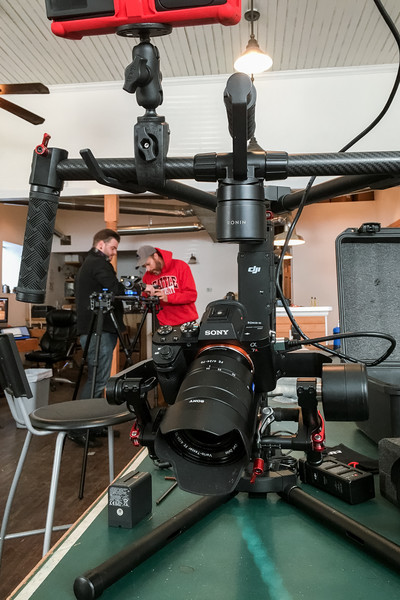
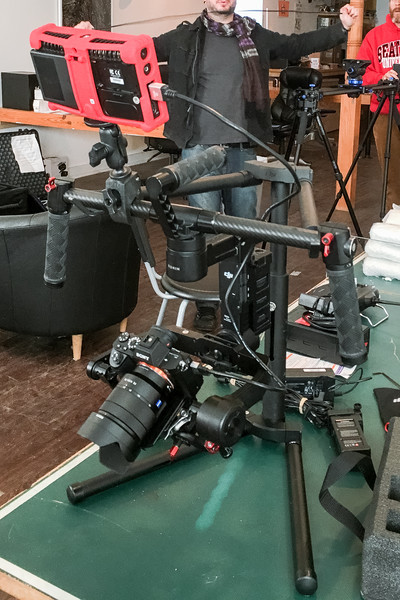
There was still one issue to overcome. I knew the project would involve children who have struggled. Children who have stories. I wanted to tell their story the only way I know how, through imagery. I decided to develop a portrait series of both children right off the streets as well as adults that have grown through the Impact program. I wanted to bring the aesthetic of my portrait work blended with a journalistic mood. That style involved creating a custom canvas soley designed from the ground up for this series. I consulted many weeks with Chelsea Niemeier, a local artist who creates custom backdrops. Unfortunately, I could not travel with a nine foot backdrop, so it had to be small, small enough to fit into a travel kit. We landed on a 3x4 drop that could be rolled around a Manfrotto 2983 Adjustable Background Holder Crossbar and then placed into a case which would house our Benro MoveOver8 Dual Carbon Rail Slider. Due to weight, we couldn’t pack any light stands, so I would have to hash out how to rig the background while on the ground.

After days of packing and working through the new gear, we had a solid gameplan and only one equipment kit per person. We could only cross our fingers to avoid any questions and hurdles during our entry into the country. Upon landing in Addis Ababa, I was nervous. I was stopped due to my camera kit having to be checked in Frankfurt, Germany. I fought it, but to zero prevail. The crew moved ahead and I was all alone in the Addis Ababa airport. Although, I attempted to catch up with the crew in the customs line, there were some unhappy customers who didn’t let me move ahead of the line, which took hours. But, I eventually got through by paying close attention to others moving faster through the checkpoint. By the time I entered the baggage claim, the crew had disappeared, so I kept pushing forward and was able to squeeze past a rope avoiding the final security checkpoint. Once I stepped outside the airport a weight fell off my shoulders, but I still had to find the team. After a small walk through the parking lot, I stumbled upon Reid, Justin and Coury sticking out among the African mob. We made it.









We were met by a man named Abraham Fiseha, who was at the helm of Youth Impact. He was well dressed and had a full head of white hair. Well spoken in English, he immediately came across as kind and warming. His demeanor was the comfort we needed after the long trip. We arrived to our hotel, which was unexpectedly more upscale then we had imagined for a 3rd world country. After a quick rundown of our schedule, we hit the rooms. Our week would start at sunrise.

THE CULTURE
At first sight I was shocked. Addis Ababa, Ethiopia isn’t the Africa I had been first introduced to. It is very different from Tanzania, which I visited in June of 2015 for The Waterboys Initiative. Ethiopia is far more developed, but more crippled. I recongized a small Western influence, but nothing like I’ve seen in alternate countries such as India. Ethiopian people are proud of their culture, religion and heritage. But, their eyes gave me a sense of desperation for more; a need to reach and achieve a better life.
Addis Ababa is beautiful, but broken. As we traveled down the streets we saw an extreme juxtaposition of humanity. Although much of the demographic is young, I immediately noticed a difference between new and old. The fashion was all across the board, from western hip skinny jeans and fake leather Air Jordan’s to authentic long white Africa dress that covered most of the body and head. And, underneath the clothing I didn’t see much happiness.



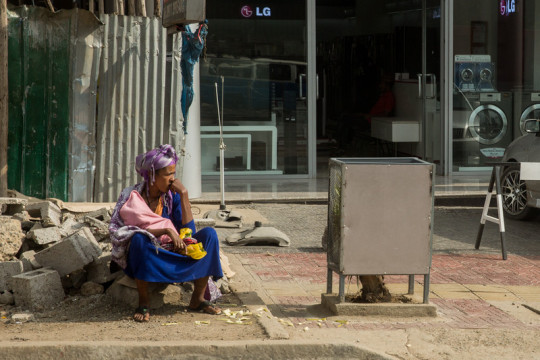

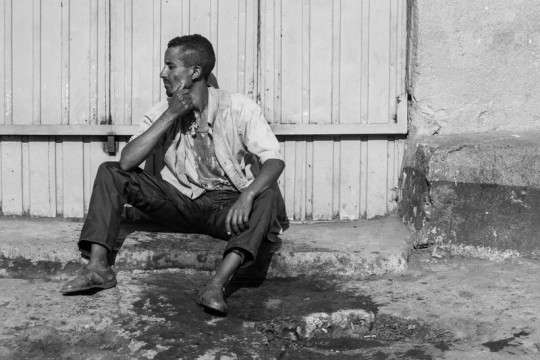


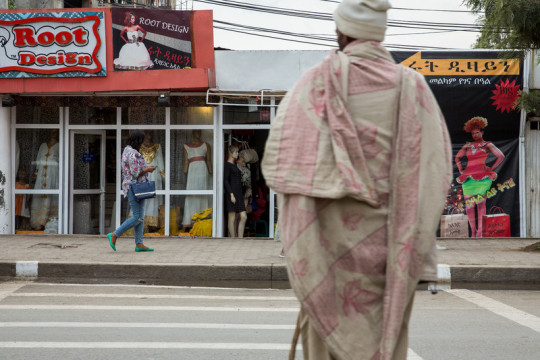
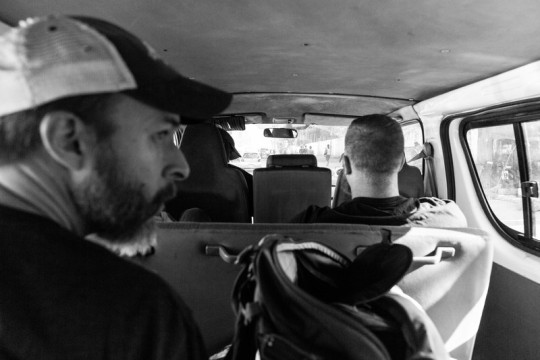




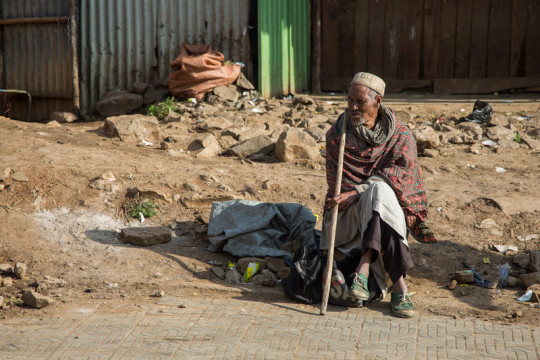

Photographing this project in Addis Ababa was one of the most difficult assignments I’ve had. Much of the content I photograph is street photography and a production-style touch of photojournalism. It’s not what I do nor what I’m known for, it’s something I really enjoy. It takes me outside of my comfort zone and into a life behind the lens. It’s my security blanket in these strenuous and precarious locations. Nevertheless, the people of Ethiopia are terrified of the unknown. Despite our project indirectly saving the lives of their own, they are hesitant of any type of picture, including documentary work. Due to the fear of exploitation, we were met with a lot of resistance and “hands over the face.” It made our job difficult, we had to be quick, inconspicuous and constantly in the shadows.


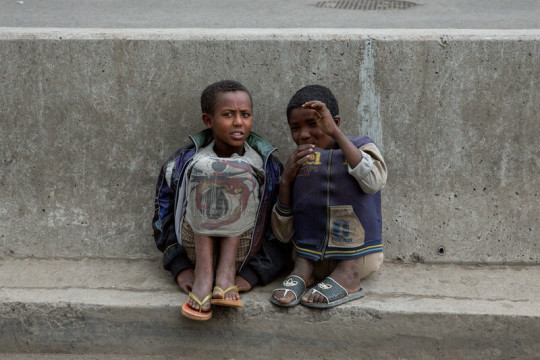

THE IMPACT
It was our task to focus on a foundation that was impacting the lives of children who so desperately need help. Upon arrival at the shelter, my reaction wasn’t shock, but difficulty. The shelter was small, similar to a one floor ranch-style two bedroom home. The front yard was piled with random rusted debris and the back porch was a concrete dorm with open doors and ropes covered in wet clothing. The shelter is completely surrounded by a 10-foot concrete wall which was embedded with shards of glass; an inferior barbwire. Unfortunately, Youth Impact has trouble keeping their shelters, due to high rent and troubled neighbors who complain about the amount of children populating the home.








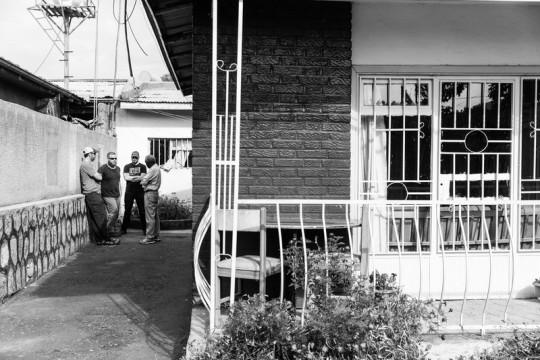
Abraham Fiseha is the face of Youth Impact, a soldier of the children. He loves his country and over the years saw a great need to help the needy, which consisted mostly of children. His love for children permeates through the entire program and his thoughtful aura carries the entire shelter with strong leadership and an inspirational message. He wants the youth to succeed and has a deep passion for creating that success for each of the children. He is a hero to thousands. But, Abraham has a secret weapon. His name is Ermias Zeleke. A man with a troubled history and once lived on the streets; now the mentor to dozens of homeless children. Ermias is quiet, calm and collective. He has an amazing smile that can warm the heart in an instant. Many street children are disconnected, they are scared and alone. The street is their home and it’s hard for them to ever leave. Ermias hits the street every single day in attempt to gain the trust of the street children and build a bond so that may accept the opportunity to move into the shelter. It’s not easy, many times requiring months and months of constant inquisition and discourse.

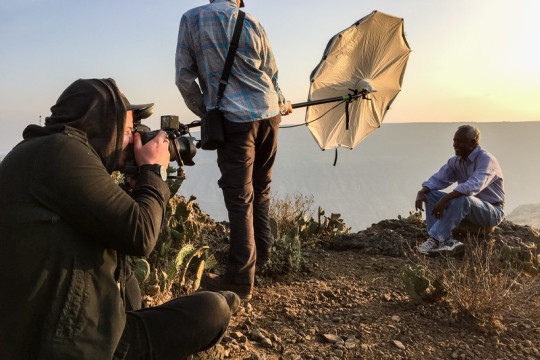


THE SERIES
I had a clear idea of what to expect once we dove into the project. Youth Impact has blazed a trail for dozens of successful business men, architects, carpenters and artists. Once homeless, many Ethiopian Millenials have been saved through the Youth Impact initiative. I wanted to capture not only the current children living through the shelter, but also those blossoming people who had so much to owe to their mentors. It was a humbling experience to photograph this community that has so much to say, but no voice. Hopefully, this series provides that voice that they so yearn to have. This is dedicated to the outstanding team of Youth Impact that is making a significant difference.


Behailu Kassanhun
Orphan, he was taken into Youth Impact and has since graduated with a College degree and teaches Architecture.
Konjit Dejene
Orphan, joined Youth Impact at the age of 17, she has since graduated College and is currently a School Teacher.
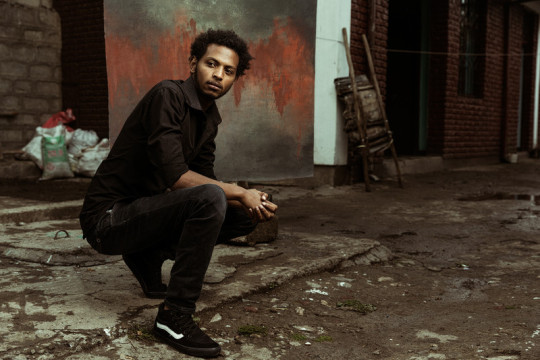
Robel Yimer
Orphan, joined Youth Impact at the age of 16, he has since graduated College.

Amanual Haile
Orphan, joined Youth Impact at the age of 12, he has since graduated College.
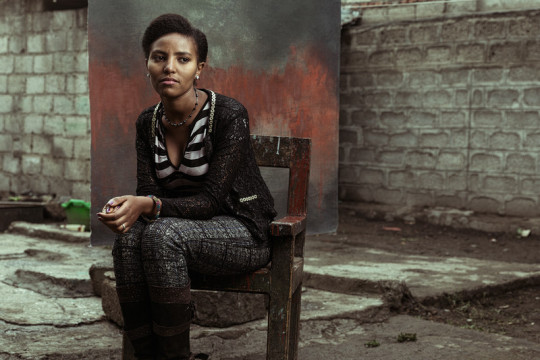
Genet Fantanhun
Orphan, joined Youth Impact at the age of 14, she has since graduated College and is currently a Elementary School Teacher.

Kidist Tesfaye
Orphan, joined Youth Impact, she has since graduated College and is currently serving at a local hospital as a nurse.

Yemisrach Tesfaye
Orphan, joined Youth Impact at the age of 12, she has since graduated College and is currently serving at a local hospital as a nurse.

Dawet Daneyl
Runaway, joined Youth Impact from the streets of Addis Ababa, he left his home in Ghana to find work in Addis Ababa.
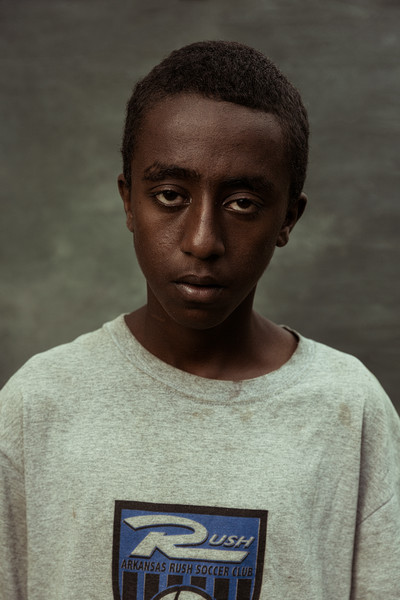
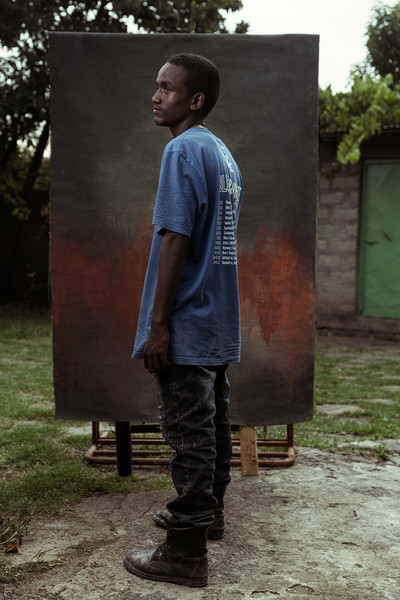
Fekeredin Kiyar
Runaway, joined Youth Impact at the age of 16 from the streets of Addis Ababa. He left a Muslim family.
Junedin Guye
Runaway, joined Youth Impact from a troubled life on the streets of Addis Ababa. He was addicted to glue and hash. He left his rice farm in Ziway for Addis Ababa. He has since rehabilitated.

Mubarek Abedela
Runaway, joined Youth Impact at the age of 16 from the streets of Addis Ababa, he left his home to find better work.
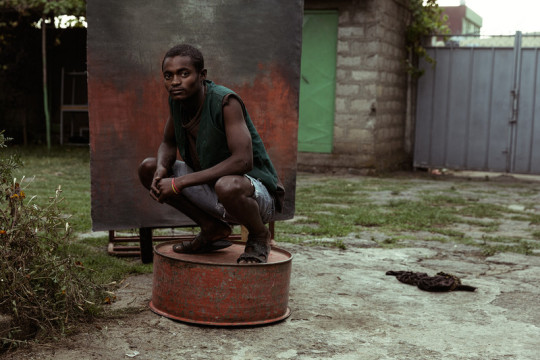
Sebesebea Akalu
Runaway, joined Youth Impact from the streets of Addis Ababa, he left his farm in Ghana to find a better life in Addis Ababa, which resulted in homelessness for over 4 years.

Habetamu Fentetahun
Runaway, joined Youth Impact from the streets of Addis Ababa, he left his farm in Dessie to find a work in Addis Ababa, which resulted in homelessness for 2 years.

Tiwoderos Abebe
Runaway, joined Youth Impact at the age of 18, he left his farm in Ghanda to find a work in Addis Ababa, which resulted in homelessness for several months.

Alem Kere Tiehay
Runaway, joined Youth Impact from a tough life on the streets of Addis Ababa. He has been jailed 8 times for alcohol related crimes. He left his farm in Ghana for Addis Ababa.
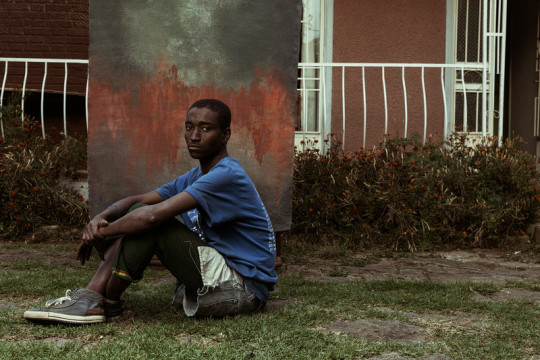
Eferem Tesefay
Runaway, joined Youth Impact from the streets of Addis Ababa, he left Ziway to find a work in Addis Ababa, which resulted in homelessness for several months.

We didn’t have a system to rig the beautiful canvas that I had custom painted, so we grabbed what we could from the pile of wreckage on the alley-way next to the Youth Impact shelter, a cracked wooden ladder and trashed twin bed frame. Using a Manfrotto 035 Super Clamp attached to the backdrop, draped over Manfrotto 2983 Adjustable Background Holder Crossbar, we linked the clamp to another Manfrotto 035 Super Clamp and secured it to the debris. Using gaff tape and zip ties we fixed the bottom of the backdrop to avoid kick up from wind.
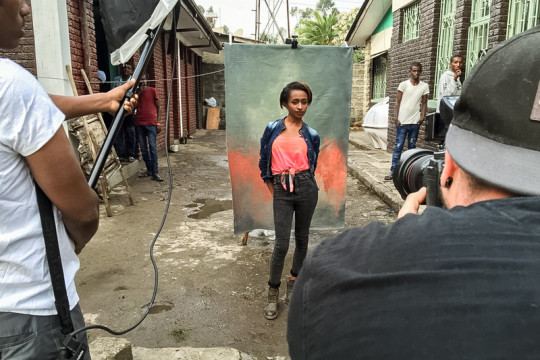
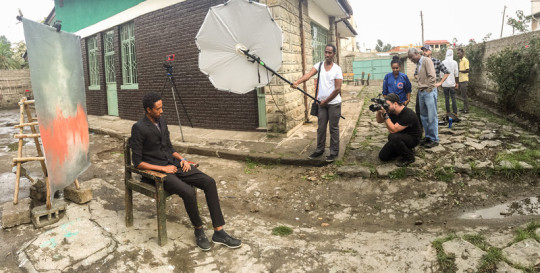
The light setup was simple; a Profoto B2 Location Kit attached to a Manfrotto 026 Swivel Umbrella Adapter which we coupled to a Manfrotto 680B Compact Monopod for complete mobility. The Profoto B2 head is modified with a 46” Photo Softlighter II, one of the softest source of modification I’ve ever used. Luckily, I had two trusted assistants who spoke enough broken English to understand my instructions of feathering the light and keeping the strobe consistently directionally opposite the sun.
It was a true honor to hear the stories behind these young adults, who have so much to offer but, nearly had zero foundation to create a life. Fortunately, Youth Impact has provided a reachable dream and given the ladder of victory. Built upon a dark past, they are the future of Ethiopia.




THE BEAUTY
Ethiopia has impacted the world. It tells the legend of being the birthplace of coffee. It’s also known for being the possible location for the Garden Of Eden, which is so detailed in The Bible. Although, most of our journey took place in the centralized slums of Addis Ababa, on the last leg of our adventure, we left the smoggy city and ventured out the the beautiful pastures of Ethiopia. We eventually landed at the Ethio German Park Hotel in the heart of the Blue Nile Gorge. A historical land of wild baboons, unique plant-life and mile-high canyons. The jagged rock and sandy-brown texture painted a beautiful landscape that overlooked thousands of acres of farmland and housing. I remember sucking in the fresh air for a momentary high after a long arduous week of documentation.
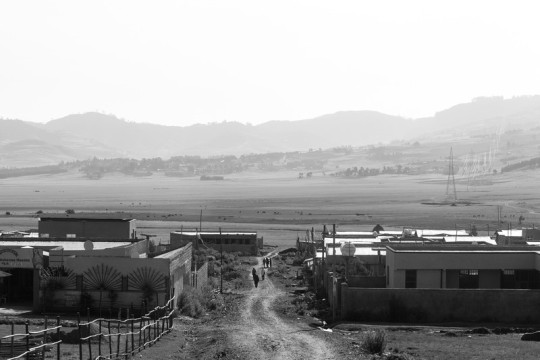

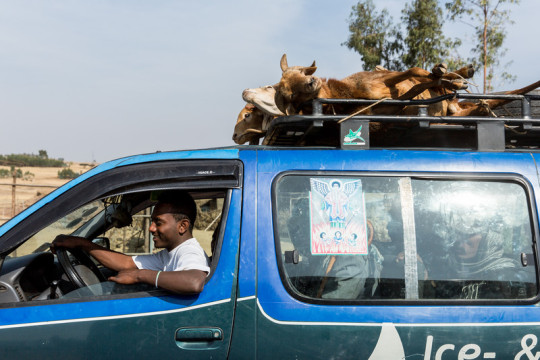

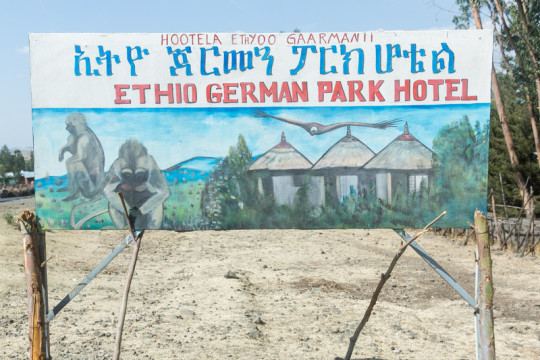


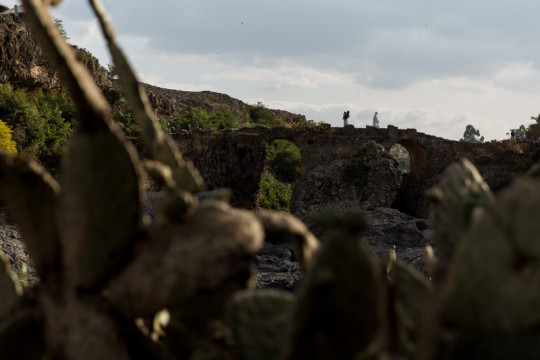
We were finally able to break out the DJI Inspire Drone and capture the beauty of this amazing country. We spent the first few hours planning specific shots, which had to be captured at specific times. Our final shot would be the biggest obstacle in the entire production. The Blue Nile Gorge consists of a massive waterfall which has helped create the Portuguese Bridge; a rocky structure that has three large arteries. It was built in the 16th century by the Portuguese to cross the epic waterfall. Fortunately, we arrived to the canyon during its driest season. But, there were deep pools that local youth jump into from a thirty-foot craggy overhang. This was our shot, this was our ending. We wanted to capture the thirty-foot jump from three different perspectives; overhead drone, stabilized follow-shot and a static shot down below near the natural pool. After six jumps and a lot of trial & error, we had the shot wrapped. Despite the crew being absolutely beat, we celebrated by making the jump ourselves, in just our underwear.




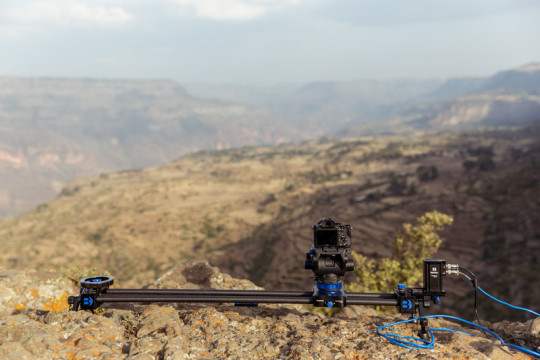







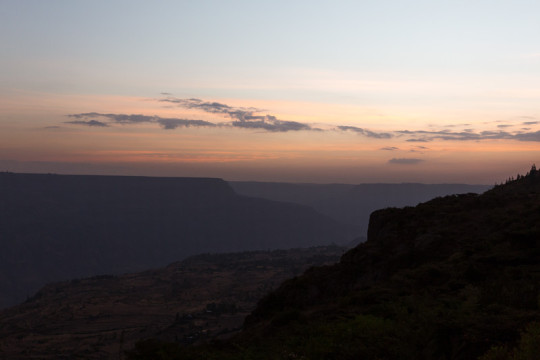
After a strong day in the Blue Nile Gorge, we high-tailed it back into Addis Ababa. On the way, we dropped by a road-side farmer who farms Injera, which is the main source of food in Ethiopia. The crop was dry, wheat-like and was cut into large bails, similar to Hay. The man was kind and welcoming to a photograph, a refreshing end to a stressful journey.






The flight back to the United States was a long, somber journey. The east coast had been slammed with poor weather and all international flights into the States were immediately cancelled. We tried for hours to connect the dots and make it home in a decent amount of time. Unfortunately, we were not that lucky. We had a 24 hour layover in Frankfurt, Germany which actually turned out to be a blessing in disguise. Despite the lack of sleep it was invigorating to breath in some cold air, trek thorought the Bacharach mountain vineyards and explore the Frankfurt night-life. The late-night strawberry hookah was just the icing on the cake and a takeaway we needed. It took nearly 48 hours to get back into the United States. We had traveled from Africa to Saudia Arabia to Germany to Texas and finally to our destination, but I couldn’t help but reflect on the week in Africa. The world is such a big place; I’m just so blessed to have the opportunity to see it.
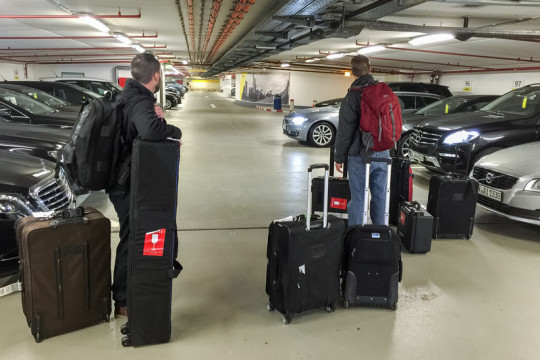

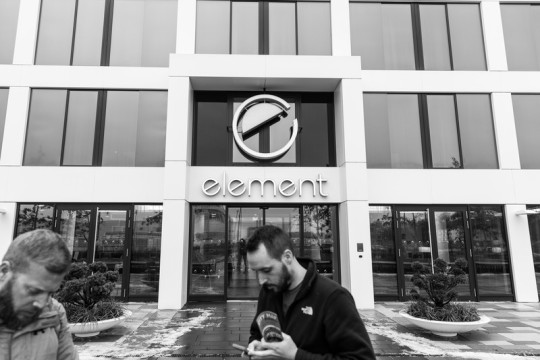




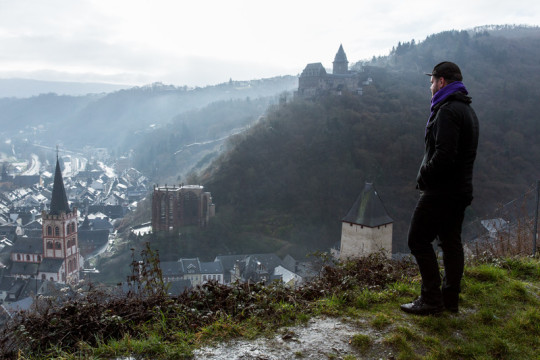




Our experience changed me. I now drink coffee and I obsess over Ethiopian spices. On a deeper level, I came back to the United States with a new found respect for those helping others and raising a community. When I am asked about Ethiopia, the first thing I see is the faces of children who had never seen themselves in a photograph. I only hope my photography and our films can shape the lives of people all over the world.


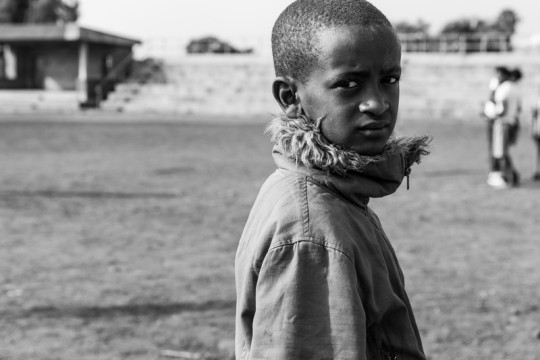

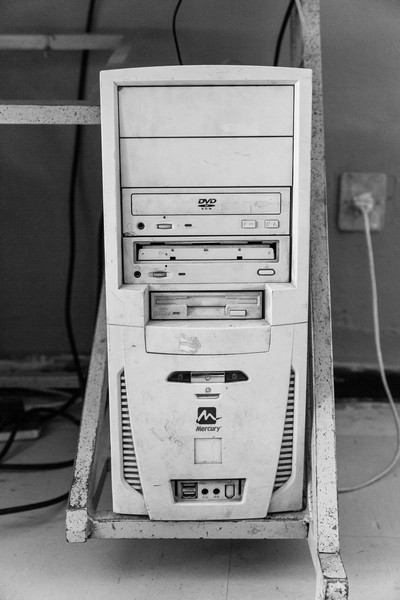

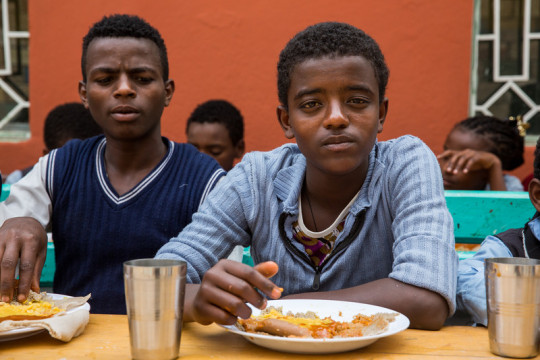

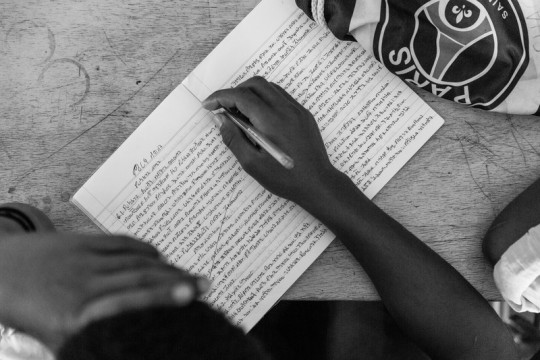
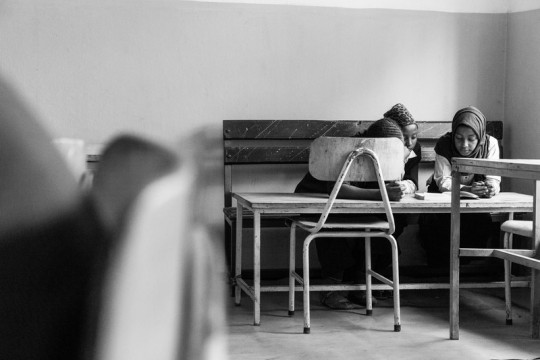


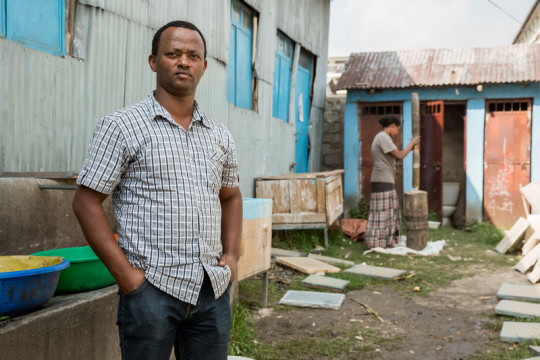
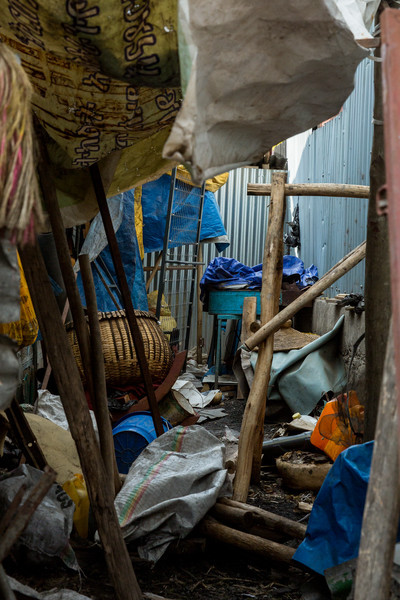








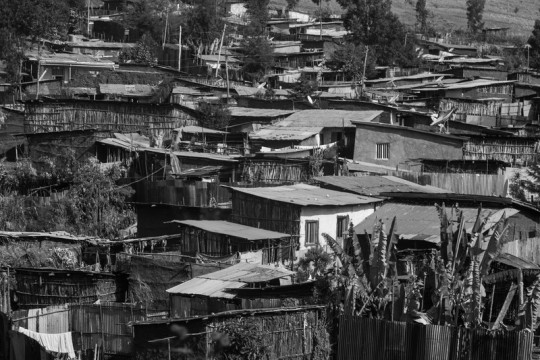

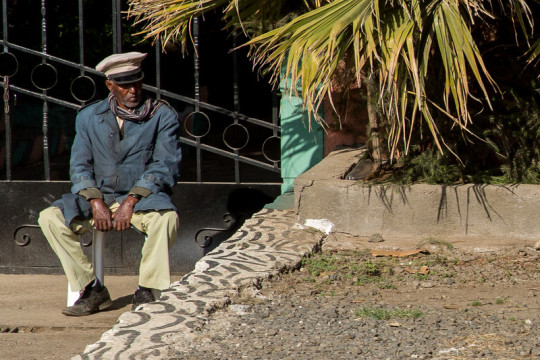

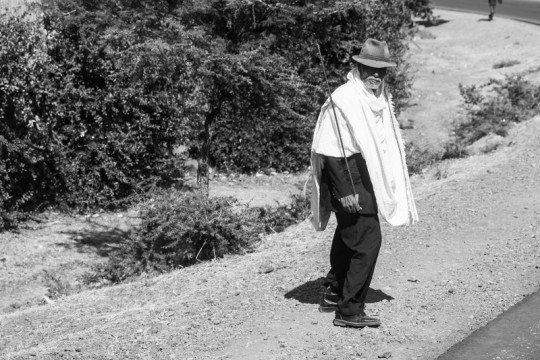
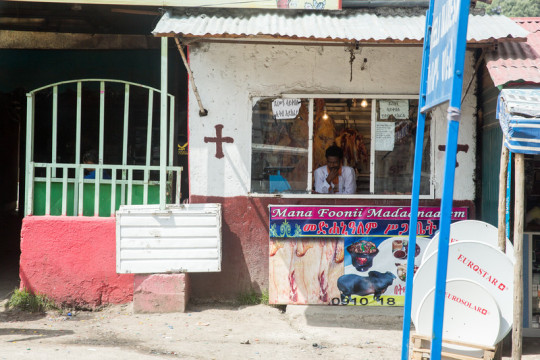
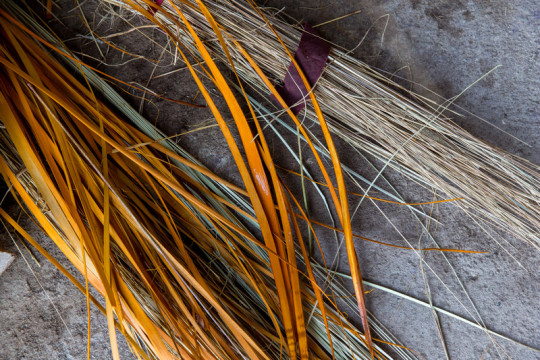

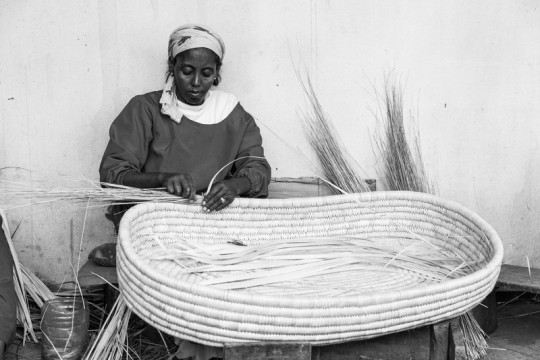







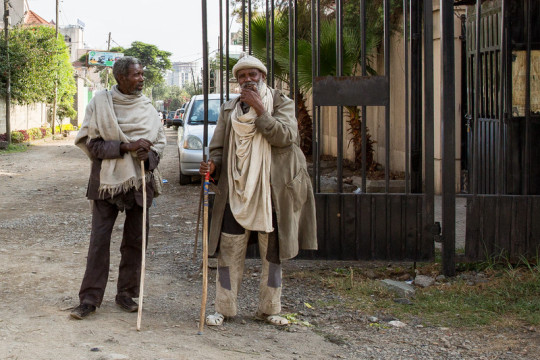








#ethiopia#claycookphotography#claycook#nadusfilms#addisababa#youthimpact#portraitseries#ethiopiaportraitseries
1 note
·
View note
Text
2015 - REVIEW
It is summertime again, vacation time. You go to your uncle's house. He takes you on a tour around the city. There are many old buildings, but the oldest of all is on Main Street. The address is 880. He says that it is haunted, but you don't believe him.
Choice: Do you go inside? Or: Do you stay there?
The paperback series “Choose Your Own Adventure” published throughout my childhood, really nailed it. The story provided the reader the option to make decisions throughout the book, in turn directly defining the ending on their own. It had multiple conclusions and multiple paths. Each choice results in another decision that formulates your adventure. I think life can be most compared to “Choose Your Own Adventure,” it’s made up of thousands of small decisions that build to larger decisions that really outline your entire childhood and adulthood.
Reflecting on the past 12 months, I made a lot of decisions; some educated, some risks and a lot of failure. The good decisions were sometimes overshadowed by the poor decisions. Each choice shaped the circumstances of my way of living, both professionally and personally. It was a year that really challenged me, a year that really changed me and a year that really defined who I am and hope to be.
It started out on high; my photography was really starting to evolve, I had just been published in several major national publications and plans were in place. I was busy, very busy, but I never chose a life any different. Personally, I was dating a beautiful woman who had common interests and I really thought to be the one. Similar to any relationship, we had had our low points, but we shared a strong bond. Having been divorced from a short-lived marriage in a “previous life,” I felt as if I had finally met someone who I could really share my life with. But, I made a choice. It wasn’t a bad choice or something malicious, it was unconscious. A choice built into my being; career first.
And, life handed me a serious case of heartbreak. The worst kind of heartbreak. Passionate heartbreak. The kind of heartbreak that didn’t fizzle or fade, a pain that burned stronger the more time that passed. My friends told me to “consume your life with work” and “stay busy.” But, that was already my daily life ingrained. So, I used photography to explore the thresholds of emotion. I used it as an outlet, similar to what I did during my days in music; I bottled emotion and exploded on the stage or on tape. Looking back, it was the worst kind of heartbreak, but also the best kind of heartbreak. It was life-changing.
I felt guilty over the failed relationship in some ways, but in others I felt inspired. Once the initial onslaught of 21-year-old non-stop-party lifestyle ceased, I finally decided to take on the momentous task of reaching out to my old-friend Sol Perry, a nutritionist and trainer who had successful lost over 100 pounds himself. It wasn’t easy finally coming to the realization of how poor I had treated my body over the past 5 years. We set goals, shifted my lifestyle and started on a path of work-life-balance and wellness.
Once the door was closed and I was truly alone, suddenly I was handed opportunities I could have never imagined. It felt like a snowball, one success after another. One opportunity after another. I'm not sure any mystical genie or crystal ball could have predicted the maturity and adventure of the past 365 days. Let’s review…
I photographed Kay Gaines for First For Women Magazine, a magazine with a circulation of over 1.2 million reaching nearly 4 million consumers.
I created the “Clay Cook | Community” which currently has nearly 1500 amazing photographers. It was recently stamped the “Blog Of The Month” by Digital SLR Photography Magazine.
I photographed Kate Finster; a record-breaking, national champion figure skater; who will be going for the gold in the 2018 Winter Olympics.
I had an image published on the Thomson Reuters Time Square Billboard.
I photographed Albert Blaise Cattafi, who has danced for Cirque Du Soleil and Florence And The Machine as well as choreographed Broadway shows such as Spider-Man and Flash Dance.
I produced an article for Digital Photo Magazine on lighting with one strobe and using ambient light to create a well-balanced image.
I was interviewed by Digital SLR Photographgy Magazine and featured across a 6-page article for thier April issue. The publication is distibuted world-wide.
My imagery was featured on photography blogs such as Fstoppers, PetaPixel, SLR Lounge, 500px and Resource Magazine.
Along with Nadus Films, I traveled to Tanzania, Africa to photograph Chris Long of the St. Louis Rams and the Goodwill Ambassador of Tanzania, Doug Pitt (Brad Pitt's Brother) for their non-profit Waterboys Initiative. Our story was featured as a top article on ESPN and the documentary piece produced by the NFL and narrated by Matthew McConaughey made its debut on the NFL Network.
I stepped in front of the camera for a 16-page feature in The Voice Of Louisville on our travels to Africa for the Waterboys Initiative.
I collaborated with 20 photographers, artists and stylists for "Project Metanoia" which earned over $3,000 for the charity Fund For The Arts.
I ran a series of workshops all across the United States and educated over 150 photographers.
I mentored 6 incredible photographers through my internship program.
In partnership with Phase One, I've was named as a "Capture One Ambassador”
In partnership with Profoto, I was named as a “Profoto Ambassador” and featured in a 4-page advertisement, which was published in Rangefinder Magazine.
Along with Nadus Films, I traveled to New Dehli, India to photograph Dr. Ananthi Jebasingh, she is considered the modern day Mother Theresa of India. We also trekked through Agra, Rajasthan and Darjeeling.
I photographed a 20-page fashion editorial in the heart of Havana, Cuba for The Voice Of Louisville and Blue Equity. The first of its kind.
The image "Hold Tight" from my assignment in Tanzania, Africa was selected as an Editor's Choice for National Geographic, resulting in being one of the top photographs of the year.
I hosted over 10 Live Editing seminars and have done several podcasts for brands such as Seamless Photo, TogTools, Business Of Creatives, The Angry Millennial, ConnectingThings, Tether Tools and X-Rite.
I became utterly addicted to Green Tea.
I lost 75 pounds.
There is a lot of “I and I” in that bullet-point review, but I can’t take all the glory. Every project requires a team and I’m confident I have one of the most efficient, hard-working teams on the planet. All of the success is a direct result of that team. My mission is to deliver a fantastic product for my clients, fulfill a craving for creativity and most importantly inspire others. None of it would be possible without the dedication the following people: Chris Miske, Jacob Roberts, Kelsey Page, Zach Erwin, Carly Secrest, Dana Rogers, Dave Meall, Jordan Hartley, Bethany Hood, Anastasia Page, Blake McGrew and Justin Gustavision.
In order to recount this year, I returned to my 2014 Review as if to look for a hint of a telepathy superpower; I found nothing but excitement and peace. That state of action remains the same 52 weeks later, but now I feel ravenous and strong. I can’t predict the future or read my own palms, but I can make wise choices and those decisions will design my path. It has been a year of growth, enrichment and change. I’ve had to bear some hard lessons, but it has been the choices I’ve made that have characterized who I am today; secure, energetic and determined to accomplish every goal I have set in that path.
2 notes
·
View notes
Text
CUBA
I left Cuba with a song stuck in my head. I didn’t know what was being said in the song or how to pronounce the artists name, but I knew the melody. It was everywhere; every nightclub, bar and restaurant. Every waking moment, I would hum the melody and mumble the lyrics as if I knew what the lyrics meant. As I write this post stationed in a coffee shop down the road from my studio, that very song began to play over the loudspeakers and I couldn’t help but smile. My Cuba experience was memorable, not only because of the vibrant and beautiful landscape, but the people, who have really stuck in my mind and overshadowed that song. Its fascinating to see the advancement that Cuba has made because of its newly negotiated relationship with the United States and it’s sweeter to hear a taste of Cuba in a little coffee shop in Kentucky.
When I’m asked “How was Cuba?”, unlike most countries I’ve visited, it’s pretty simple to explain the cool cars and architecture. What isn’t easy is to explain the people, fashion and culture. It’s an explosion of race, age and color. Upon landing in Cuba for the first time, I didn’t feel a sense of danger or the need for steadfast movement like I had in Africa and India. We were met with open arms and welcomed like superstars. I was instantly enthralled with the untouched Cuban history and culture.
youtube
About two weeks after my return from India, I received a call from the Publisher of The Voice Of Louisville regarding a project in Havana, Cuba for Blue Equity, LLC who had established some business roots in Havana. The project consisted of capturing a twenty page fashion editorial as well as a large feature on the rich culture, communist government and beautiful society. The production called for two five-day trips. The first mission would be to scout locations, meet and cast talent and lock down hanging details. The second trip would be the actual production; game time. When it comes to these types of travel scenarios, I’m skeptical until the flights are booked, but I knew this was the real deal. This was a dream situation that doesn’t come around often for editorial photographers, if ever.
I was in the dark for much of the time leading up to our first trek down to the island. I usually have a great idea of what the target and end goal was for the production. But, a great deal of trust had been placed in my lap on behalf of The Voice Of Louisville, the Government of Cuba and Blue Equity, LLC. I had to own it, I had to deliver, no matter the obstacles that stood in the way.
Getting to the island of Cuba was not an easy flight. It was an all day process from Louisville, Kentucky. A process that included 3 total flights and a solid 10 hours. Although, Cuba is only a 40 minute flight from Miami, the process to get on the flight is arduous and time-consuming. Despite the language barrier, we were able to expedite much of the process based on the relationships that had already been built by the team of Blue Equity, LLC. There is no doubt that we traveled in style, which made the flights easier.

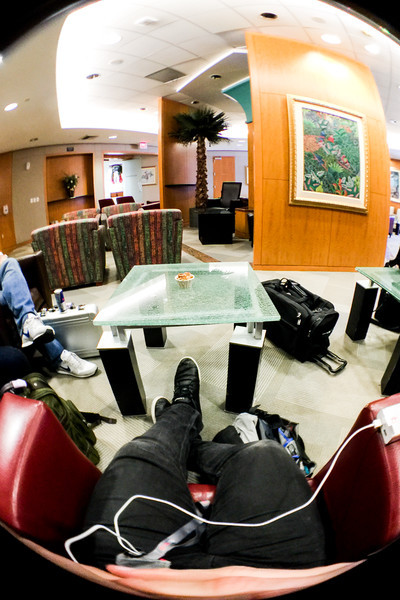


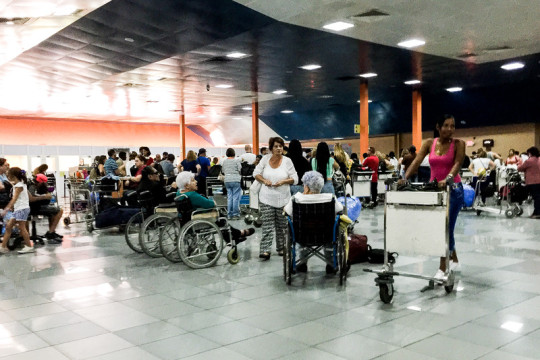

Upon arrival in the Havana airport, we were met with a breath of hot weather, but a bleak overcast sky. I didn’t know what to think, I just followed the pack and hung towards the back of the line. We pushed through customs and after a short wait, we had our bags and loaded everything into a 9-passenger van, guided by our driver, Rafi. I quickly learned that Cuba was a visual paradise. The color, texture, automobiles and landscape was overwhelming, I didn’t know where to focus. The sun began to peak through the clouds and set into the horizon, which covered everything with a red-orange blanket of color. We pulled to a roundabout and arrived at The Saratoga Hotel located across the street from the Parque de la Fraternidad located in central Havana. Shockingly, our hotel was incredibly luxurious. I checked in, changed clothes and headed up to the rooftop to catch a sunset view and cocktail. I was blown away. I’ve seen a lot of stunning landscapes, but this topped the list. I felt a blast of untapped energy and vibrance.




The people of Cuba have a yearn to grow. The island is plentiful, with a lot of room to change. The majority of the Cuban people seem to be happy about the possibility of the trade embargo being lifted and the tourism restrictions being alleviated. Since the Castro revolution in 1959, Cuba has been locked into their own civilization without influence the exception of their communist relationship with Russia. The aesthetic of the architecture was gorgeous, but confused; worn Spanish neoclassical, odd North American art-deco and boring rectangular superstructures covered in a bland shade of beige introduced by Soviet Union ideals. The streets are electrifying; classic cars sputter from destination to destination without traffic restrictions. With the revolution, import from North America ceased, so classic cars are commonplace and modern cars are considered a luxury.
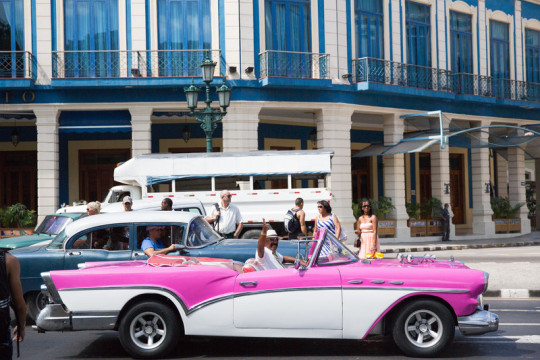






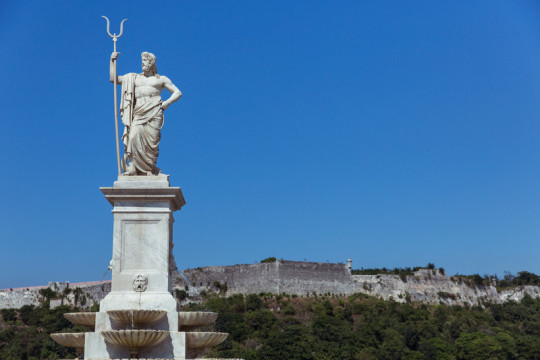


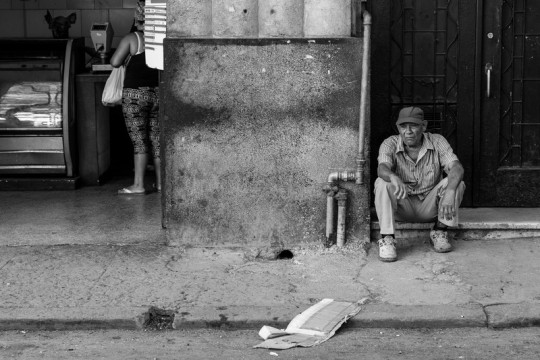


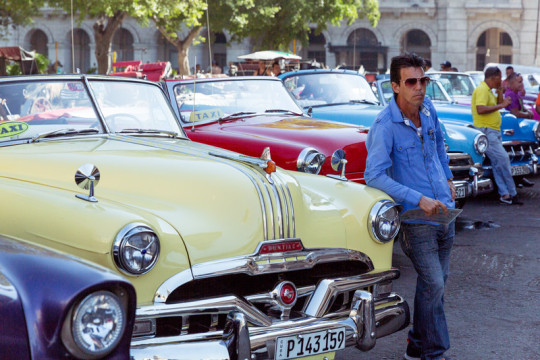


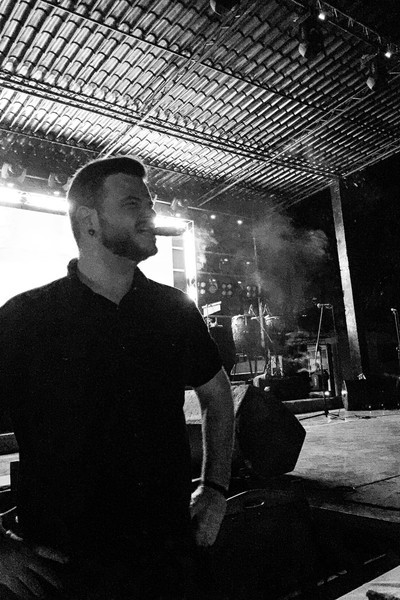


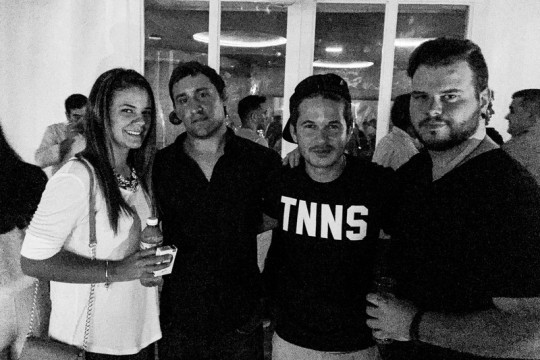
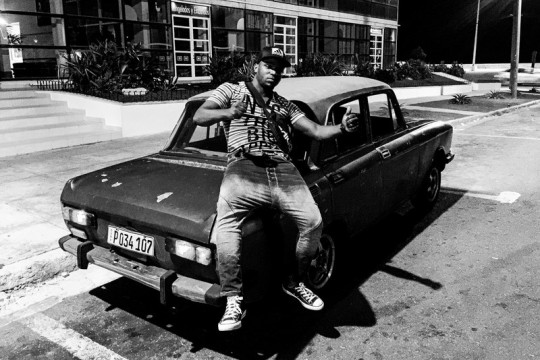

Over the course of the next few days, we worked hard during the day and played hard at night. But, my camera stayed by my side at all hours of the day. Occasionally, a photo opportunity presented itself and I took advantage of the moment. Other times, it was production meetings and finding the best possible locations to photograph the fashion. I switched back and forth from "production photographer" to "street photojournalist" in an instant to guarantee I gained the proper content and knowledge we needed. Throughout our time in Cuba, I was able to really start building the foundation required to create this piece. Despite the language barrier, we were able to put the puzzle together with only a few missing pieces. It felt like a tease, but we needed that taste before we swallowed this whale of a project. I left Cuba anxious and uptight but, wise and equipped. The next step was to rally the troops. This would not be a easy creation.

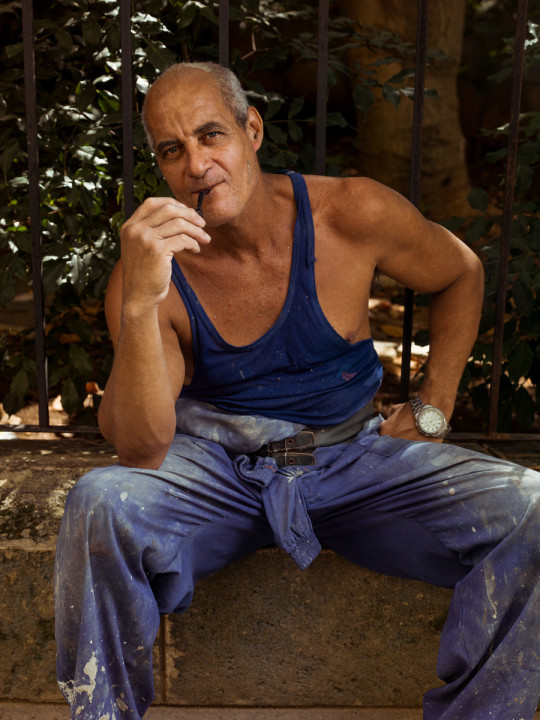

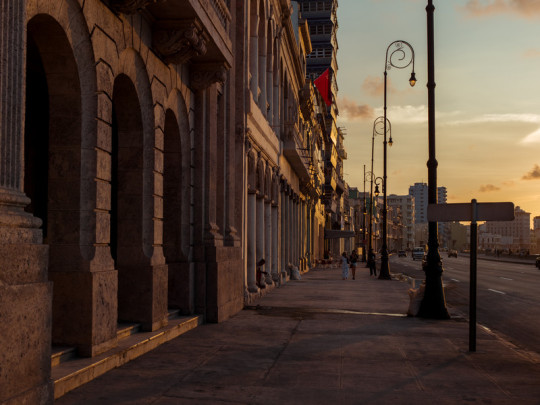

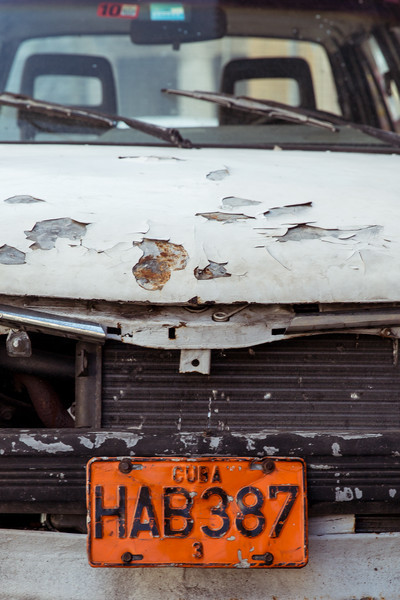




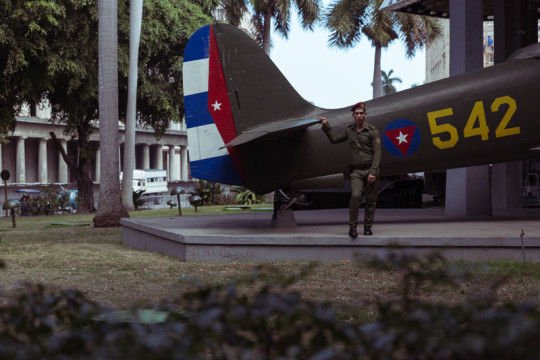








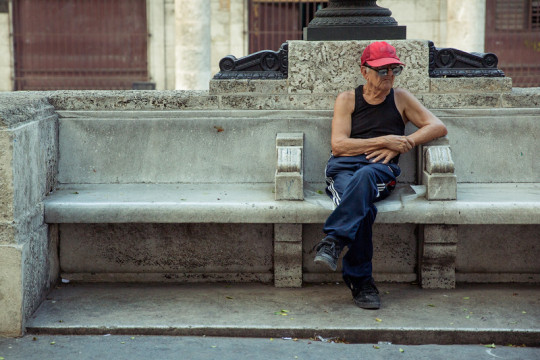

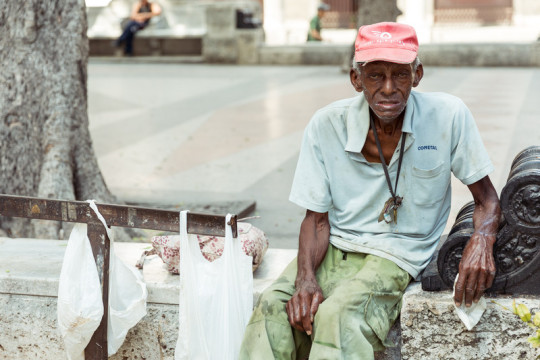

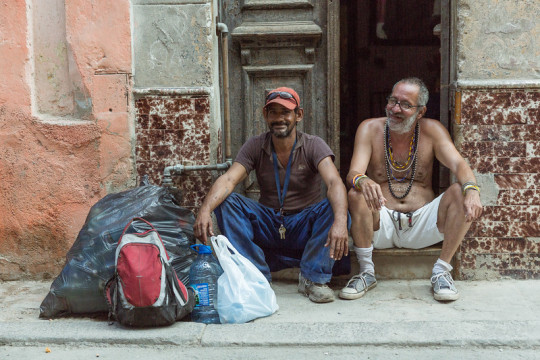



Fortunately, the PhotoPlus Expo took place in New York a week before the production date. I was able to meet my equipment sponsors and chat about the project in person. The team at Digital Transitions provided us a Phase One 645DF with a IQ250 digital back along with a Schneider Kreuznach 40-80mm f/4 zoom lens and a Schneider Kreuznach 110mm f/2.8 static lens. In consideration of using this setup, we made the executive decision that tethering to Capture One was essential. Thanks to my friends at Tether Tools we created the most mobile, small scale, on location tethering system possible. I knew we would be jumping from location to location and we didn’t have the time for an immense amount of setup. With this knowledge, we also knew that carting a lot of lighting would be impractical. The Profoto B2 Location Kit was an obvious choice. We had to rely on the hard light of the sun, it was a risk, but a necessary risk. The B2 head through a Photek Softlighter would provide a soft fill to reduce shadow density caused by the hard sun.
The day before we were set to fly out; my assistant Zach and I, checked gear, gaffed labels, charged batteries and prepared the equipment as if we were heading into a war zone. We made sure all cameras, lenses and accessories could be stashed in a Think Tank Photo Airport Security and a Think Tank Photo Airstream, which was meant for carry-on only. We placed our tripods, a small collapsible lightstand, modifiers and other heavy duty equipment into checked luggage.
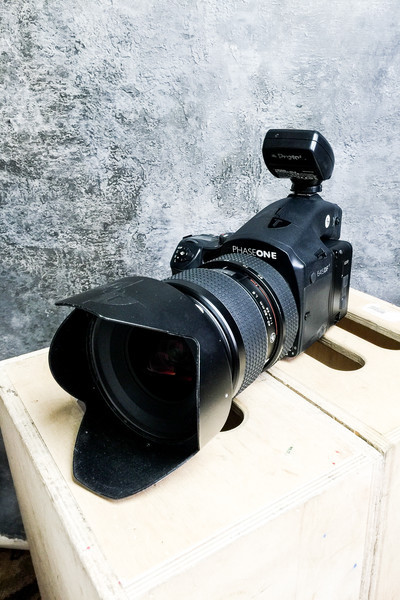

This shoot was a heavy burden on my back. I had a lot to deliver and a lot of hype to live up to. I mentally prepared for a tough few days and made sure Zach was briefed on the logistics of the production. Zach had to work twice as hard as anyone else. Not only was he responsible for the equipment, he was also responsible for language translation and behind the scenes.
Just in the difference of a month, Cuba was changing. As we shuttled through customs, I noticed everything had a sense of organization and controlled chaos, unlike our last trip. Time was cut in half and we made it to our destination in less then an hour. Because of the influx of tourism, the Saratoga Hotel was booked months in advance, so this time around we stayed at The Atlantic; a high-rise apartment complex with full-service accommodations and an incredible rooftop pool. Once again, I was taken aback and had a moment of reflection. I was truly living out my dreams.


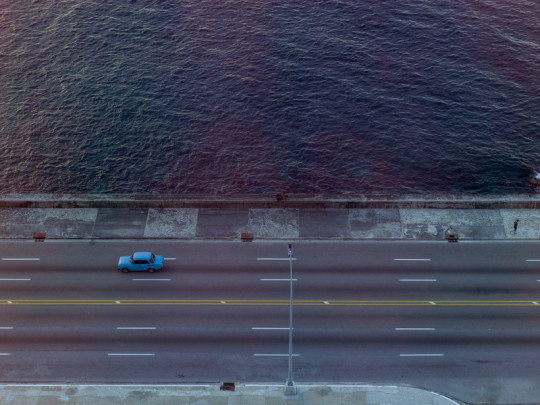
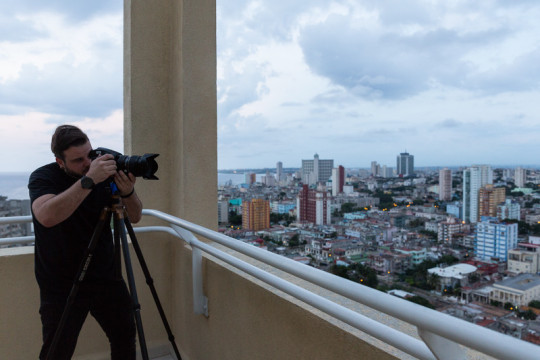

The next morning, we hit the ground running. The sun began to soak the city like a warm bath, which designed beautiful lines and shapes on the city streets. Despite a few last minute audibles by the Government Of Cuba and their choice of locations, we adapted to the scenario and landed at our first location, right in the heart of a military base whom had not been advised of our production. We were left to setup, while the rest of the team made sure the hair, makeup, designers and models were moving. Within twenty minutes of setup, we were faced with a series of guards who shut it all down. Fortunately, Zach was able to speak some broken Spanish and make sure everyone remained calm. As we waited for the rest of the team, we had the unique opportunity to speak with a solider who was on a break under a tree canopy. He was just 17-years of age, quiet, collected and had a hint of excitement in his voice. We talked about the influx of tourism, his role in the military and America. This short chat gave me the opportunity to cool-off physically and mentally. The soldier under the tree was the much-needed catalyst to kick off a calm, but efficient shoot.

The crew arrived and after quick conversation, we were given the go. Setup and pre-lighting began immediately and within 10 minutes we had the frame. Our beautiful model Naivys Fernandez stepped in front of the lens wearing a colorful loose purple blouse and pants. With the click of the shutter the production began, on a military fortress, overlooking the city of Havana. I was in heaven.
But, immediately we had technical problems. The tether wasn’t working properly and we had a storage issue. We pushed through it, without a distraction and resolved the issue by removing one tether cable in the chain to the MacBook Pro. The files couldn’t import onto our backup drive fast enough causing the error. With that problem behind us, I could finally breathe and work magic. I was excited to work with each model. It was refreshing to be in such a new environment with new talent.
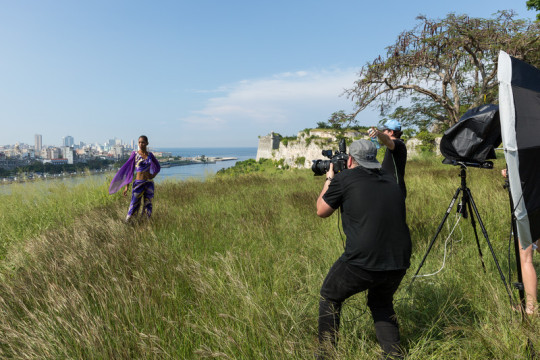
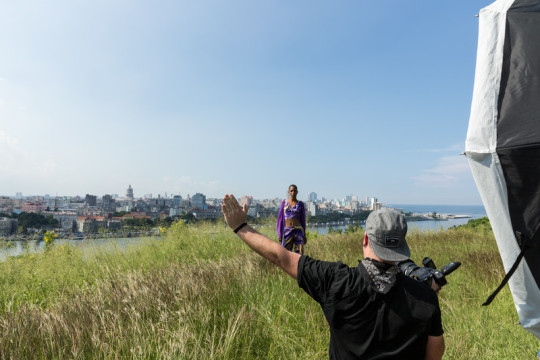



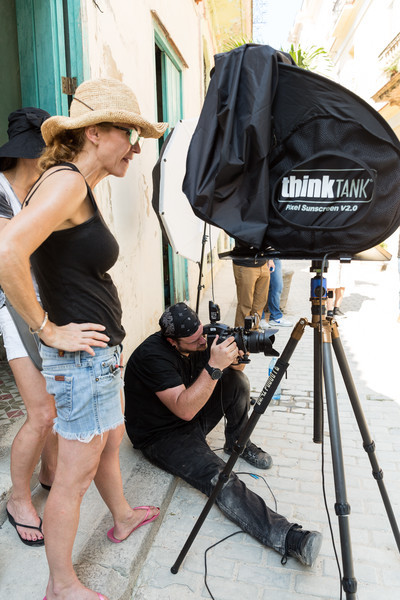




The sun was record-breaking hot and my camera was heavy. With all the accessories, it was close to fifteen pounds, which can add up after ten hours of lifting and holding. By late-afternoon I was pretty beat and my forearm felt like rubber. Although the team stopped for lunch, we decided to keep moving. Each set required about thirty minutes of time with setup and pre-lighting. The models were rolled out like products on a conveyor belt, it was an extremely productive process and very essential. But, it was a challenge to capture models in the right lighting and include the surrounding environment. We wanted the people, we wanted the bustle and we wanted the noise. Sometimes, that required the right amount of patience. We waited for the right moment and the right timing for the story to form.
And, fifteen looks later; we were still shooting and I was completely bushed. We wrapped the day on the rocky shoreline with our backs to the Malecón and a crowd of people. I was excited, confident and ready for a cocktail.


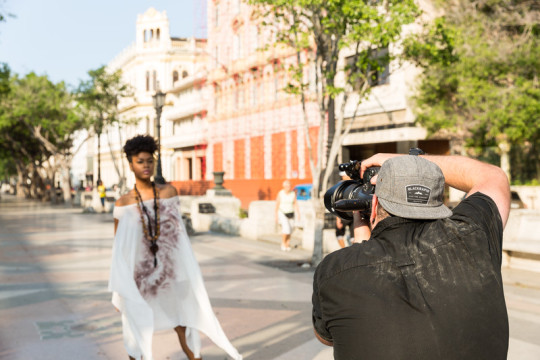




We started day-two before sunrise. I wanted to go above and beyond the production requirements and capture some really engaging portraits of the Cuban people. So, we hit the shoreline to capture some of the fisherman along the Malecón as the new day sun hit their backs. We brought along $100 in cash, the Profoto B2 Kit and the Photek Softlighter. The fishermen were gracious and open to a photograph. Of course, it made it easier when we handed them 10 Cuban Pesos, which is about what they would make for a full day of fishing. We ended up walking about 4 miles down the Malecón back to The Atlantic just in time for a quick breakfast with the crew. They had no idea Zach and I had left, alone.



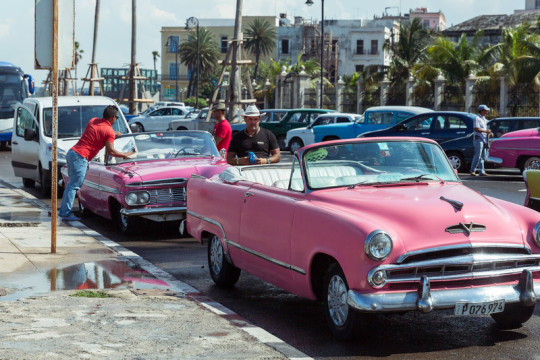

We were faced with a serious technical issue right out of the gate. The tether completely failed due to a bad cable and we had no backup cable to spare. Fortunately, the Phase One IQ250 provides a wireless tether and allows connection to Capture Pilot on an iPad. Despite the problem, we breezed through the day knocking out set after set. I was challenged and put in a few uncomfortable scenes, but that unrest is needed and is very normal for a shoot of this magnitude. I wanted to keep the look consistent and have the model in hard light for every shot. But, I soon found that to be an impossibility with the movement of the sun and the sheer amount of looks we had to capture. My intuition kicked in and I lit a few sets softly, which provided a nice contrast to the other images in the editorial. It’s a melting pot of style, which is very similar to the fashion and culture of Cuba.



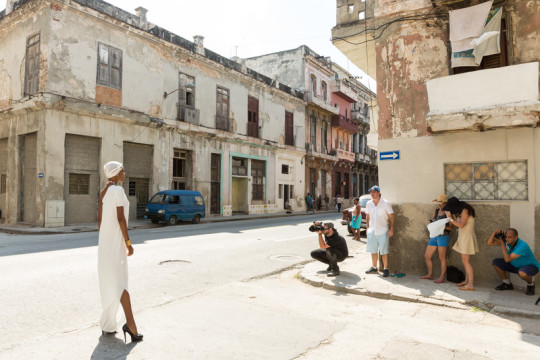
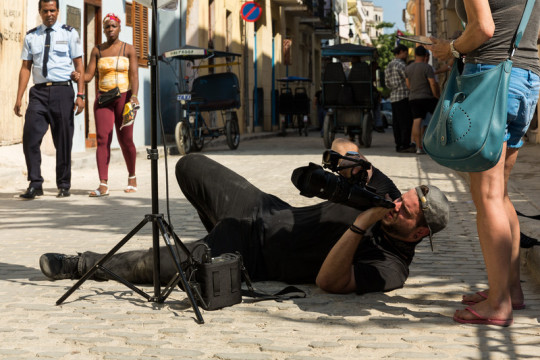
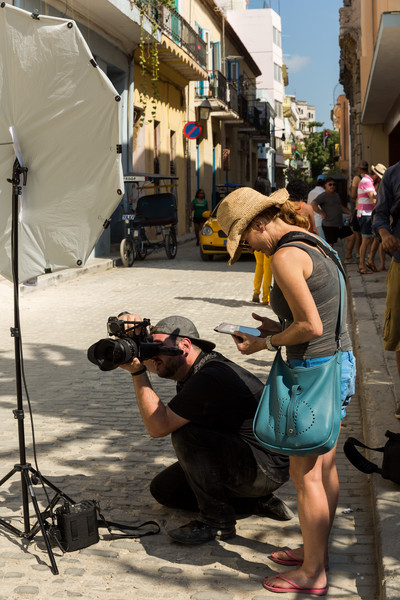

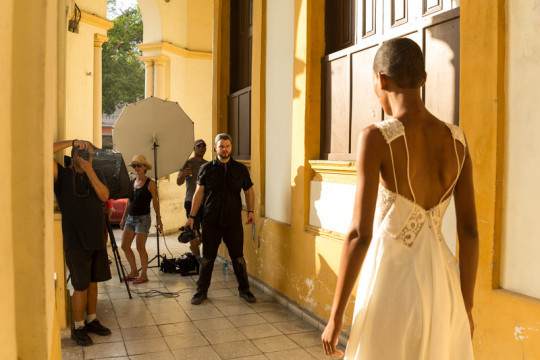


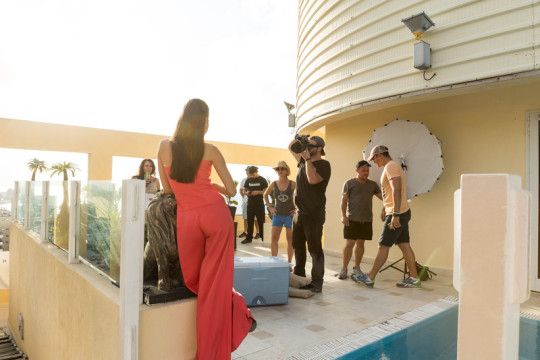

With the final look, we had ran out of available locations. We made an about-face and decided to shoot on the rooftop of The Atlantic. As the sun hit the horizon, the beautiful María Karla Herrera leaned against a gold lion statue to perfectly frame her body against the skyline. I snapped the shutter and we had our cover and the production was a wrap. My body felt like it had been in World War III and my mind was burned. It was a bittersweet moment.
We celebrated the wrap with a late-night party on the roof with all the models, designers, hair stylists, makeup artists, assistants, government officials and advisors. While others cashed out early to catch our early flight, I celebrated into the cool night. The flight home was quiet, sobering and almost sad. I was happy it was over, but upset to be leaving Cuba and all the friends I had made. Cuba is changing day-in and day-out, but I think Cuba changed something it me. It was a breath of fresh air and opened my eyes to how much I truly love photographing people and the art people create. I’m incredibly blessed to have that privilege, every single day.


A very special thanks to the team that made "La Mirada de Belleza" possible.
Photography: Clay Cook
Photography Assistant: Zach Erwin
Additional Processing: Jordan Hartley
Publishing: Jonathan Blue, Tracy Blue
Creative Directon & Style: Lori Kommor
Cuba Director: Jorge Luis Fria
Production: Clarissa Perez, Anotnio Hernandez, Jessie Fraga, Grises Esobar
Production Assistant: Juan Reffreger, Rob Penta, Cordt Huneke
Finance: Anarlyn Olivia, Ivo Zuaznavar
Style: Leo Leon, Oscar Gonzalez Puildo
Style Assistant: Yeny Rodriguez, Barbara Giselsa Rodriguez
Designer: Jacqueline Fumero, Jose Luis Gonzalez, Juan Carlos Lopez, Carmen Flot, Roly Rius, Emiliano Nelson, Mario Freixas, Emiliano Nelson, Ismael de la Caridad
Model: Laura Pupo, Laura Ortega, Jorge Perez, Ivis Gonzalez, Maria Karla Herrera, Miguel Gonzalez, Yessica Borroto, Naivys Fernandez
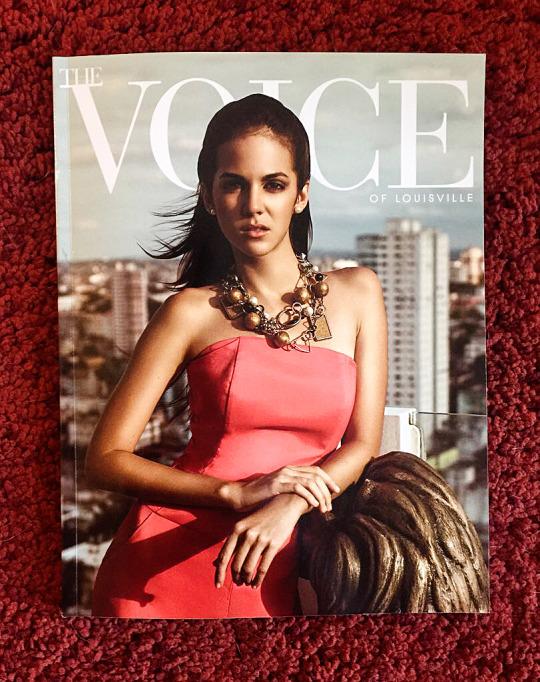

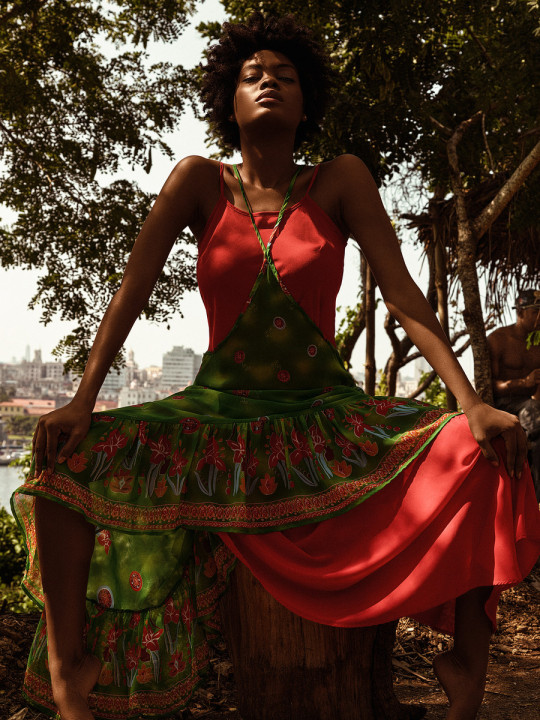
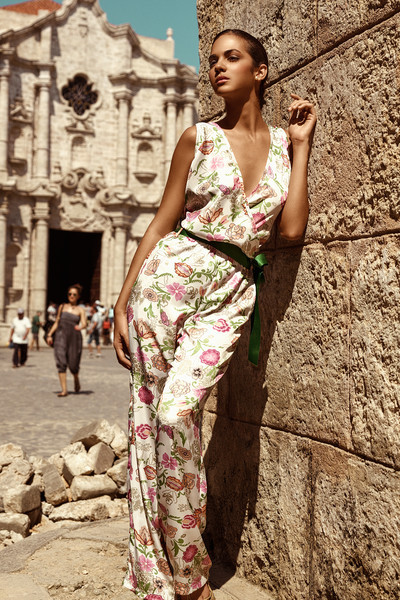

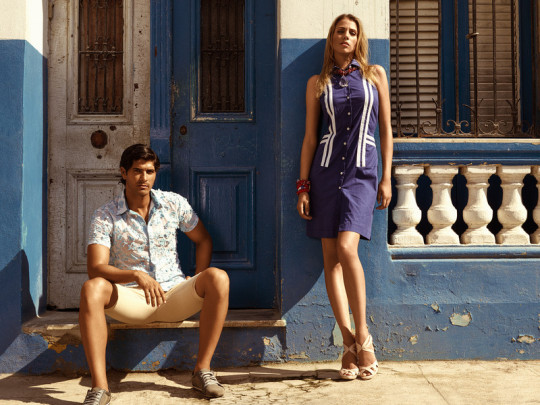
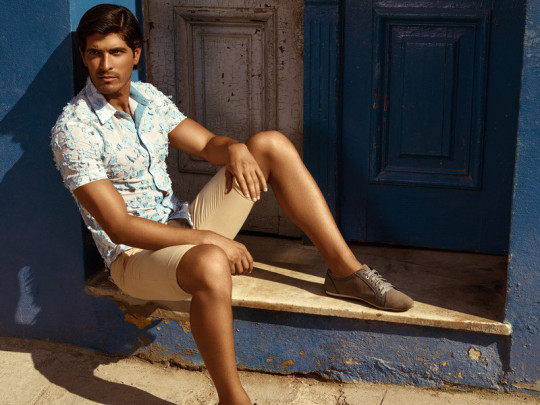



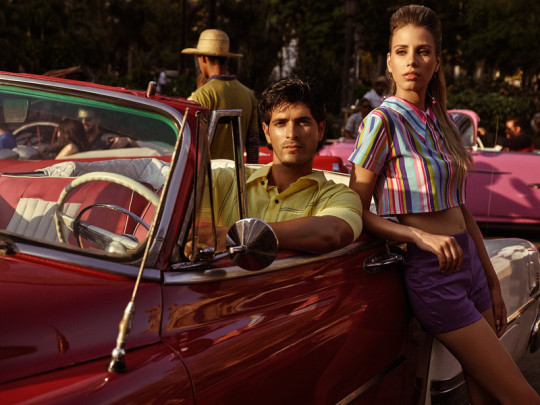
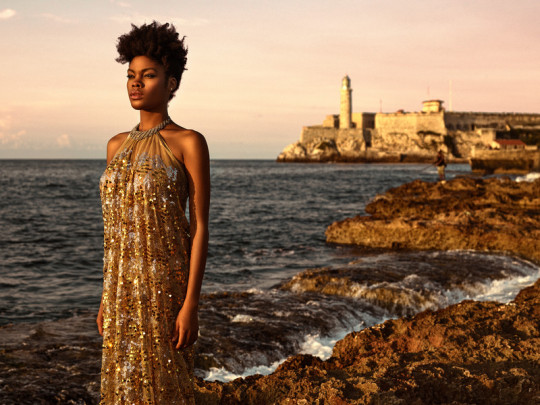




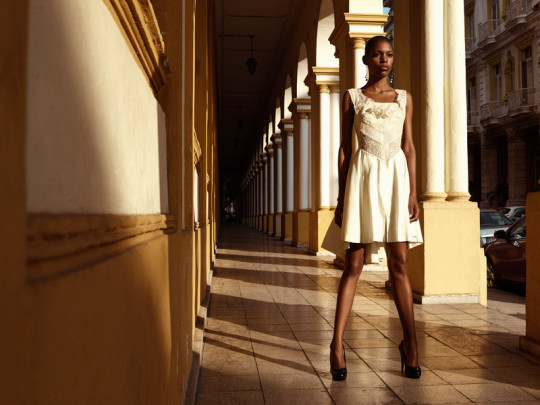

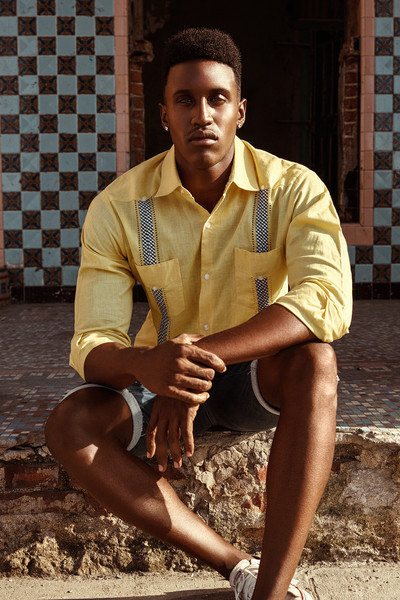

#cuba#cubafashion#fashionphotography#claycook#claycookphotography#thevoiceoflouisville#louisville#kentucky
5 notes
·
View notes
Text
INDIA
I always seem to start these posts with a philosophical statement or an excuse on why it’s been so long. At times, I’ll look at my watch and wonder where the day has gone. Other times, I’ll sit; staring at a blank document hoping words will magically appear. Being a full-time photographer requires consistent hard work and energy when you have no stamina to give. When I think of my travels through India, my brain and body feel an instantaneous exhaustion. It’s not easy to push out a post of this magnitude when the experience was a narrative of tremendous strain, pressure, beauty and elation. Although, I’m relieved to be in the comfort of my own home, I can’t help but think of the people that still live in that rabid environment and extreme culture every single day. I could describe every point and highlight of our travels and production, but I’ll let the images tell the story. After all, that’s what I do. I’m a creator and image maker. I take a vision or moment and bring it to a tangible state of living.
Dr. Ananthi Jebasingh is considered the modern day Mother Theresa of India. She has saved the lives of thousands of children all across the slums of New Delhi, India. She started her school in a public toilet with 5 students and now has over 5,000 students in several locations. Her school “The Good Samaritan” is headed by a foundation called “The Friends of the Good Samaritan.” This foundation partnered with my friends at Nadus Films to provide a narrative short film that could be promoted to the West for potential child sponsors and investors. With the United States at the forefront, the content had to be warm and inviting, but also dramatic, in attempt sell a deep awareness for the trouble that has developed in New Delhi, India over the course of hundreds of years. Over population and financial struggles have sent the public into a downfall of poverty, serious health concerns and unlawful living conditions. Along with the short film, our job was to capture it all; the good, the bad and the ugly.
youtube
Fortunately, the flight to and from New Delhi was relatively painless. It was the longest international flight I had ever been on; it was also the most comfortable. I traveled light once again; I packed all my personal effects such as clothing, health kit and bigger items such as my 3 Legged Thing Monopod and a 46” Photek Softlighter in my checked baggage. I carried along my Canon 5D Mark III, Sony A7II, multiple lenses and Profoto B2 Location Kit in a Think Tank Photo Airport Security then stuffed my laptop, chargers and accessories into my Swiss-Army backpack. I carried a heavy load, but I felt it necessary to protect my equipment with my life, I will never trust international customs. Upon arriving, we were immediately taken aback by the extreme humidity and heat. It was like a punch to the gut and a gallon of salt-water thrown on your face. Then, walking into our living quarters for the production, we were pleasantly surprised by the atmosphere, it looked somewhat clean, but pitch dark and zero accommodations such as no working internet connection, no air conditioning and no food. Welcome to India.
Albeit, we had booked in the most secure and pleasant hotel in the area, we were still located in the poorest outskirts of New Delhi. It was a struggle to communicate with the hotel staff as they resembled a 17-year-old American teenager who was working at Subway after school for side drug money. Over the course of the next two weeks it was a constant battle to receive what they considered luxuries and we considered daily life. Cold showers and late-night rooftop cigarettes were a blessing in disguise. Beers had to be fetched from a local market.
The first few days of production were tough; every morning was similar to a military man prepping for battle. We figured out what to wear, what gear to travel with and what headspace to be in. As soon as we stepped foot on the ground the sweat beads began to form and soon enough; our clothing would be completely soaked from head to toe. The front glass element of our lenses required at least 45 minutes to acclimate to the brutal humidity that the monsoons brought forth.
Our production began in the heat of it all; the slums. The poorest classes of people are known as "The Untouchables." These people live in small concrete fortifications, literally on top of themselves. These slum shelters are completely illegal, but are guarded by the Delhi mafia who pay off select government officials who allow the landlords to operate these incredibly unsafe domains. The slums were rough; the smell resembled a mildew rag soaked in fresh vomit, microwaved and thrown into a toilet of hot curry. The heat and rain didn’t help. The quarters were extremely tight and when our crew arrived, you would have thought Elvis had shown up; people flocked to witness the production. People gathered by the dozens and in the marketplace, people gathered by the hundreds.
Amidst, all the trash and illegality of the slums lived a series of schools. And, it was clear; “The Good Samaritan” is the highlight of each and every student’s life. The main branch is a giant building, similar to a hospital with dozens of classrooms and hundreds of students. The textures tell a long history of battle and many different owners. In contrast, the second location is nestled into small living space with a small group of students, settled right outside the Dakshinpuri slum. The third location is on the outskirts of Delhi and is a standalone building consisting of a few classrooms, an open toilet and two offices. This location also hosted the Christian church, where many students and teachers would worship every Sunday for several hours. Photographing Dr. Ananthi Jebasingh was a true honor and privilege. Her quiet demeanor and warm personality shine through the photographs and her leadership is a staple for the schools and children that attend those schools.
Throughout our journey and production, I had days where I had to squash the feeling of sickness and keep pushing through the sweat and tribulation of the day. Even on off days; through the Taj Mahal in Agra, the Camel excursion through the base of the Neemrana Fort in Rajasthan, the sudden monsoon at the Jama Masjid Muslim mosque and even the late night celebrations at the Underdoggs Sports Bar… it was a quest for adventure that took strength and will to experience.
At the end of our production, we had the freedom to travel to various cities in the continent; we choose the beautiful Darjeeling, India. Known for their spectacular Himalayan views, fresh tea and unique oriental culture. Right at the base of Mount Kangchenjunga, the third highest peak in the world, Darjeeling was by far the most incredible city I’ve ever seen. The trek required a quick plane ride to Bagdogra, India then a three-hour commute by truck. We were relived when we finally arrived to our final destination. Our mountian-side hotel was quaint with a spectacular view. We fought mildew and damp sheets ever night, but it was all worth the rich adventure. On the third morning, we trekked up to Tiger Hill in attempts to catch a glimpse of the Himalaya mountain range. As the clouds loomed over and the sun peaked through, Mount Everest shows its face for the first time in over 15 days. A Buddhist woman began to worship and sing enchanting songs of praise. It was a moment I will never forget.
On our final day in Darjeeling, security was at an all-time high due to India’s Independence Day and people were wild in celebrations. We decided to take advantage of the holiday and cross the border into Nepal. With the bribe of two Military leaders, we were given the opportunity to cross and grab a quick warm beer. Although, our passage was short-lived, it was completely worth the trip through the ancient-tropical-leech-invested Sukhiapokhri Forest.
Every day presented a new challenge and a new life experience. I’ve seen things that not many people have the opportunity to see and I’ve visited sites that represent a solid mark in my ever expanding career. This trip was a marker point on the road map to being the man and photographer I want to be. As I took my seat on the plane home to the states(after four insane security checkpoints) I felt more inspired than ever to accomplish my personal and professional goals and felt a breath of pure happiness, something of which I have not felt in quite some time.
Coury, Reid, Justin and I couldn’t have done it without the help of some very important people on the ground, such as our wild driver Bitu, our translator George and our guide Sharon. Thank you from the bottom of my heart for making this wild undertaking such a grand success.
#india#delhi#newdelhi#agra#adventure#nadusfilms#claycook#claycookphotography#claycookindia#experince#travel#production
0 notes
Text
TANZANIA
I’ll be honest; I haven’t been inspired to write much this year. I was hit with a few personal hurdles early in the year and I decided to take this year to re-align with myself and really start improving my lifestyle. It started with my health and wellness both physically and mentally. I knew it would be a year of personal growth, but when I stated I was truly blind to just how much growth I would achieve through life experiences. Although my career has never really slowed down, I’ve finally began to balance life and career. I’ve never been happier.
If you could describe my travels thorough Tanzania, Africa in one word; indescribable. It was the adventure of a lifetime and I’m blessed that I was able to visit such a beautiful country. I can’t go into every detail, but I can highlight some of the more memorable moments over the course of seven days.
Several months ago I was approached by Coury Deeb of Nadus Films to head over to Tanzania, Africa with director of photography, Justin Gustavison, to capture production photography for a short documentary. The project; the Waterboys Initiative. A non-profit foundation that builds water relief wells in rural villages all over the country of Tanzania. Waterboy Inititive was founded by Chris Long of the St. Louis Rams and to promote the foundation he brought on Doug Pitt (Goodwill Ambassador Of Tanzania), John Bongiorno (President, WorldServe) and Nadus Films to build content to be pushed through the NFL and various other major contributors. The content is to raise awareness as well as to gain the attention of more celebrities, players and investors.
Logistically, this trip would be an adventure and a lot packed into a short amount of time. We had to be prepared for any circumstance and any scenario that was thrown in our lap. I spent a full day prepping my camera and lighting kit to be completely portable and low profile. With my ThinkTankPhoto Airport Security, I packed a Profoto B2 Location Kit, Canon 5D Mark III, Sony A7II as well as lenses and every accessory I could possibly need in the African bush. Luckily, our friends at B&H Photo and Profoto stepped in to sponsor our travels, so we had the right gear to tackle the job.
youtube
vimeo
WEATHER DELAY
I knew this wouldn’t be a quick flight over to Tanzania. But, what was supposed to be a 24 hour trip turned into a two day adventure to make denature times, all due to weather. Unfortunately, we were grounded in Atlanta for a day with none of our luggage. I seemed to remember complaining about the absence of my toothbrush, when I realized I was about to head into a culture where a toothbrush may be a considered a luxury. I’ve never actually had to pull a “Home Alone” and run full speed through an airport until this trip. Myself, Coury and Justin took a full sprint from one end of the Amsterdam airport to the other end to catch our flight to Kilimanjaro. Flights are never comfortable; 9 hour flights are especially uncomfortable. I seemed to hit a wall and became very ancy after the third movie hit the credit roll. It’s impossible for me to sleep on a plane, so stretching near the bathrooms and giving my legs some “exercise” was the only remedy from the insanity.
When we arrived to the Kilimanjaro airport and made it through customs, we all lit up a celebratory cigarette, it was the best smoke I’ve ever had and I don’t smoke. The air was fresh and there was a energetic aura among us. We we’re driven to the Mount Meru Hotel in Arusha, Tanzania by a private guide. The hotel was incredibly swanky and nice, an extreme contrast to the world and culture on the outside.
ARUSHA MARKET
My first experience in Africa would be an interesting and incredibly hectic one. In two Safari trucks we were driven down to the local Arusha market to get in some documentation of Chris Long and his wife Meg. We were told to keep all valuables and jewelry secured and safe. As soon as the car hit park, we jumped out of the truck first. Suddenly, we were mobbed by a large crowd of people, who were either attempting to sell and barter or simply made money by being a translator or guide. Luckily, our drivers could translate Swahili for us and directed us to the right people. The market was beautiful, rich and colorful. The culture was fruitful, vibrant and loud. As we made our way through the nooks and crannies of the market I was snapping the shutter like a madman, I couldn’t keep up with the photographic opportunities, it was overwhelming. I did my best to focus on the project at hand, that being Chris Long, but my eyes constantly wandered to the better subject matter.
VILLAGE IN THE DUST
I didn’t exactly ever know where we would land hour after hour. I suppose that was the thrill of it. I knew we were heading to a remote village, but I wasn’t truly aware of how remote. When we pulled off the main road and started driving into a desert with no roads, I knew this was the adventure we had asked for. This path was rough and extremely bumpy; it could make someone with a steel stomach feel weak. About an hour of winding through trees and dust we arrived to people running from one end of the village to the other in an extreme dust storm. It was the most incredible sight I have ever seen. Out of the dust emerged a indigenous people who treated us like celebrities. We immediately got to work and I began snapping away. The dust added a compelling element to every single shot. It was excessive and overwhelming, but it opened visual opportunities we couldn’t pass. We finished the day with a quick 30 minute photoshoot, where I did my best to capture the emotions of Chris, Doug and few of the Maasi. It was a time- pressure situation, but I prevailed with some great imagery. We hopped in the truck and high-tailed it out of the village before sunset, at which time traveling becomes very dangerous.
SAFARI
Even though we had a mission and clear objectives, the most exciting portion of the trip was the Safari. I really didn’t know what to expect. People from all over the world pay thousands of dollars to experience an African safari and here we were. It felt like something out of Jurassic Park, just waiting to see a monster appear out of the century-old-trees. We didn’t have to look far. Giraffe, Elephant, Water Buffalo, Wild Boar, Baboon, Flamingo, Zebra and many more species of animals casually enjoyed their natural habitat. Needless to say, I’ll probably never look at a local zoo the same again. It was a rush and thrill to be in this environment with so many incredible animals that were only feet away.
KILIMANJARO
During our stay in Arusha we happen to meet Adrian McCrae, an Aussie risk-taker who enjoys hang-gliding of mountain tops. Adrian is also an extremely charitable person. We were extremely interested in his stories, so much so he arranged a quick flight up to the summit of Mount Kilimanjaro, one of the seven tallest summits in the world. Mount Kilimanjaro is 19,000 feet above sea level and Mount Everest is 24,000 feet above sea level. Only hours before our flight was schedule to head back overseas we jumped into a 4-seat Cessna plane that was smaller than my Nissan. We opened the windows and took off. I was actually quite nervous, the last time I was in a plane that size I had paid to jump out of it (skydiving). It took roughly 30 minutes to reach Kilimanjaro and we did several passes. It was freezing, the temperature had dropped some 40 degrees from sea level, not to mention wind chill. I was able to maneuver a few shots of the summit through the open window. After a few moments tipping the wings we headed back down to the ground and I was relived upon touchdown.
I wish I could do into more detail of each and every moment spent in Tanzania. The people are beautiful and so is the landscape, they make it easy for a photographer like myself. Even though most of the people of Tanzania have probably seen a camera, they are still completely enthralled with the technology. And, they just stare into the lens. I hope I have the opportunity to return one day, but this experience will be something I’ll never forget.
“The very basic core of a man’s living spirit is his passion for adventure. The joy of life comes from our encounters with new experiences.” – Christopher McCandless
1 note
·
View note
Text
VEGAS IMPROMPTU - FIREFLY
If there is one takeaway from my week in Las Vegas this past month, it’s the Gangnam Asian Barbeque. I’m only half-joking! In reality, WPPI reenergized my love for impromptu production and imagery. I’m so numb to the call sheets, clothing and overall client expectation. It was a breath of fresh air to do something completely off the cuff and on your own terms.
While the east coast was getting slammed by a snow storm, myself and my assistant Jacob were officially stuck in Las Vegas, with no plans or no events to attend. Our flights were just cancelled, with no warning or delay. The first available flight back wasn’t until two days later. So, instead of sulking in our hotel room, we decided to take advantage of the extra hours in Las Vegas. Along with our friend David Crewe from Phlearn, who decided to stick around as well, we began the planning process for an edgy editorial out in the desert hills. I scoured Pinterest and Google Images for about 10 minutes and found the direction I wanted to head. As we headed off to the Asian BBQ, David and I sent out the correspondence to make it happen. Shortly after, we had a model, makeup artist and a full crew of people who wanted to head out to the rocky desert landscape with us.
The missing piece was styling, so we asked our model to bring what she could and we would fill it out, even if we had to purchase clothing and return it. Which is exactly what happened. We had all the right pieces for an edgy wardrobe, but it was missing the most important facet of all; a long coat or jacket. After, the crew met and hit the road in two cars, we made a quick stop by Burlington Coat Factory and we had our model, Taylor, try on several different selections. Although the green military jacket was a winner, we decided it better to be safe and stick with the long black coat.
With wardrobe and some accessories in place, we headed out to the very end of Las Vegas Boulevard, where we were met with a massive landscape of desert hills that overlook the city. The weather was perfect and I even enjoyed the strong wind. At first glance, I thought I would be breaking out a strobe, but the natural sunlight was low and beautiful. I decided to shoot only natural light, which I something I hadn’t done in quite some time. I loved the look of the hard sun light against the dark styling.
With little fashion experience, our model Taylor did a great job with direction. We starting with walking and movement and went into more posed structured imagery. We only had about 30 minutes with Taylor, so we moved quickly and efficiently. Once I had my shot, I bowed out and let some of the other shooters on set take a stab at it. I guess you could say it was an easy day, a stark contrast from the previous experience at Red Rock Canyon. It was a real pleasure being in such a beautiful place with such talented and friendly folks. Although, you could consider the extra hours in Las Vegas an added expense, the impromptu shooting certainly made it all worth it.
youtube
1 note
·
View note
Text
Against All Odds - Profoto B2 Review
In my short few years as a photographer, I've been lucky enough to see a lot of things that many do not have the ability to see. On the same token, I've also been in quite a few perilous weather situations fighting the odds. In this profession, there are so many positions and people involved to capture a professional advertising campaign, re-scheduling due to weather costs a lot of money. So, it's my job to take what's given and make lemonade from a lemon. In other words, I make it work.
During my stay in Las Vegas for WPPI (Wedding & Portrait Conference and Expo), I met with David Crewe of the educational brand Phlearn to discuss a fun and laid back photoshoot in Red Rock Canyon. 24 hours later, we had a beautiful model Nanako Hawley, a gorgeous parachute dress from Lindsay Adler and Dream Shoot Rentals and the brand new Profoto B2 system which had only been introduced hours before.
I had no inclination of how to use the system and to be honest, I was quite skeptical. I have been a loyal Profoto user since 2012. I love my D1 500 set and when Profoto introduced the B1, I was floored and was definitely into it. Then Profoto announced the new lightweight B2 head and pack. I was excited, but was disappointed when I saw the native battery pack and looked at the power specifications... it was only 250w/s.
That skepticism all changed when we left the canyon.
As we came over the ramp and looked out to the top of the canyon we could see some severe cloud cover. I was worried, but ready to face the elements. Once we entered Red Rock Canyon and began to drive up the mountain, we soon realized we were in for a real treat. The cloud moved overhead and we started to notice small pellets of ice smacking the window. Before long, we were trapped in a dramatic hail storm with freezing winds and soaking wet conditions. But, we weren't giving up. Once we reached out destination and setup, we realized that this would be a very short shoot. The temperature was near freezing and the wind was strong. A stream of rain and hail continuously beat down on us.
Despite the nasty conditions, we dove in and began snapping shots with little zero testing and pre-lighting. I fumbled around with the Profoto Air Remote and the B2 Battery Pack until I found a suitable setting. But, by the time we pinned the dress and began getting what we wanted the beautiful mountains had completely disappeared in cloud cover, I knew we had to move. After a brief second set, I called the shoot and we headed back to the car. We could barley feel our hands, I was covered in mud and Nanako needed to get warm. For the first time in a long time, I was disappointed and felt completely inadequate. I didn't have time to acclimate to the B2 system and the weather had just got the best of us.
We packed our gear and hit the road with full intention of leaving the canyon. As we headed out and down the mountain, the hail had stopped and suddenly we hit a patch of dry area. I asked to stop the car and capture another quick set, luckily everyone was on board. I was ecstatic. We unloaded and began breaking out all of the gear. Our clothes were soaked so we striped off our wet jackets and hung them over cacti. The sun was slightly peaking through the clouds and I had a beautiful clear background; I could finally relax and enjoy the shoot.
The Profoto B2 Kit turned out to be a lifesaver for myself and my assistant Jacob. The B2 head is about a third of the size of a B1 head and it weigh's less than a Canon 600EX-RT Speedlight. The battery pack is about the size of a macaroni and cheese box and weighs much less than a Paul C Buff Mini-Vagabond or any lithium battery pack. The portability and quick-to-setup system helped save time and gave us the ability to move sets with zero hassle. I shot most of the images at half power which was plenty for a nice balance of ambient and artificial. The pack was easy to use and navigate as the buttons are clear and simple. Since the B2 head was running on battery, I was worried about the recycle time and potential misfiring. Well, there was zero recycle time and I didn't have one single misfire. Call me impressed.
Near the end of the shoot, I started messing around with the Air Remote controls and my camera settings. Almost instantly, I figured out how to achieve High Speed Sync and suddenly the game changed for me. I was able to bring down the ambient level of the sky and still maintain my depth of field. I captured every shot at 1/1000 shutter speed. This was my first time ever using High Speed Sync and it's everything I've ever wanted in a strobe and more.
Finally satisfied and confident with the results, we packed up and hit the road back to the Vegas strip for a hot shower and a cold beer. Excitement was in the air and both my assistant Jacob and I were enthralled with the B2 system. My skepticism had been left at the canyon. The Profoto B2 system is real deal. if you need proof, just scroll down and watch.
Special Thanks to Chris Fain with Profoto, Lindsay Adler with Dream Shoot Rentals & David Crewe with Phlearn for all the help and assistance with making this shoot happen.
youtube
#clay cook#profoto b2#red rock canyon#fashion shoot#dream shoot rentals#lindsay adler#phlearn#first person shooter#behind the scenes
3 notes
·
View notes
Text
Under Pressure
As a photographer, my skill set is constantly put to the test. In most cases I'm handed an idea on a slab of wood and the mission is to hand that idea translated to a tangible artifact back to my client on a silver platter. It's never an easy process, but it's apart of my job. I've shot in water maybe half a dozen times and I love it, I love the challenge and I love doing something different. The idea brought forth by makeup artist Casey Ritchie was to shoot a model in black murky water, with only the face to be seen and the makeup as the stand out.
The first step was to think of a way to shoot this idea in a studio setting. The only way I felt it could be accomplished was with a simple kiddie pool, rather then using an indoor pool or bathtub, where it would be trouble to rig lights safely. We placed the kiddie pool right on the studio floor and filled the pool with warm water, then draped a black cloth background over the pool and in the water. The next hurdle was lighting and camera placement.
Fortunately, I have a lot of experience with booming my camera for a 90 degree overhead angle without the used of a ladder or crane. So, we secured a Canon 5D Mark III with a Manfrotto 026 Swivel Umbrella Adapter and wrapped a Vulture Equipment Works A4 camera strap around the head of the stand in case the adapter failed. I fired the shutter using the CamRanger; a wireless DSLR remote control and tethering system.The next step involved lighting the pool. Unfortunately, we could jump in the water for pre-lighting so, we had to guess and use the palm of our hands to predict how the light would fall on the face.
Canon 5D Mark III
70mm (70-200mm f/2.8L)
f/16
1/180
ISO100
Key: Profoto D1 | 8.0 Power | Profoto 20.5" Softlight Beauty Dish w/ 25° Grid
Side: Paul C Buff Alien Bee B800 | 1/4 Power | Paul C Buff StripBox w/ Grid
Side: Paul C Buff Alien Bee B800 | 1/4 Power | Paul C Buff StripBox w/ Grid
Fill: Paul C Buff ABR800 Ringflash | 1/8 Power
The key light provided a powerful dramatic light from overhead and the sole purpose of the side lighting was to add some beautiful catch lights in the models eyes. The ringflash added a directional contrast and the white foamcore reduced the shadow density under the chin and body. We triple checked for security and safety; when dealing with water, you never want to cut corners and risk a model's life.
Unfortunately, we weren't able to nail the lighting until the model was in the water; we fought with reflections and inconsistent shutter clicks, which wasn't something I had ever had to deal with. About 20 minutes in the water, our model was shivering and very cold, I knew we needed to get the shot. I made the executive decision to send for a space heater and turn up the heat in our house. Luckily, Lindsey, our model, was an absolute trooper and was prepared to do something different. She fought the shivering and braced the luke-warm water through two more looks. By the last look, we had adapted to the scenario; my studio felt like a sauna and the air approaching 90 degrees.
Three looks later we had the shot we needed and I could tell our model was relieved. We carefully broke down the lights and emptied the pool bucket after bucket. I wasn't handed an easy scenario, but I certainly think we delivered a photograph worthy of a silver platter.
#clay cook#clay cook 2014#claycoookphotography#claycookphoto#water beauty#underwater beauty#water makeup
11 notes
·
View notes
Text
GEAR HEAD
Location Gear Kit
Manfrotto 420B Combo Boom (5)
Manfrotto Swivel Umbrella Adapter (2)
Avenger A2033FCB 10.7' C-Stand (Black) (2)
Avenger Grip Head (2)
Standbagger Original Roll Up Model 13
Extension Cable And Storage Reel (2)
Tether Tools Tether Table Aero Master
Avenger G100-1 Sandbag (12)
Matthews Apple Box Full (2)
Matthew Apple Box Half (2)
Paul C Buff Grid Set (2)
Paul C Buff Alien Bee B800 (4)
Paul C Buff ABR800 Ringflash Unit
Paul C Buff 47" Foldable Octabox
Paul C Buff 35" Foldable Octabox And Grid
Paul C Buff Foldable Stripbox (2)
Paul C Buff Mini-Vagabond Lithium Portable Power Pack (2)
Profoto D1 500W/s (4)
Profoto 20.5” Softlight Beauty Dish | Sock
Profoto Softlight 25 Degree Grid
Profoto 2’x5’ RFI Softbox
Photek 46” Softlighter II
3 Legged Thing Frank Carbon Fiber Tripod System
3 Legged Thing Jack Magnesium Alloy Tripod System
Rock N’ Roller Multi-Cart R10RT
Rock N’ Roller Multi-Cart Expandable Shelf
A-Clamp (5)
Stanley 24 in. Pro Mobile Tool Box
Stanley 37 in. Mobile Job Box
Stanley 65-Piece Homeowners Tool Kit
Westcott 5-In-1 Reflector (4)
Lastolite 3’x6’ Skylight Rapid Kit
Lastolite 6’x6’ Skylight Rapid Kit
Midland Two-Way Radio (4)
Savage Universal Seamless Backdrops
Oliphant Studios Canvas Backdrops
Camera Kit
Think Tank Photo Airport Security V2.0
Canon 5D Mark III
Canon 5D Mark III Battery Grip
Canon 70-200mm f/2.8L IS II
Canon 16-35mm f/2.8L
Canon 50mm f/1.2L
Canon 600EX-RT Speedlight
Black Rapid RS-4 Sling Strap
Eneloop Re-Chargeable AA Battery Charger (6)
Eneloop Re-Chargeable AA Batteries (24)
Think Tank Photo DSLR Battery Holder
Think Tank Photo Pixel Pocket Rocket Memory Card Carrier
Canon 5D Mark III Remote
Pocket Wizard Plus III (4)
Hildozine Caddy for PocketWizard Plus III (3)
CamRanger
CamRanger Charger
LEE Filters 4x6” Graduated ND Filter Set – Soft Transition (3)
LEE Filters 72mm Adapter Ring
LEE Filters 82mm Adapter Ring
LEE Filters Foundation Kit
LEE Filters Wide Angle Lens Hood
Tether Tools Connect Lite Mounting Bracket
Tether Tools Wallee Modular System for iPad
iPad 3
Custom Brackets CB-Mini-RC
Tether Tools 11” Articulating Arm
Tether Tools 8" Rock Solid Accessory Extension Bar
Tether Tools Jerkstopper
GoPro Hero3 Black Edition
GoPro Hero3 Battery (2)
GoPro LCD Touch BacPac
GoPro 3.5mm Mic Adapter
GoPro The Frame
Headlamp
PocketWizard Plus III PC Sync Cable (4)
PocketWizard Plus III Sync Cable (4)
PocketWizard Plus III Pre-Trigger Remote Cable
Pixel TF372 Soldier Wireless Flash Trigger (3)
Pixel Soldier Sync Cable (3)
Glass Prism
Glass Lens
Rode VideoMic Pro
Rode VideoMic Pro Deadcat
Azden WLX-PRO Lavaliere System
Overboard Waterproof Phone Case
LensPen
Standard TTL Cable
HonlPhoto Color Effects Filter Kit
HonlPhoto Speed Strap
Hoya 82mm Neutral Density Filter
iPad Charger
Apple Dock Connector VGA Adapter
iHome iDM8B Bluetooth Wireless Speaker
iHome iDM8B Bluetooth Wireless Speaker Charger
CTO Gels
Logitech UE6000 Headphones
Gura Gear Et Cetera Case 1L
9 notes
·
View notes
Text
2014 - REVIEW
When someone asks about my year, an overwhelming breath of anxiety falls over me. I tend to think of all the failures and mistakes that transpired. I sulk on the jobs that I lost or perhaps the connections I never followed up with. But, just as soon as I start dwelling on the missteps, a blast of positive reflection and extreme anticipation hits me like 10-ton a freight truck. I started my photography career in 2011 and every year since the milestones have become bigger, brighter and bold.
Although I hit a few holes, they prepared me for the mountain that I was to climb. I not only grew as a photographer, filmmaker, writer and educator but as a person. Albeit cliché as that may sound, my life went through an absolute change and I finally accomplished a life-goal that I’ve been working towards for close to 13 years.
Turmoil, emotion, adventure, elation, sweat, change, breakthrough; are all words that could describe the past 12 months. Rounding the corner to 2014, I was modest, working a full-time marketing position at a camera store to make rent, in the meantime attempting to drive harder and faster with my photography business. The balancing act was something I became used to and a tangible reality. When I was offered a position at Fstoppers.com in January, I didn’t know my comfortable living was about to shift sideways. Of course, I took the Fstoppers opportunity seriously and everything was sent into overdrive.
I traveled out of the country for the first time. My imagery was nominated for a North American Hairstyling Award. I enlisted with the agency Wonderful Machine. I hosted my first live webinar with hundreds of photographers all over the world. I became an official brand ambassador for brands such as SmugMug, Tether Tools, X-Rite and Savage Universal. I shot medium format film for the first time. I spoke to a live audience at the PhotoPlus International Expo in New York City and I shot for clients such as USA Today, Livestrong, Modern Salon, ProSales Magazine and First For Women Magazine. And, those were just some of the milestones.
In uniform with a roller coaster, this past year has had its drops, hills, turns and corkscrews. Halfway through, the ride took a swift turn and I came out the other side as a full-time photographer. I left my job at the camera store and became the career man I’ve always wanted to be. Taking the jump required every bit of bravery and strength I had, as well as a pure obsession with photography that couldn’t be stopped. Although, I could brood on the failures and mistakes that made me a better photographer, that blast of hope is what keeps the fire inside burning hot. When I’m asked about my 2015, it’s hard to say. I want to continue to educate and instill a passion in others as well as continue to grow my clientele on a national scale. I’m significantly blinded by the anticipation and eager to become even more obsessed with my love for creating, inspiring and paying it forward.
4 notes
·
View notes
Text
PHOTOPLUS 2014
I could sit here and reveal every single detail about my week at PhotoPlus Expo this year, it was an exciting ride. I met a lot of new faces and ran into a bunch of old friends. My assistant Jacob and I had a lot of great meetings and I was fortune enough to speak about my camera setup for Tether Tools at the Unique Photo Booth. It was a very busy time, talk about working hard and playing hard...
Highlights to note; our cab got in a wreck, we partied South Beach style on a New York rooftop, and even jumped around in a "bullet-time" photobooth. But, instead of breaking it all down, I'll let you soak it in with this small gallery of images Jacob captured during the week.
2 notes
·
View notes
Text
Chroma Kinetics
For the first time in my photography career, I walked into a collaborative photo shoot completely clueless. No tearsheets, no mood board, no pre-lighting, just a strong team and a small studio.
Fashion photography requires a lot of pre-production; wardrobe, hair, makeup, concept, lighting and composition. Sometime ago, I was approached by a close friend and model, Casey Neel, whom had just given birth to a beautiful baby girl. She had spent a few weeks in the gym to get back in the game and wanted to schedule a test shoot. I had been buried in commercial client work, but I jumped at the opportunity to collaborate. With that said, I contacted my friend and Project Runway alumni, Gunnar Deatherage, who was also itching to create. I also reached out to Casey Ritchie, a fantastic Mid-West makeup artist to round out the team. Collectively, we came up with a few ideas, but nothing seemed to click. I was frustrated and felt a hint of anxiety as I showed up to shoot. I didn’t know what I was going to do, nor did I know what the end result would look like.
While the model was being primped in hair and makeup, I was breaking a sweat, racking my brain back and forth for nearly 2 hours, switching backgrounds and swapping lighting scenarios. I felt dead in the water; I didn’t have a clue how I was going to light the set and didn’t have any solid direction. I was on my own. Soon enough, hair and makeup was complete and Casey changed into her clothing that Gunnar had so graciously prepared. It was a combination of high fashion sportswear and a lose-fitting ethnic garb. I loved it, but now all eyes were on me. I felt like a souped-up car that just needed some gas and an address.
I had settled on a blank, dramatic Studio Gray seamless in the hopes of potentially going black and white. I broke out of my normal setup and eventually settled for a Profoto Softlight Beauty Dish, something I rarely pull out of the closet. First shot was an absolute dud and I knew it wasn’t right. So, I pulled the plug.
Just when you thought a sinking ship couldn’t get any more dredged with water, buried in the stack of seamless paper backgrounds I happen to notice a bright blue color that was gleaming through the pile like a piece of shining silver. Miraculously, it perfectly matched the color of the headband and purse that the model was wearing. I had only used the Blue Jay seamless once, but it just seemed fitting. I asked Casey to take a quick breather and I changed the background. Burning up a second sweat, I then positioned the beauty dish accordingly and took a quick test shot… right out of the gate; we had our image. I didn’t know exactly which direction this was heading, but I liked it and I dug deeper. I worked with Casey on jumping, lunges and a slew of motions that could bring out the flare in the color and clothing. We worked, worked and worked some more. Nearly 30 minutes later we had the shot and moved onto the second look. Along with the motion shots, we captured some experimental products shots. I played with a new toy I had built several days prior; a 3-way mirrored prism. I thought it might be a great companion to the regular shots and add a more “advertising” finesse to everything.
I took down the blue seamless paper backdrop and by default rigged my hand-painted Oliphant canvas. It was the easy and comfortable move, I knew what the results would look like and I knew I could pull off a good image. But truthfully, I really didn’t know what to do next. Once our model Casey was ready to go in her second look I snapped a few shots and once again had that feeling of disappointment. This shoot needed to have the feel of an editorial. So took a step away and re-collected, then once again looked to the growing pile of seamless paper and grabbed theDeep Yellow roll. A few minutes later we were back at it and I was seeing smiles from all across the board. Everything felt right and it was the perfect accompaniment to the previous look. Once I had the shot there was no reason to continue; it was a wrap. I took a deep breath and scanned through the day’s images with a giant smile on my face. No planning, no preparation and somehow we came up with a shining set of imagery, all due to the bright colored Savage seamless paper. That was the piece of the puzzle that made it a picture.
The lesson here is that you can’t be afraid to step outside the box and experiment. When something doesn’t feel right, change it. When a lighting scenario just isn’t working, change it. When the backdrop isn’t right, change it. It took me nearly 6 seamless backgrounds and a dozen lighting setups to find the right course of action. Set yourself up for failure and you just never know what result might come of it.
4 notes
·
View notes